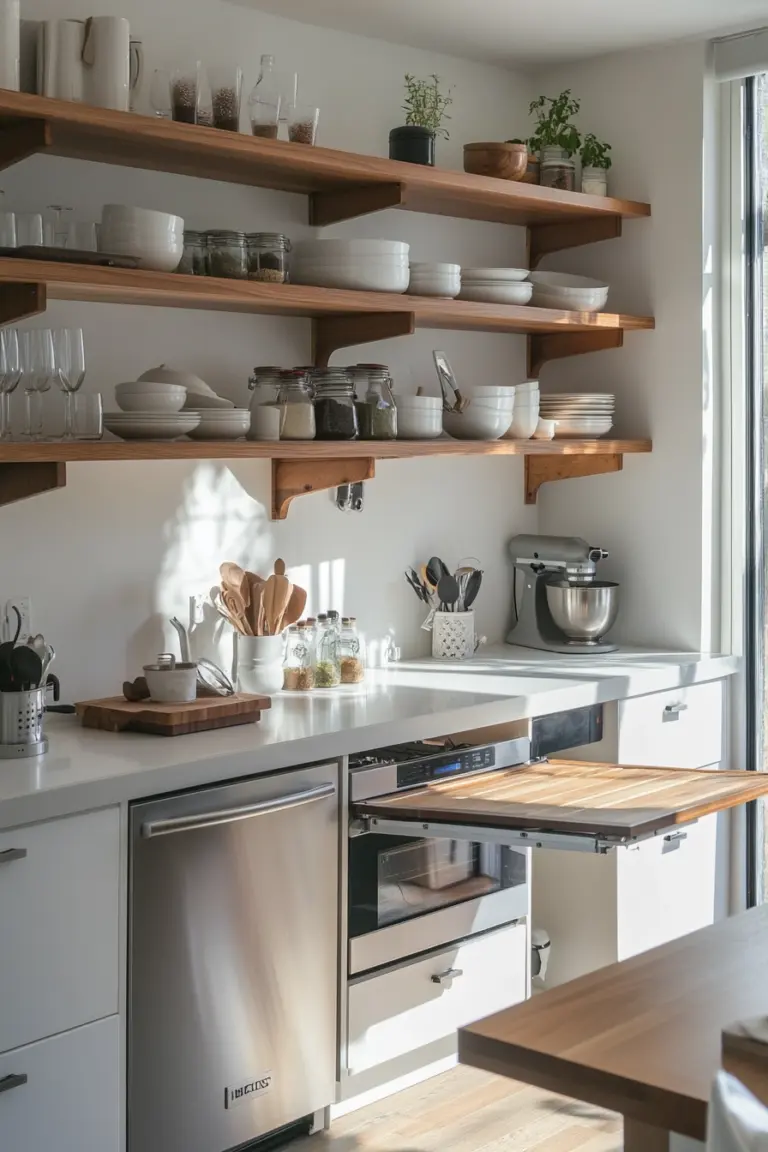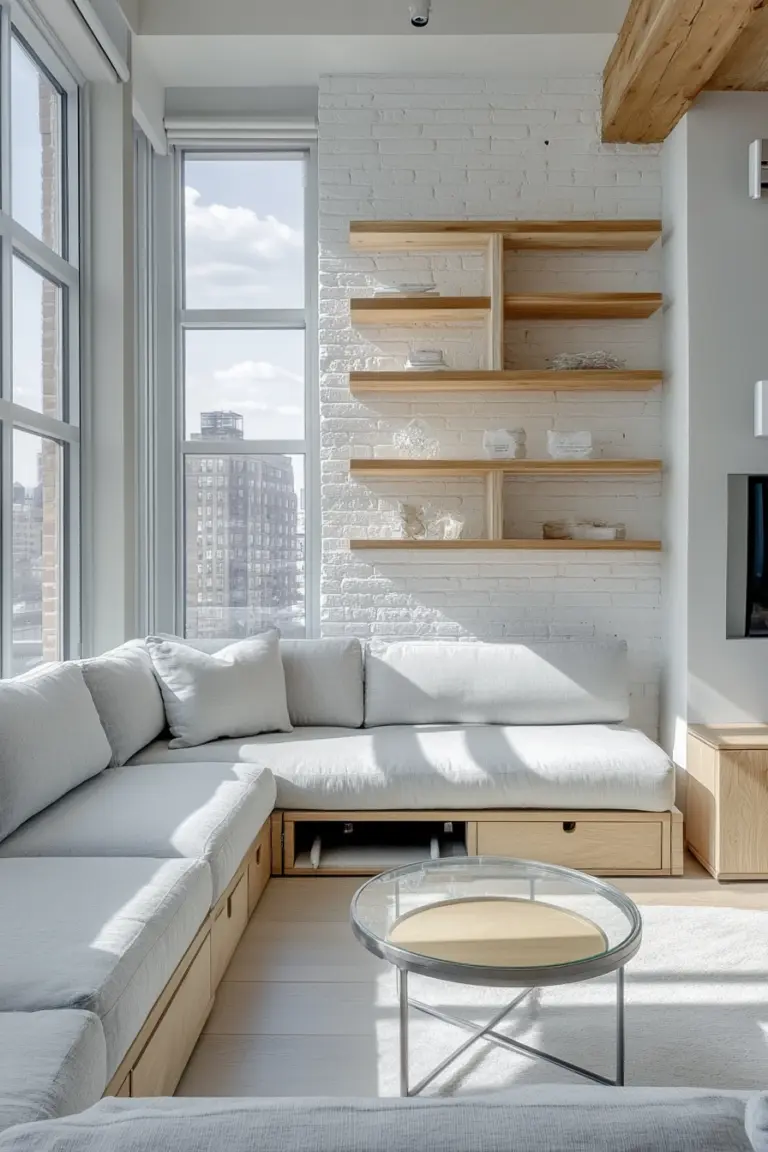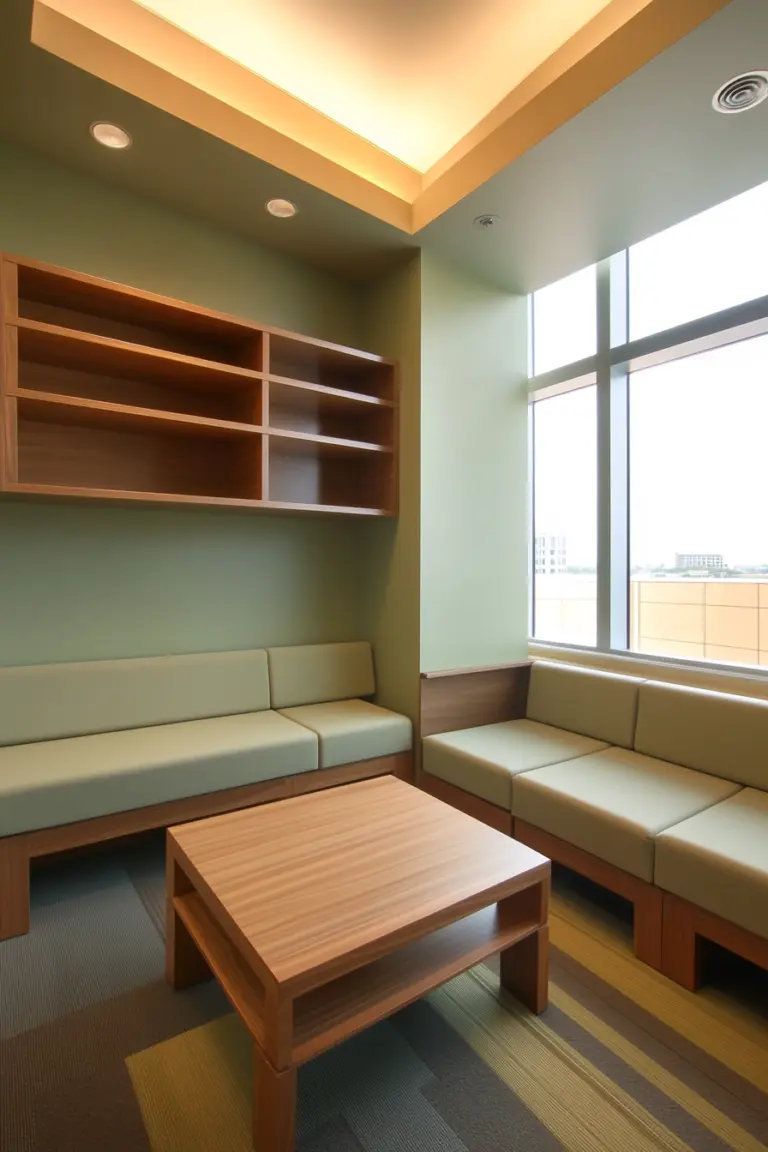Small Backyard Ideas for Kids
Creating a vibrant and functional backyard for kids is essential for fostering their creativity, physical activity, and connection with nature. Thoughtful interior design plays a crucial role in transforming small outdoor spaces into engaging environments where children can explore, learn, and play.
When combined with innovative design concepts, even the tiniest of backyards can become a sanctuary for imaginative adventures.
In this article, we will delve into twenty unique small backyard ideas specifically tailored for children. Each concept emphasizes a blend of functionality, aesthetics, and safety, catering to various interests and age groups.
From compact play zones to educational discovery areas, these designs promise to inspire not only kids but also parents looking to enhance their outdoor living spaces.
1. Colorful Wooden Play Structure
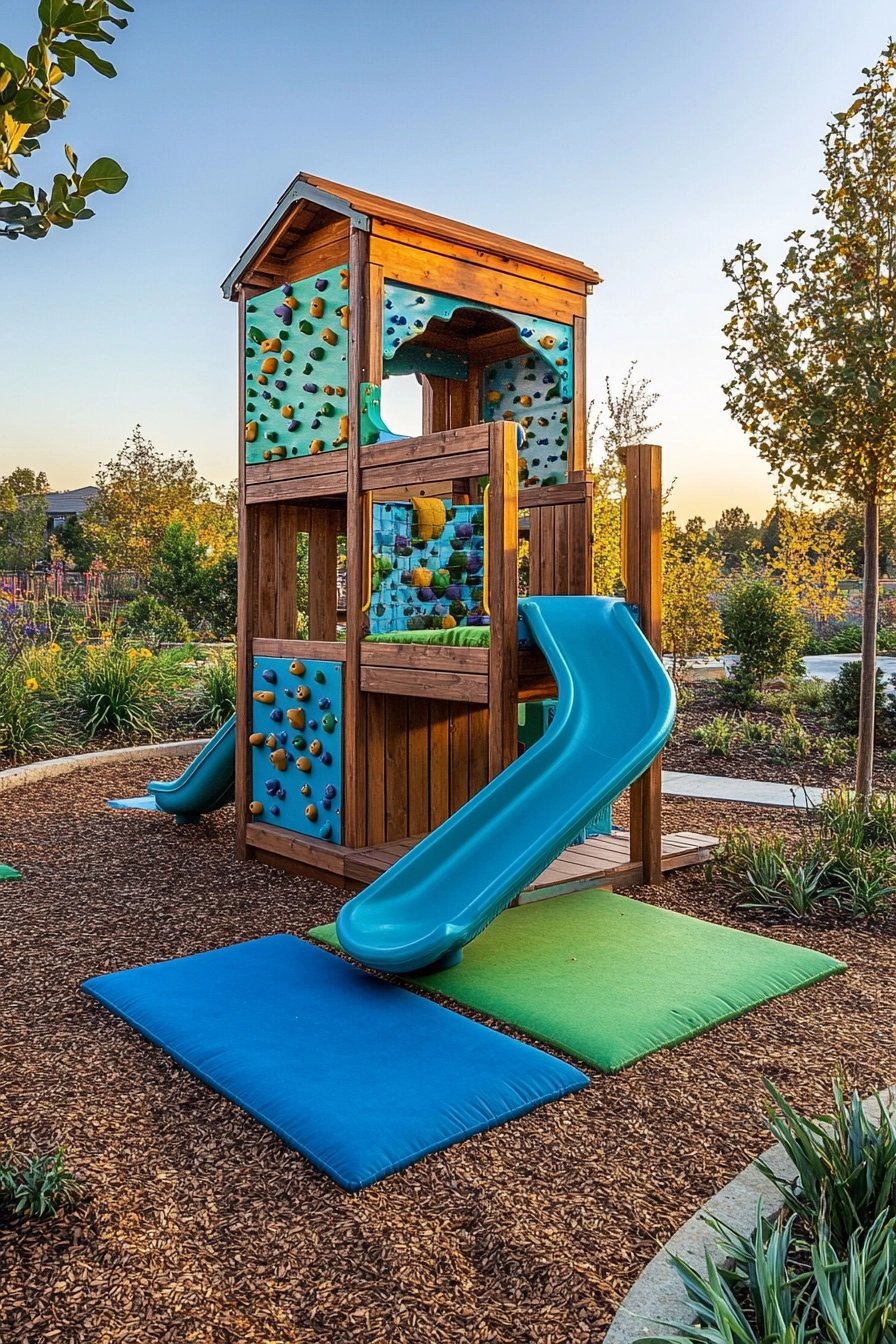

This vibrant backyard idea centers around a colorful wooden play structure that features multiple levels, an integrated climbing wall, and a slide. The natural wood tones are accentuated with bright blue and green safety padding, creating a welcoming and cheerful atmosphere.
Soft rubber ground cover in earthy tones ensures safety while giving a natural feel to the play area, making it easy for parents to relax while watching their kids play.
Surrounding the play structure, native plants and a small garden area add to the charm of the space. The design encourages children to interact with nature, learn about local flora, and enjoy the fresh air.
The play structure is strategically placed to catch the golden hour’s light, resulting in beautiful moments that parents will cherish in photographs.
- Choose durable, weather-resistant wood for longevity.
- Incorporate safety features such as padded surfaces and secure climbing structures.
- Utilize native plants to promote biodiversity and reduce maintenance.
- Design the layout for easy visibility from inside the home.
- Consider adding a shaded area with a small picnic table for snacks and crafts.
Pro Design Tip: Integrate a small water feature nearby to create a calming ambiance and enhance sensory play for kids.
Budget Consideration: Wooden play structures can vary in price based on materials and design complexity. Opt for pre-made kits for a more budget-friendly solution.
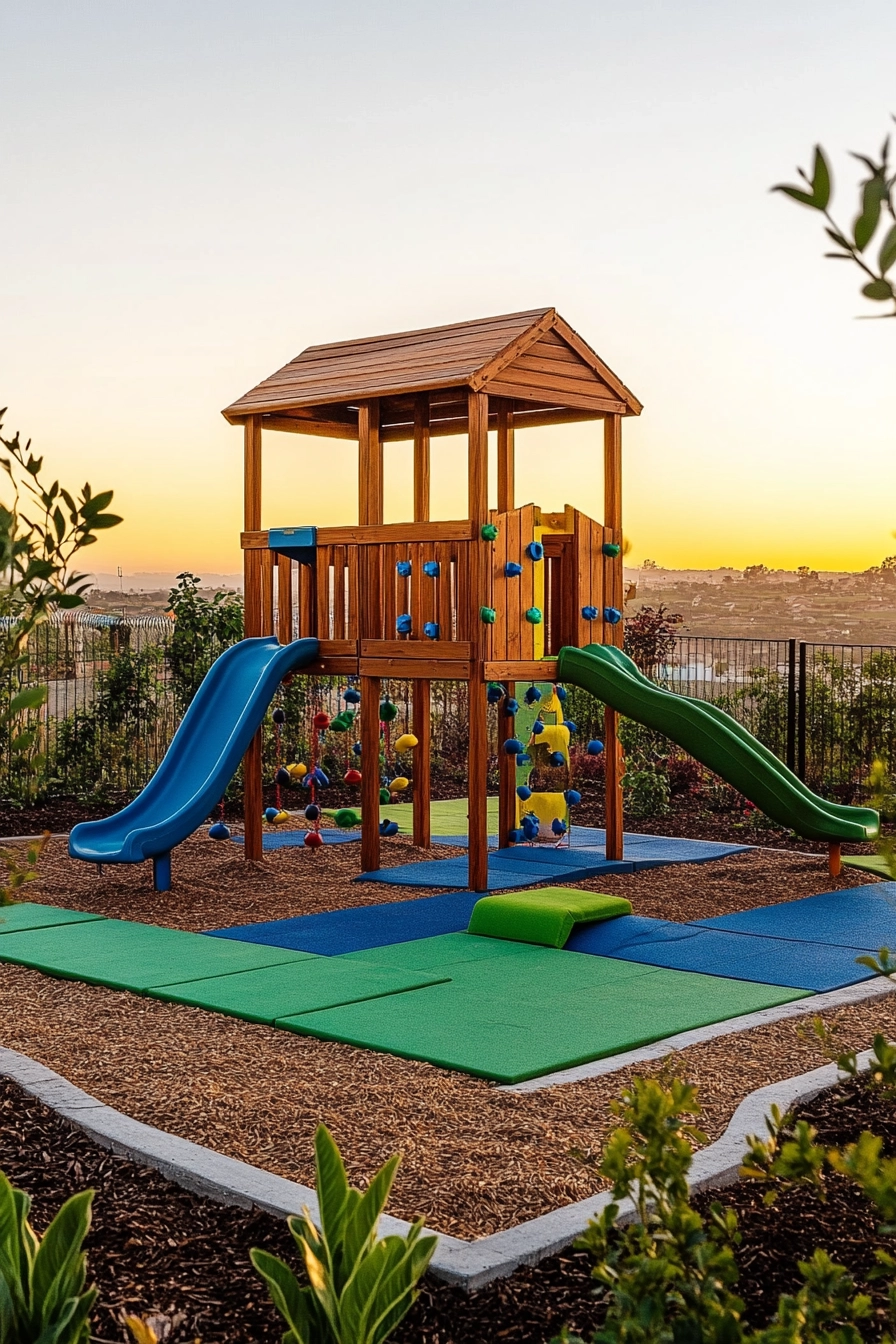
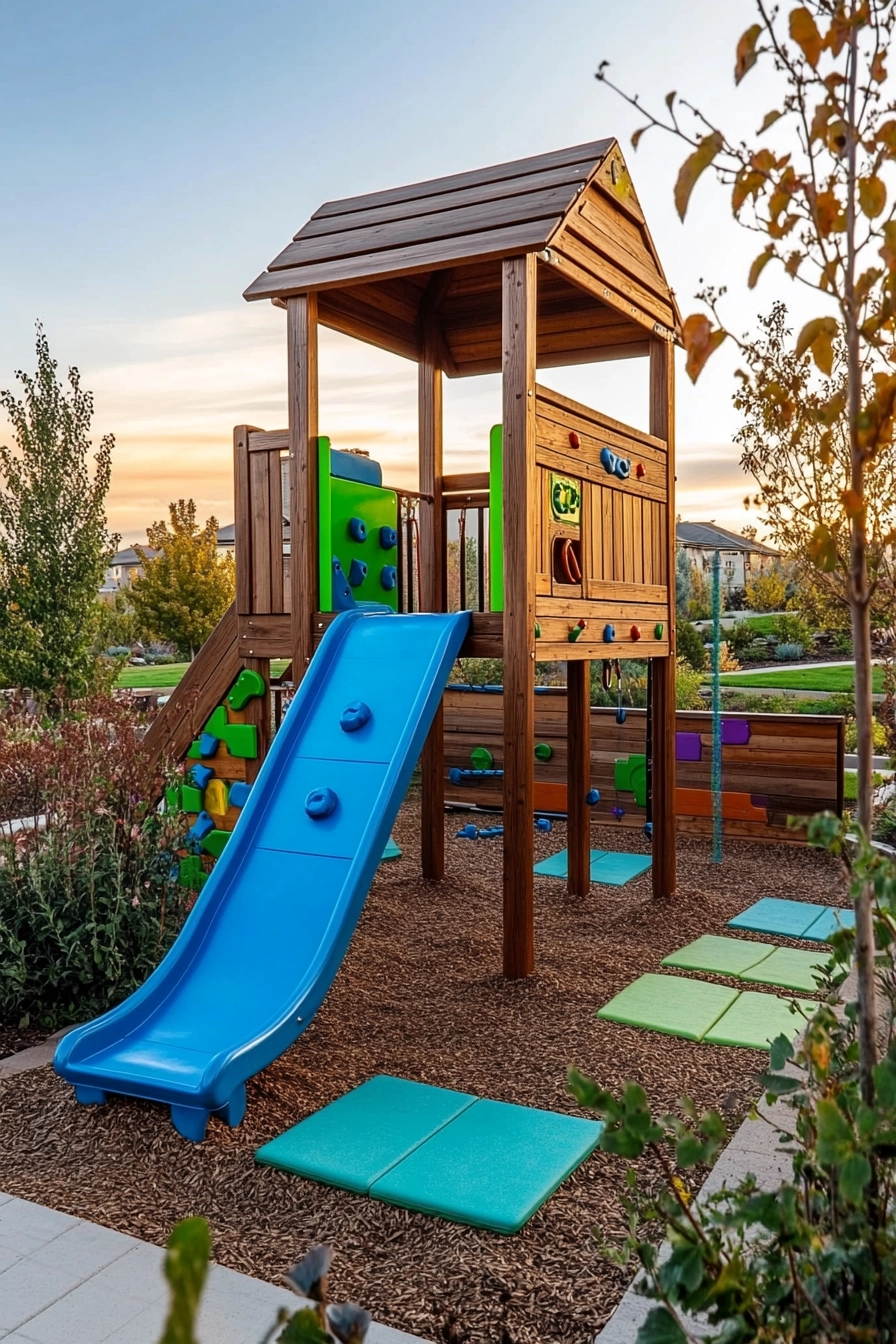
2. Compact Modular Play Zone
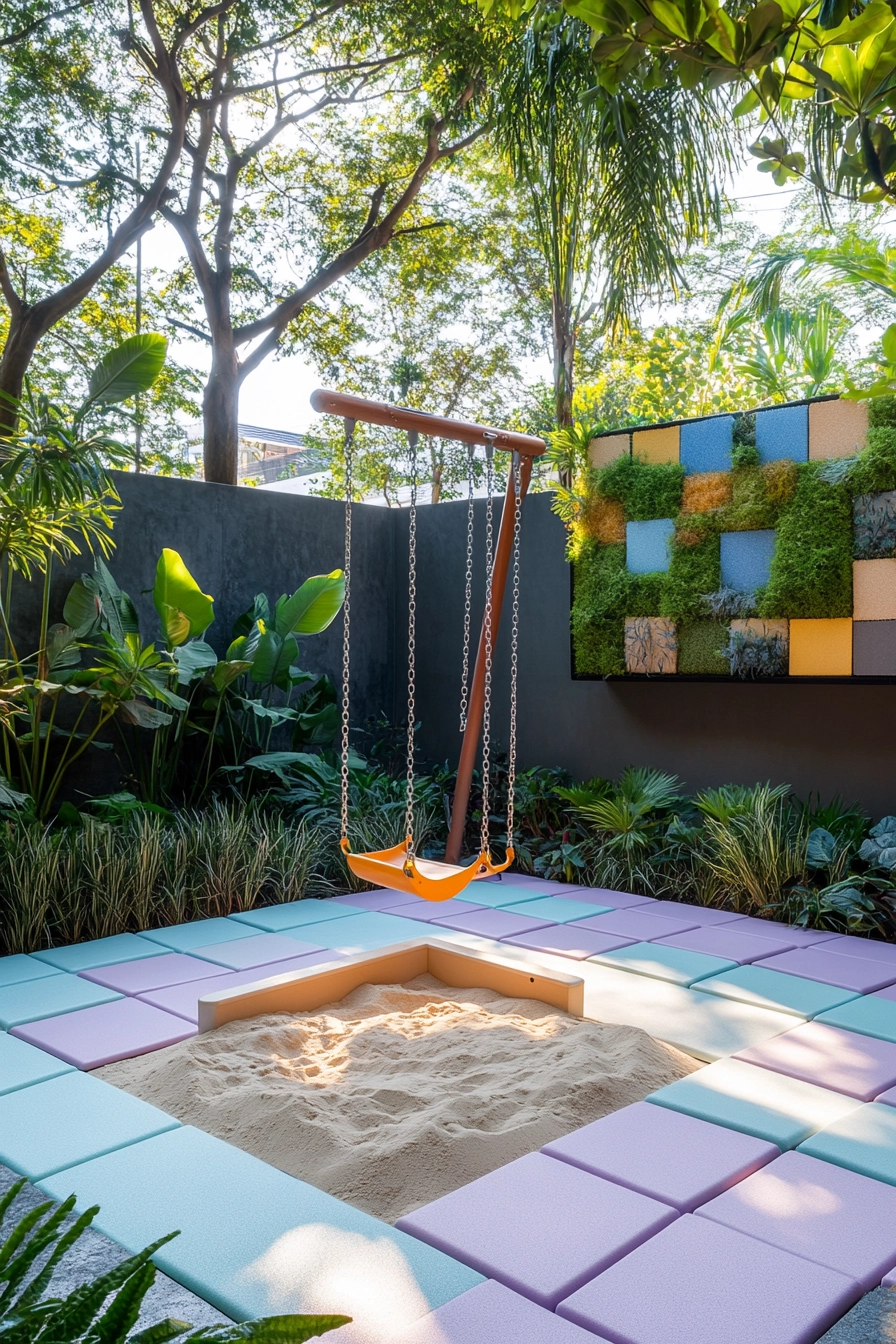
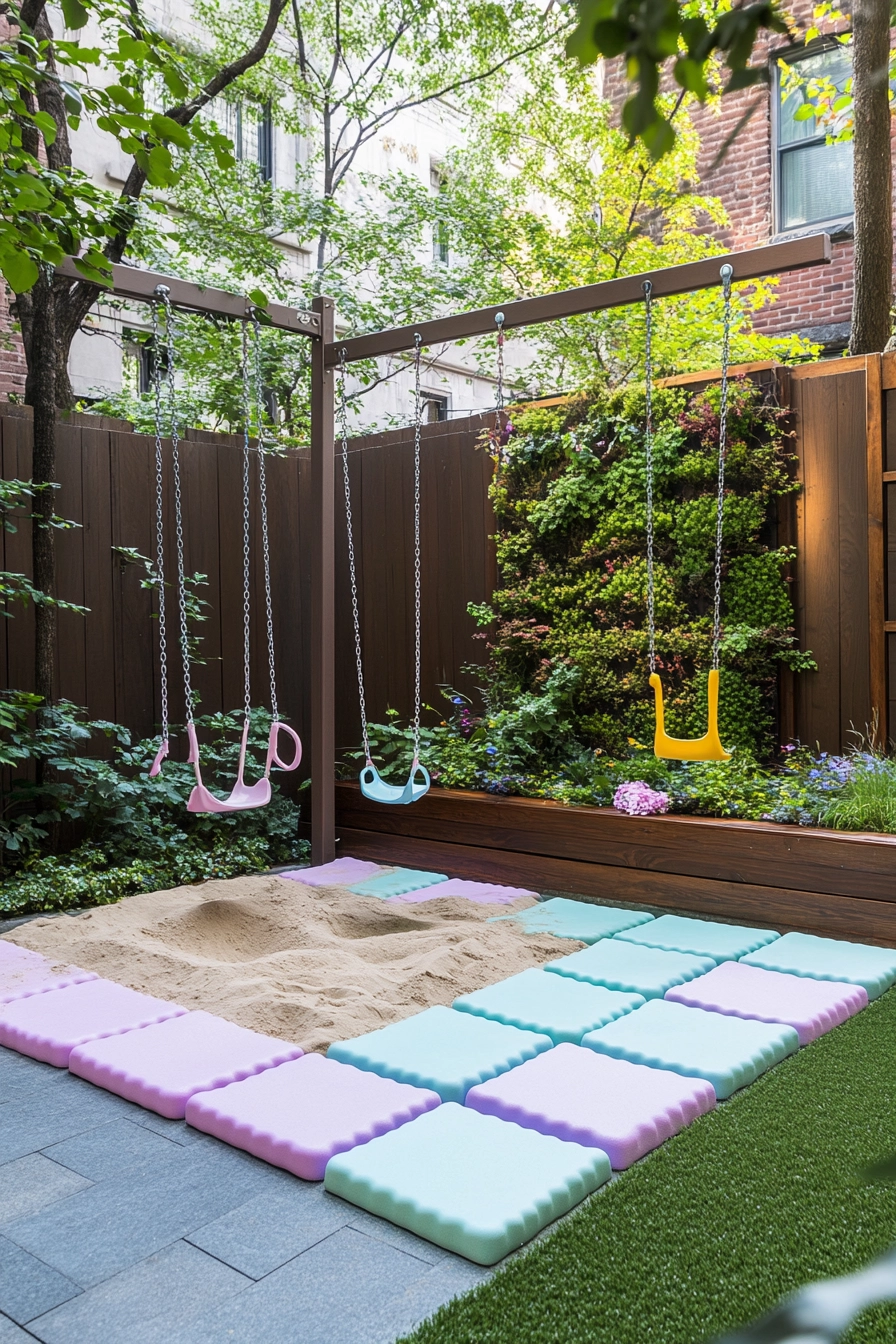
This design concept revolves around a compact modular play zone, making it perfect for smaller backyards. Interlocking foam tiles in pastel colors provide a soft and safe surface for play.
A low-profile swing set and a small sandbox with a built-in cover enhance play opportunities while ensuring that the area remains tidy when not in use. A vertical garden wall filled with child-safe plants adds a touch of greenery without compromising space.
The minimalist design with clean lines offers a modern aesthetic, complemented by low-maintenance landscaping that keeps the focus on the play zone. Natural lighting enhances the vibrancy of the colors, ensuring the area is inviting and fun.
This compact play zone caters to a variety of play styles, from swinging to digging, making it a versatile addition to any backyard.
- Select high-quality foam tiles for durability and easy cleaning.
- Incorporate a sandbox cover to keep the area clean and protected from rain.
- Use vertical gardens to maximize planting without occupying ground space.
- Choose non-toxic materials for all play structures and surfaces.
- Plan for a shaded area to protect kids from harsh sunlight during peak hours.
Pro Design Tip: Create a schedule for rotating toys and activities to keep the play zone fresh and exciting.
Budget Consideration: Modular play zones can be customized to fit various budgets. Consider DIY options for the sandbox and installing the vertical garden yourself.
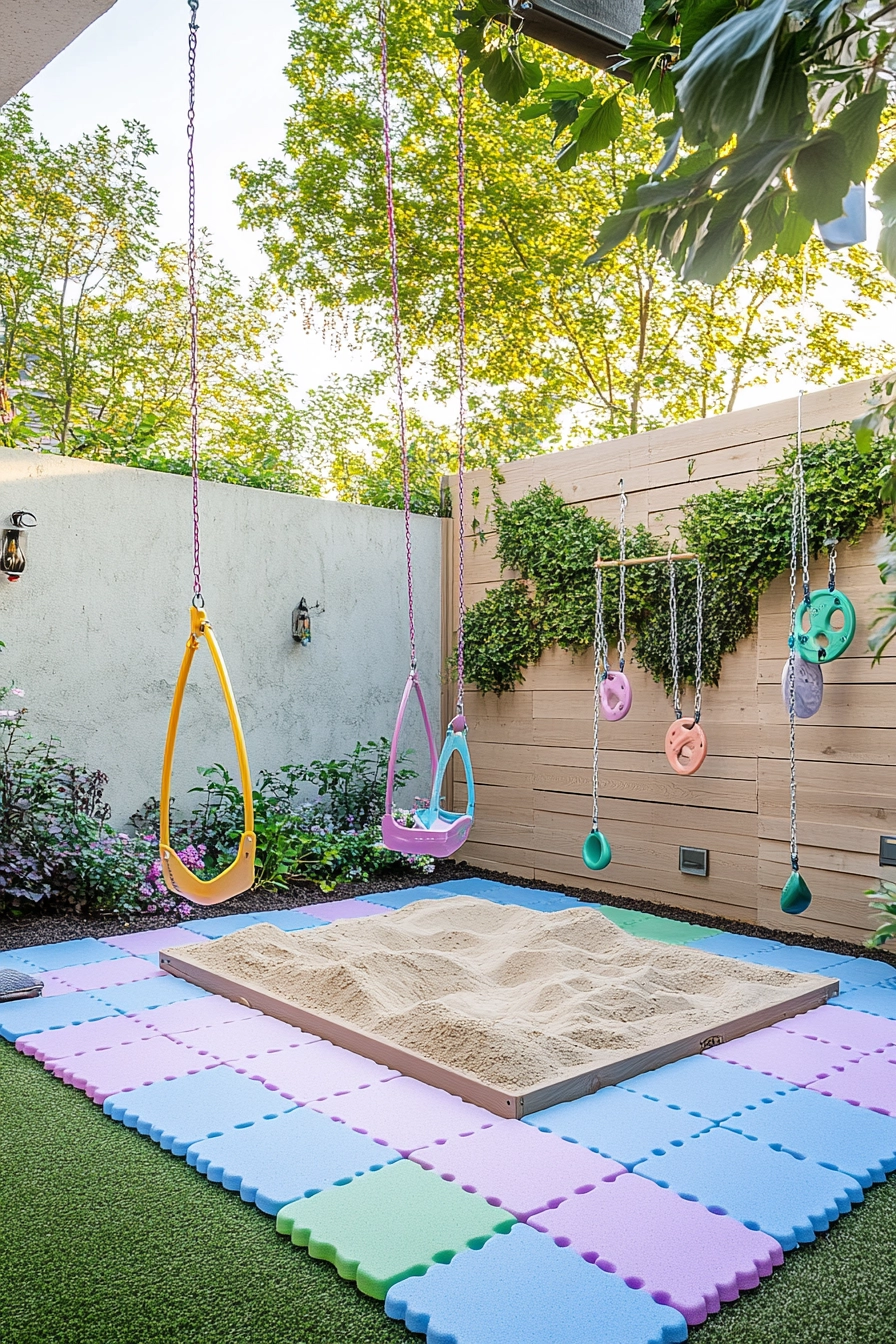
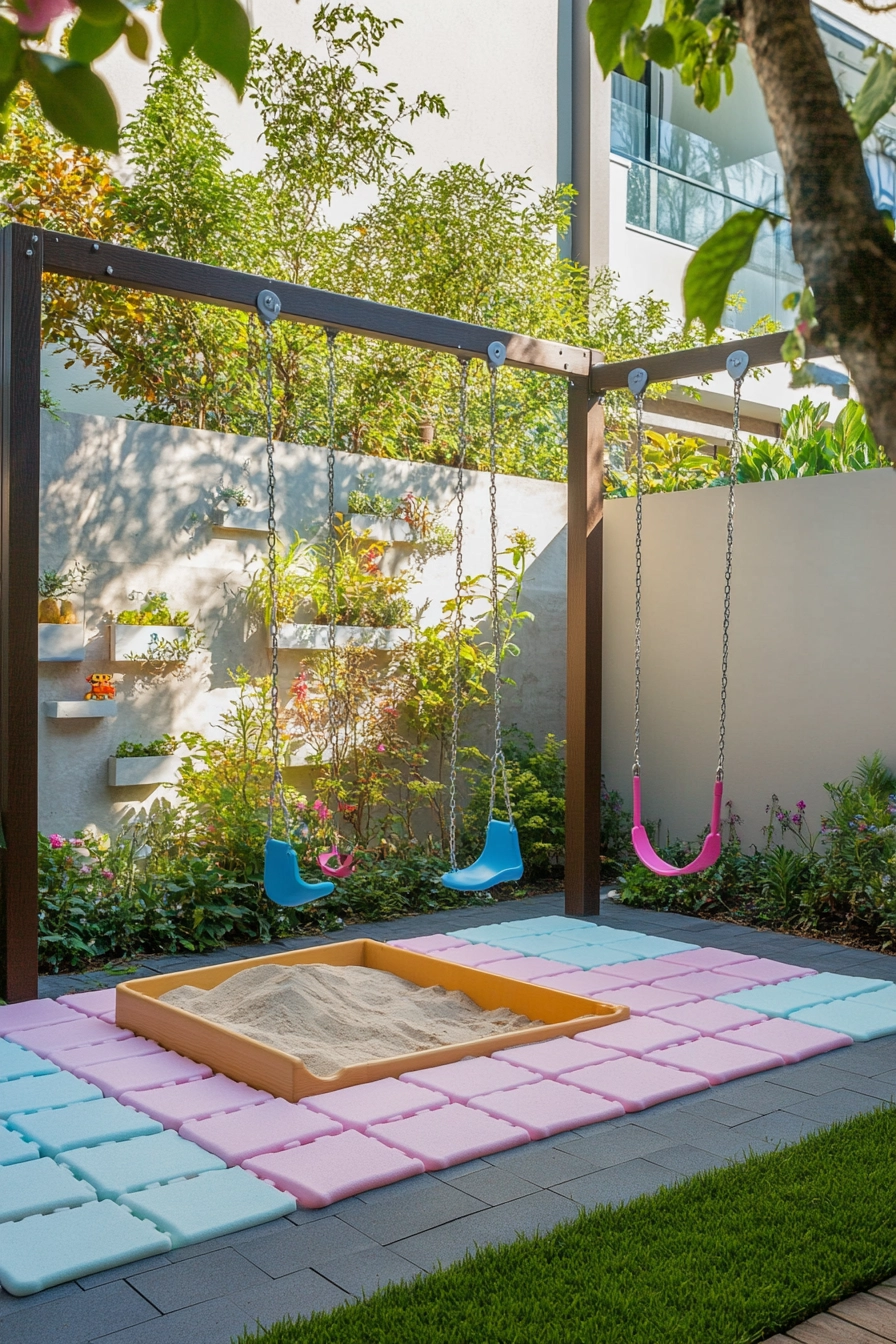
3. Multi-Functional Outdoor Learning Space
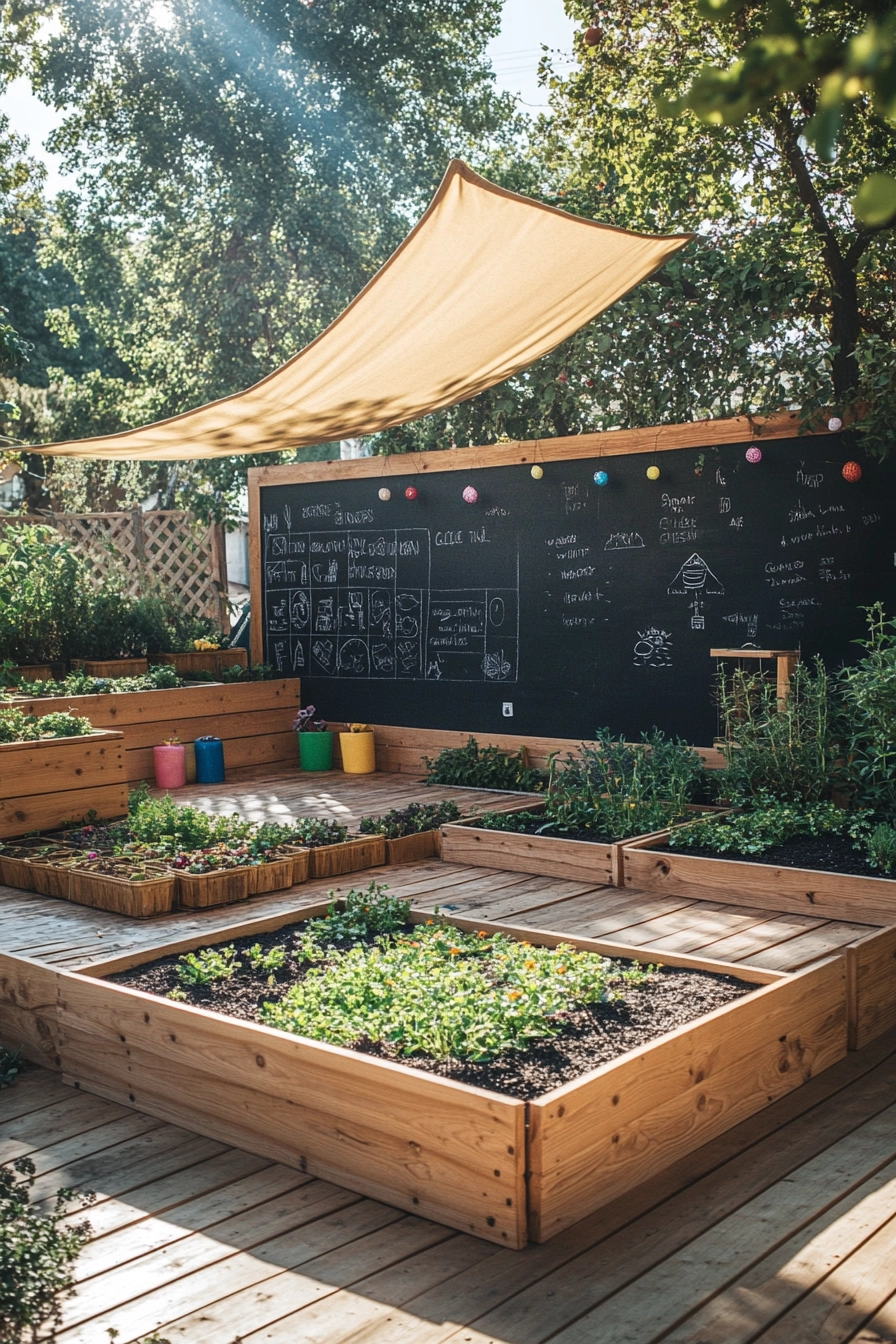
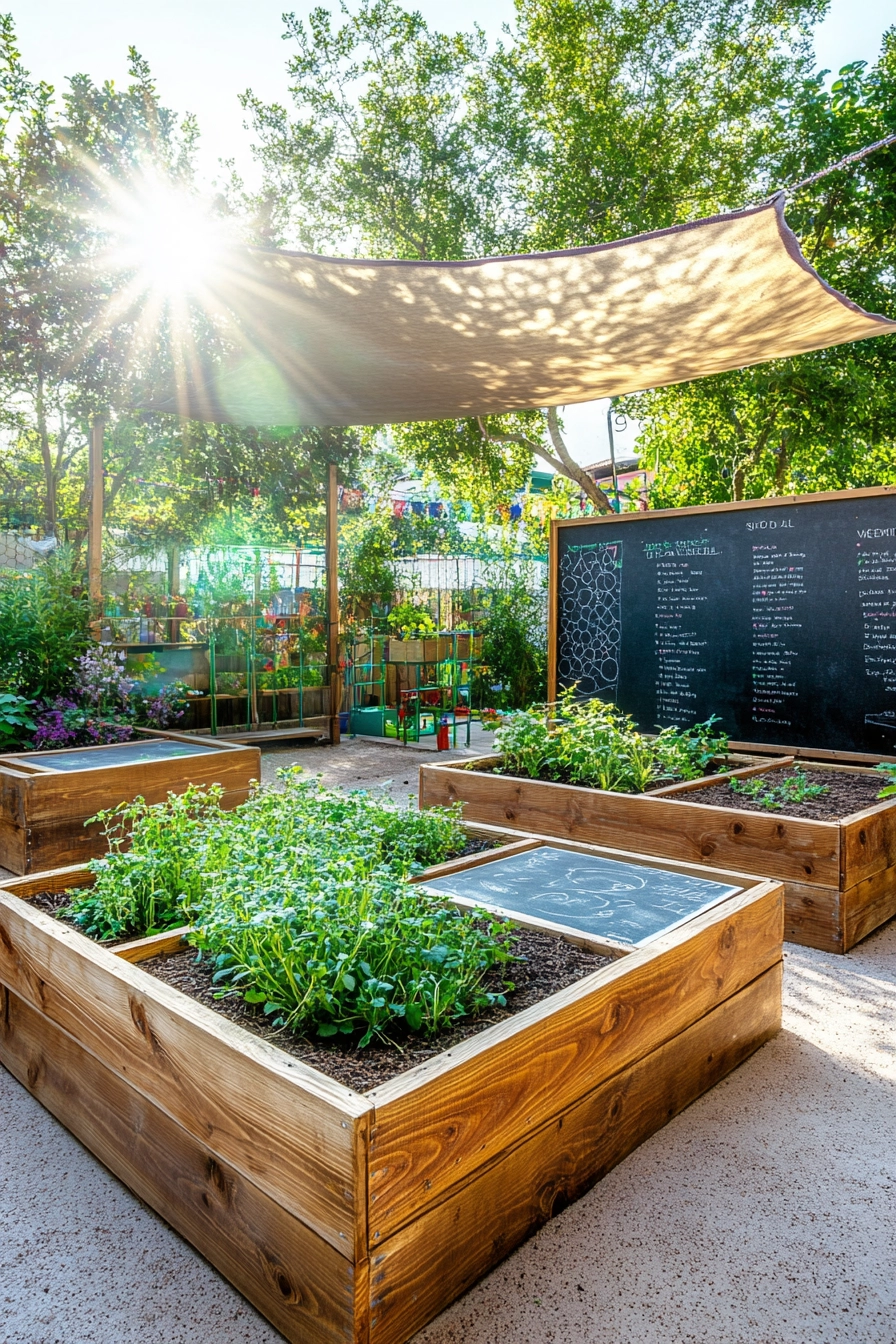
This backyard idea showcases a multi-functional outdoor learning space that integrates play and education seamlessly. A raised wooden platform features a chalkboard wall, allowing kids to express their creativity through art and writing.
Adjacent to the platform, herb garden planters introduce children to gardening, while a sensory exploration area offers various textured surfaces for tactile experiences. A shade sail provides UV protection, ensuring a comfortable environment for learning and play.
The use of sustainable materials throughout the design aligns with educational principles, teaching kids about eco-friendliness while they engage in creative activities. This space becomes not just a playground but a classroom, fostering an appreciation for nature and a love for learning.
- Incorporate movable planters for flexibility in gardening activities.
- Choose a variety of textures for sensory surfaces to stimulate exploration.
- Utilize non-toxic paint for the chalkboard wall for safety.
- Design with adjustable shade solutions to maximize comfort.
- Include educational signage about local wildlife and plants to enhance learning.
Pro Design Tip: Organize seasonal activities or workshops in the space to encourage community participation and learning.
Budget Consideration: Building the platform and garden planters can be done on a budget with reclaimed wood or DIY projects.
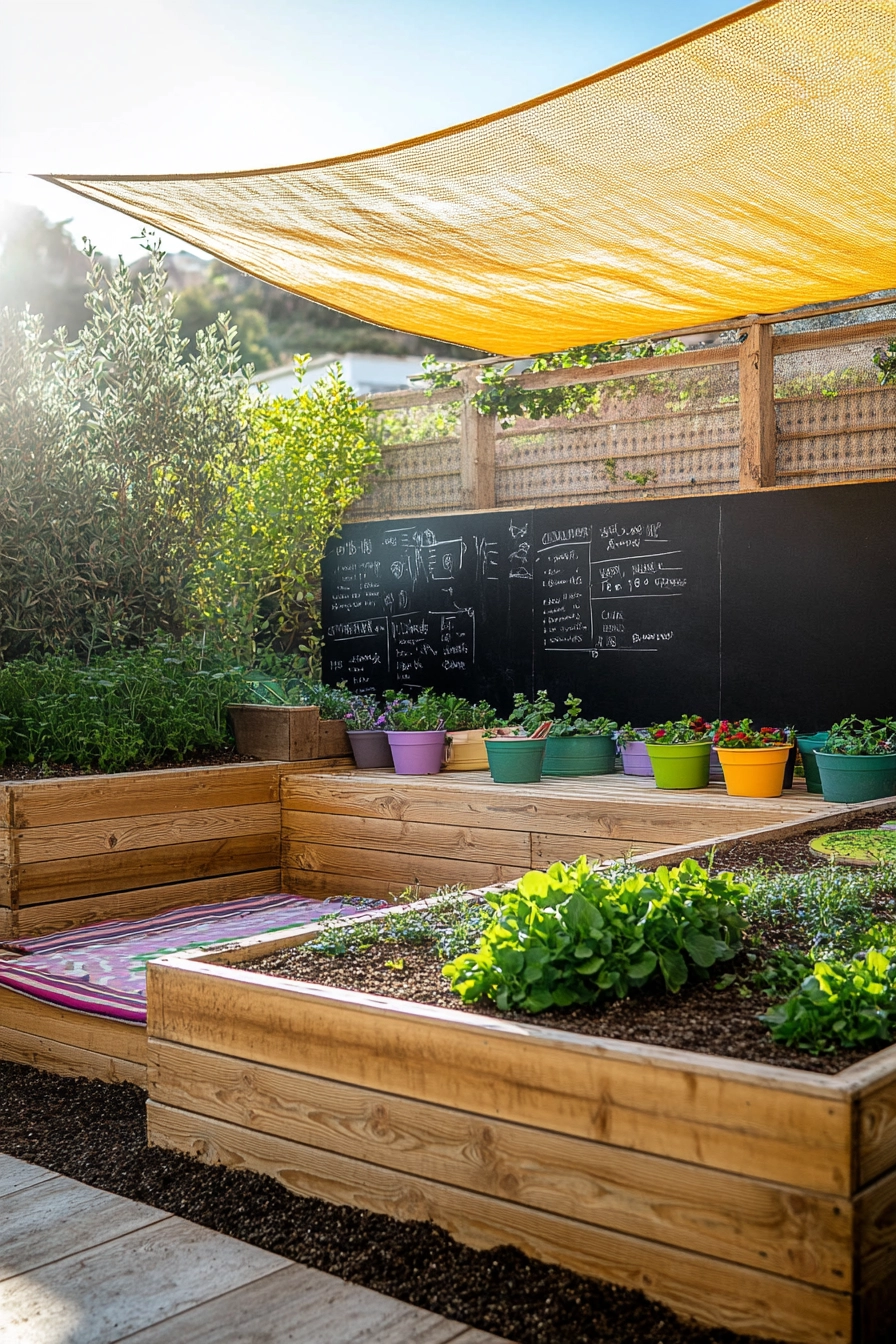

4. Compact Water Play Area
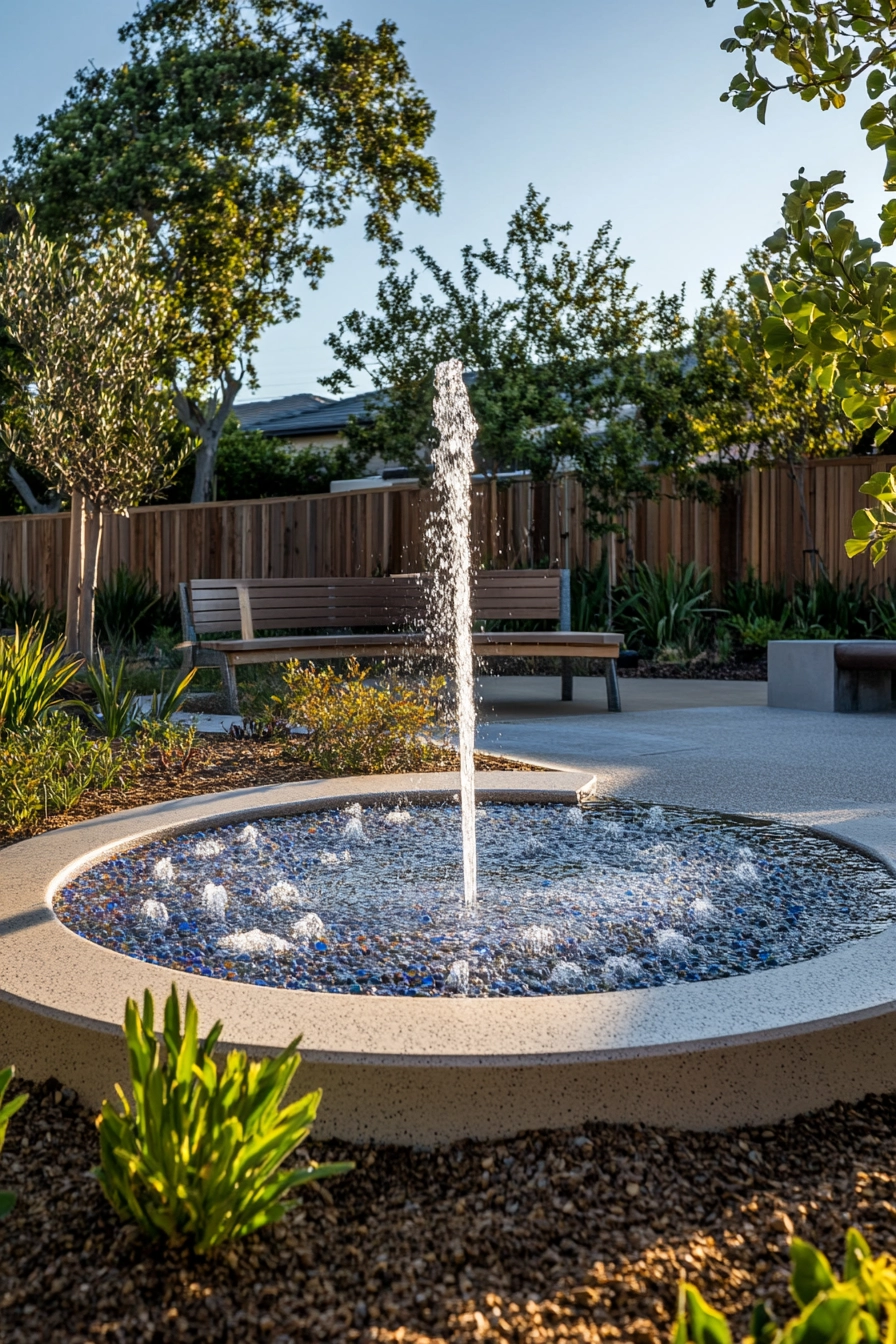
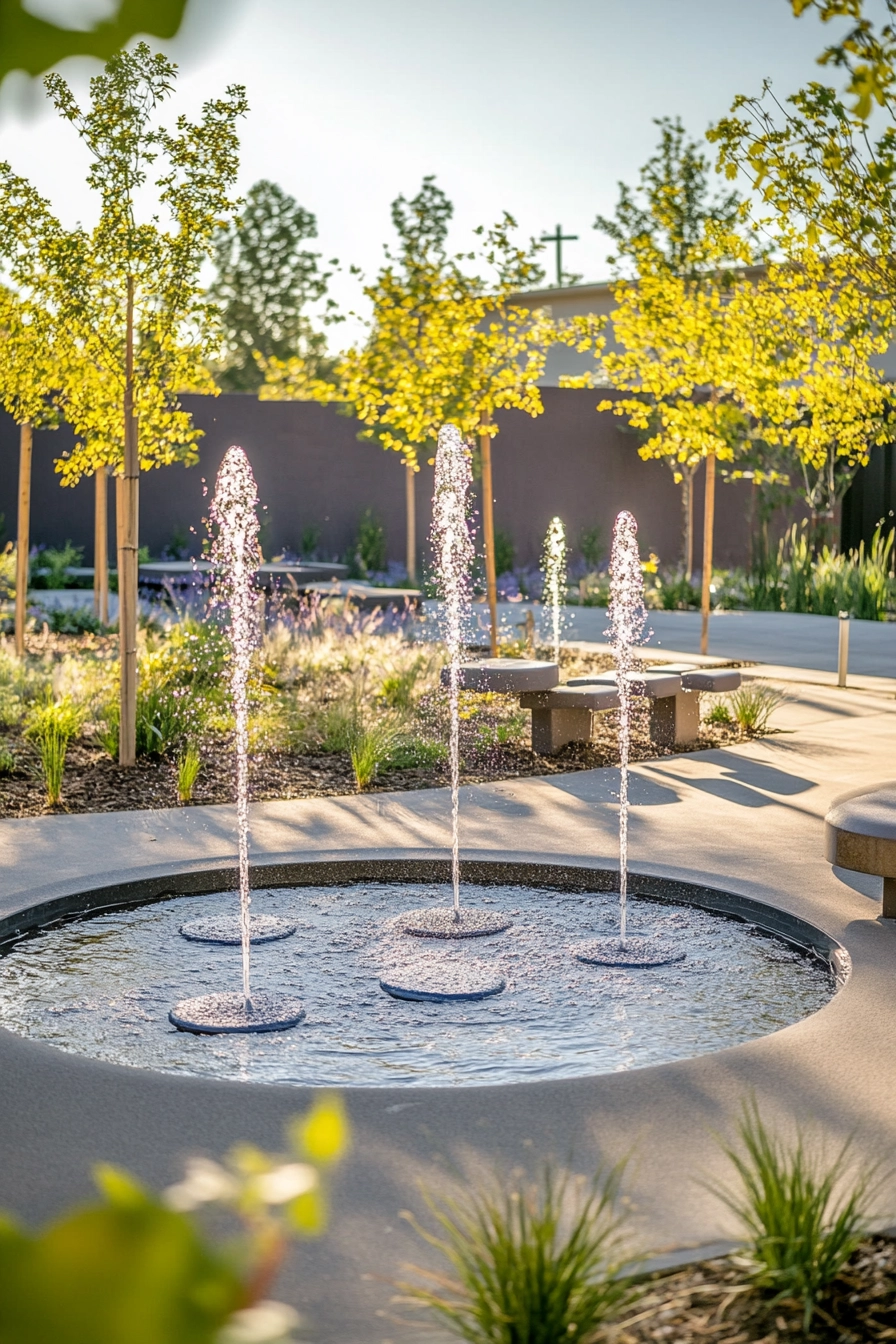
This small backyard idea features a compact water play area designed for endless splashes and giggles. A recirculating fountain with gentle spray zones offers a refreshing escape during warm days.
Rubber non-slip surfaces ensure safety, while integrated seating for parents allows them to relax while watching their children enjoy the water. Surrounding the area are native drought-resistant plants, which fit the modern landscape design with clean geometric lines.
The combination of the water feature and the surrounding plants creates a serene oasis for families. This backyard promotes sensory play while also teaching kids about water conservation and the importance of native landscaping.
The modern design encourages a clean and organized look, ensuring the area remains clutter-free and functional.
- Opt for energy-efficient pumps for the fountain to reduce electricity costs.
- Incorporate native plants that thrive in wet conditions to enhance the environment.
- Design pathways around the play area for easy access and safety.
- Consider a retractable awning for additional shade options.
- Use colorful, child-friendly seating to create a vibrant atmosphere.
Pro Design Tip: Create a seasonal schedule for water play activities to keep the area exciting throughout the year.
Budget Consideration: Water features can range in cost; consider smaller DIY installations or pre-made fountains for budget-friendly options.
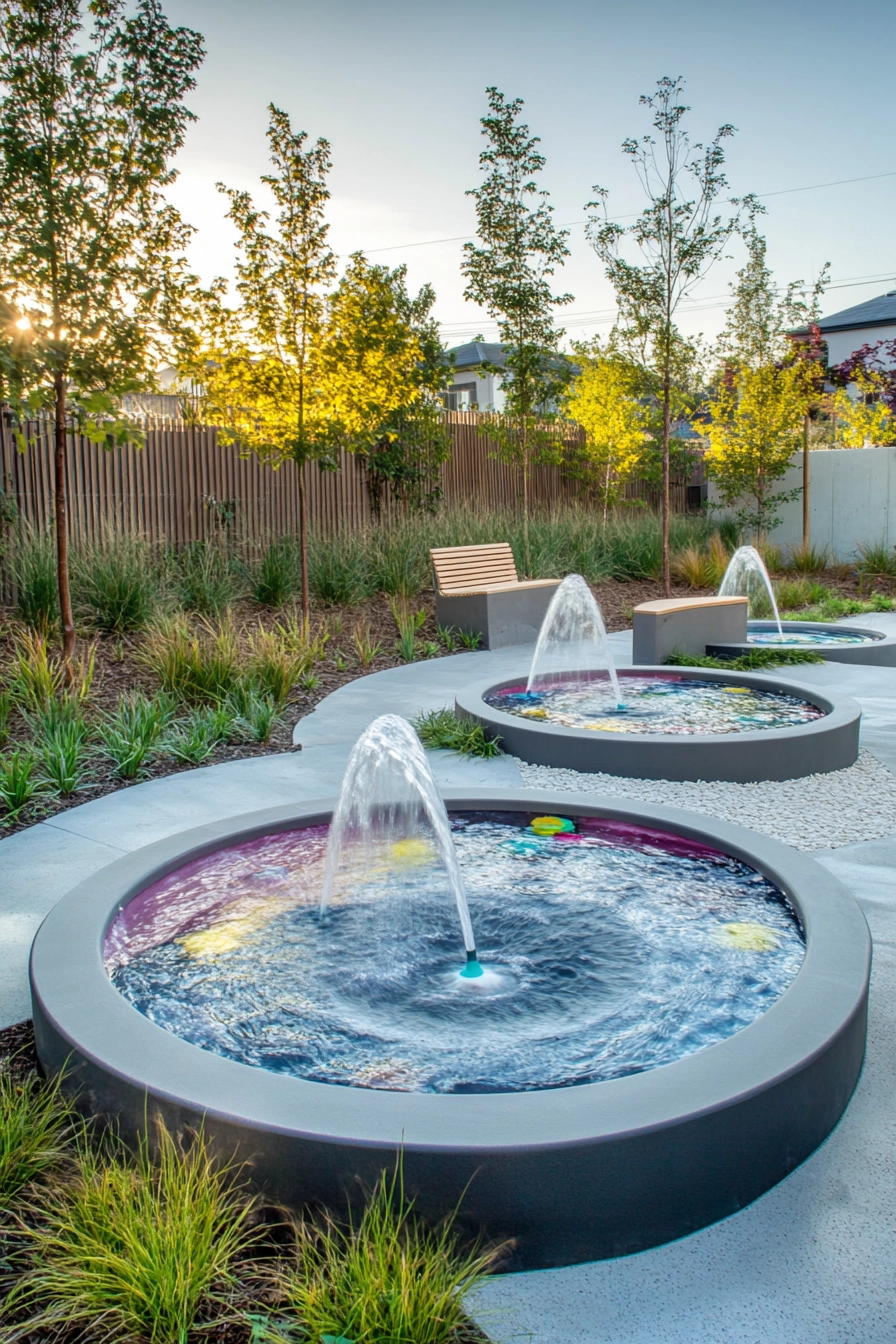
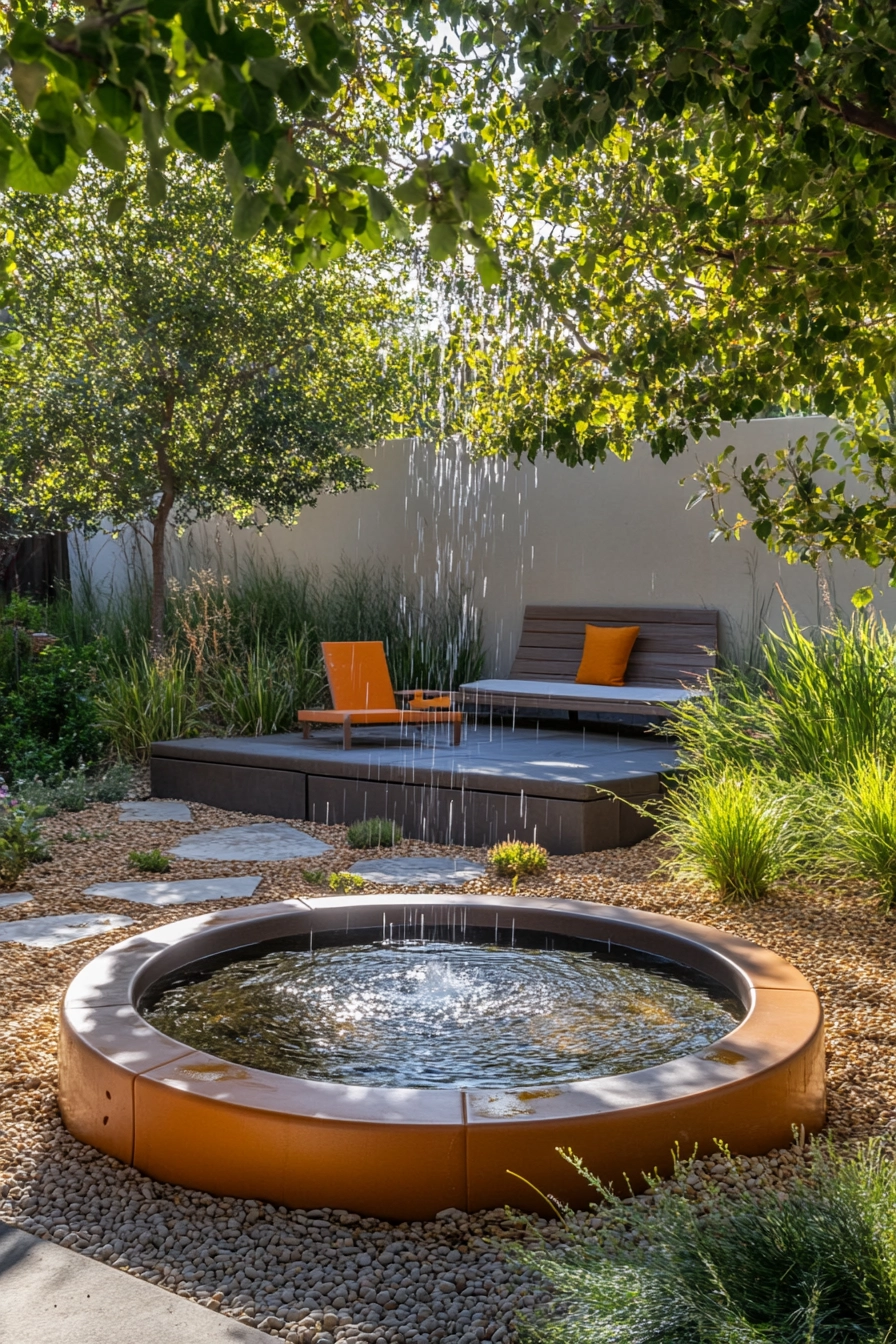
5. Urban Compact Adventure Zone
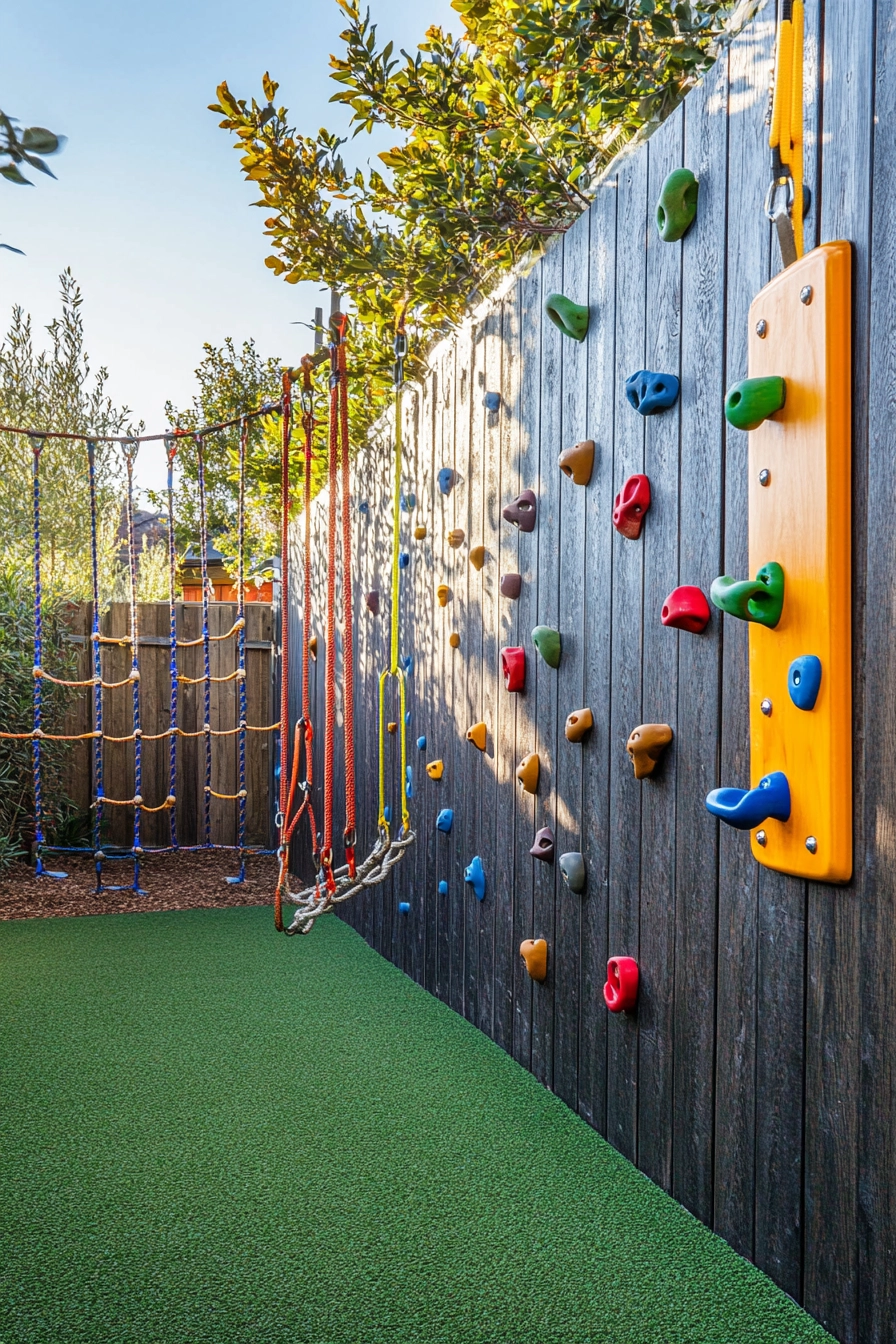
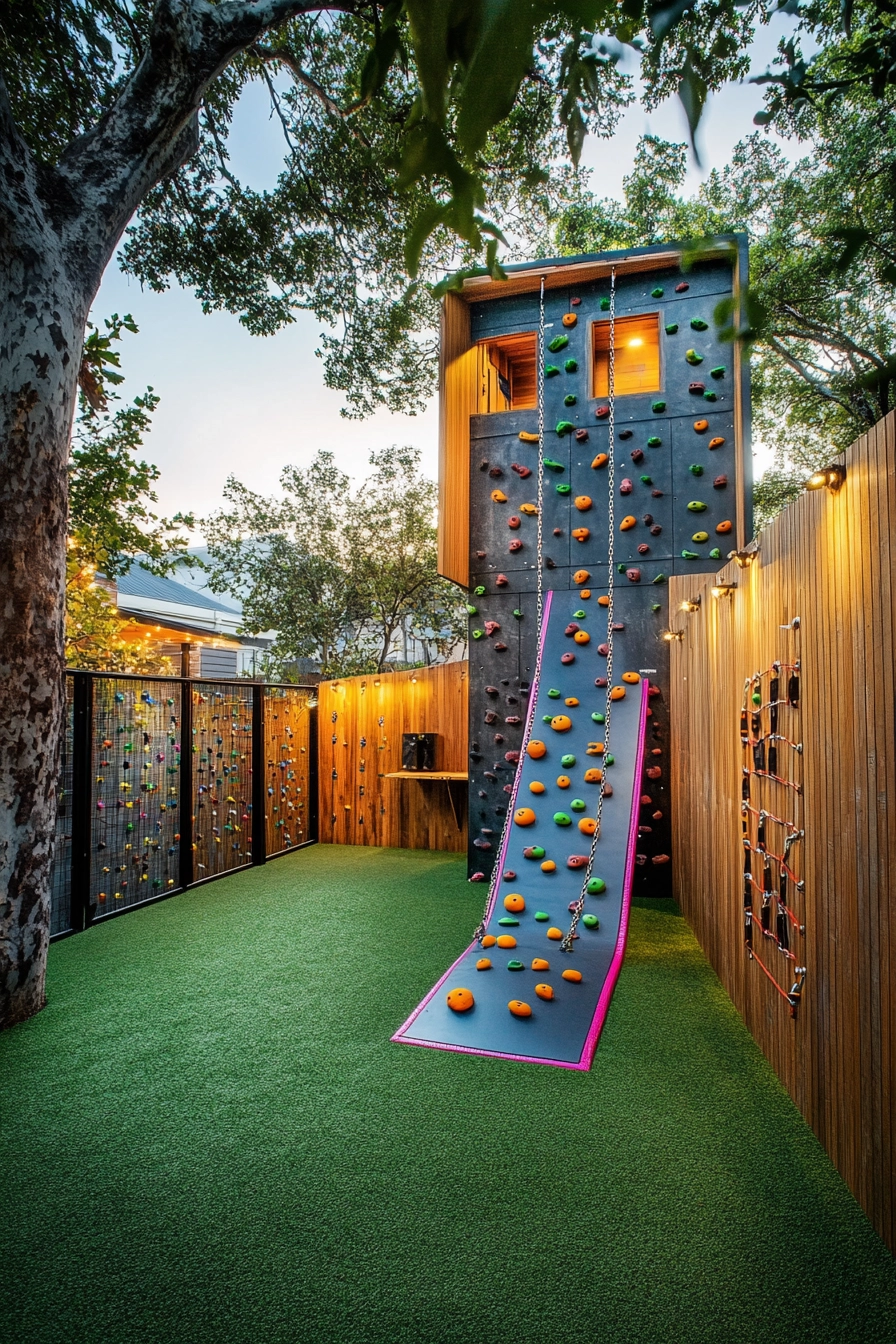
This urban compact adventure zone is designed for thrill-seeking kids who love climbing and balancing. The vertical climbing wall integrated into the fence provides an exciting challenge, while hanging rope elements and a balance beam made from recycled materials promote physical fitness and coordination.
The use of artificial turf as ground cover ensures a safe landing and requires minimal maintenance, making it ideal for busy parents.
With an industrial-inspired play environment, this design emphasizes modern aesthetics while encouraging active play. The vibrant colors of the safety padding add a fun element to the overall look, ensuring that the area is not only functional but also visually appealing.
- Choose sturdy, weather-resistant materials for all climbing elements.
- Incorporate safety mats or turf for fall protection around climbing structures.
- Design the layout to allow for easy supervision from the home.
- Use bright colors to create an energizing atmosphere.
- Integrate fitness challenges that cater to various skill levels.
Pro Design Tip: Regularly update the adventure elements to keep kids engaged and challenged in their physical play.
Budget Consideration: Consider DIY climbing walls using repurposed materials to save on costs while promoting sustainable practices.
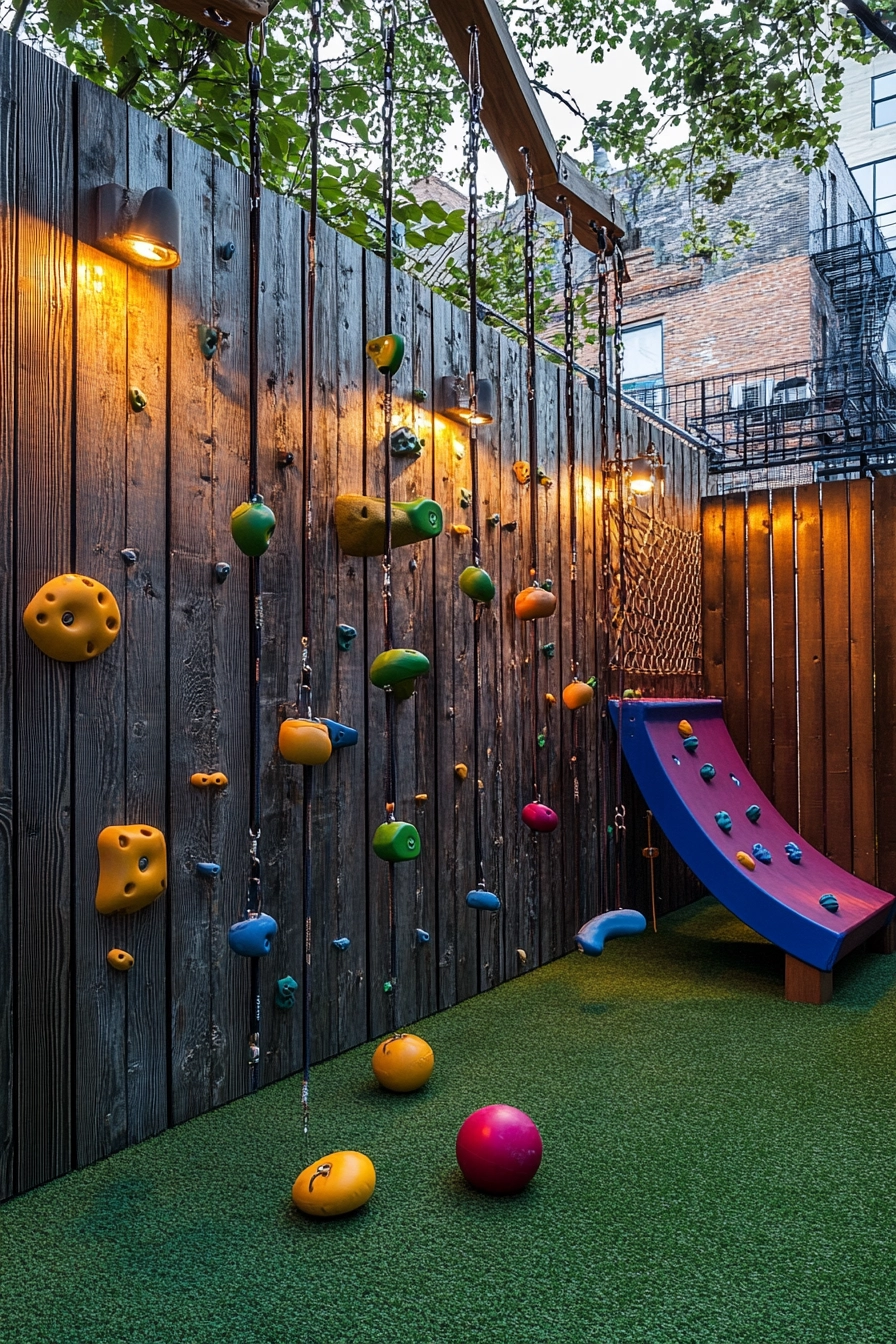
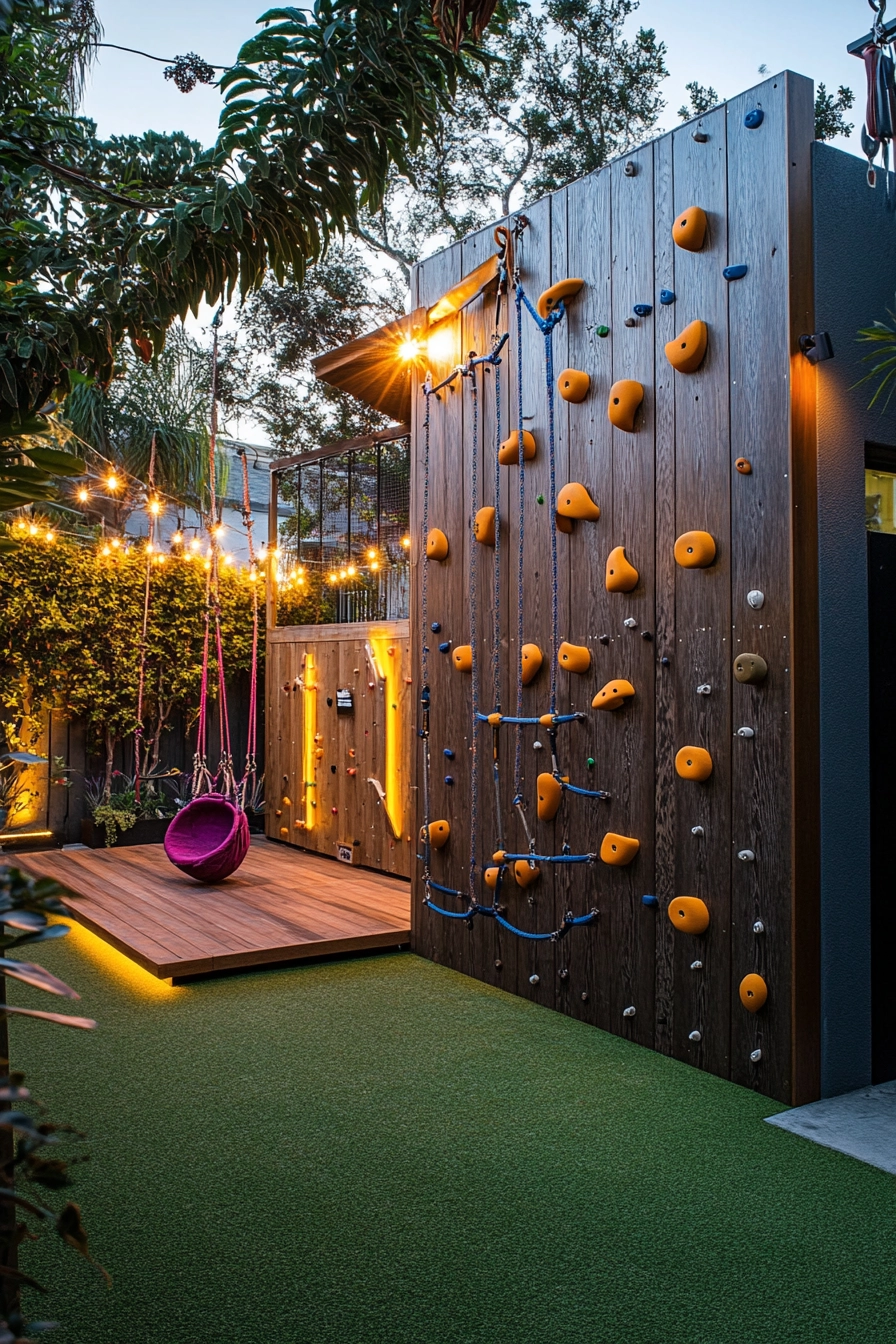
6. Nature-Inspired Exploration Area
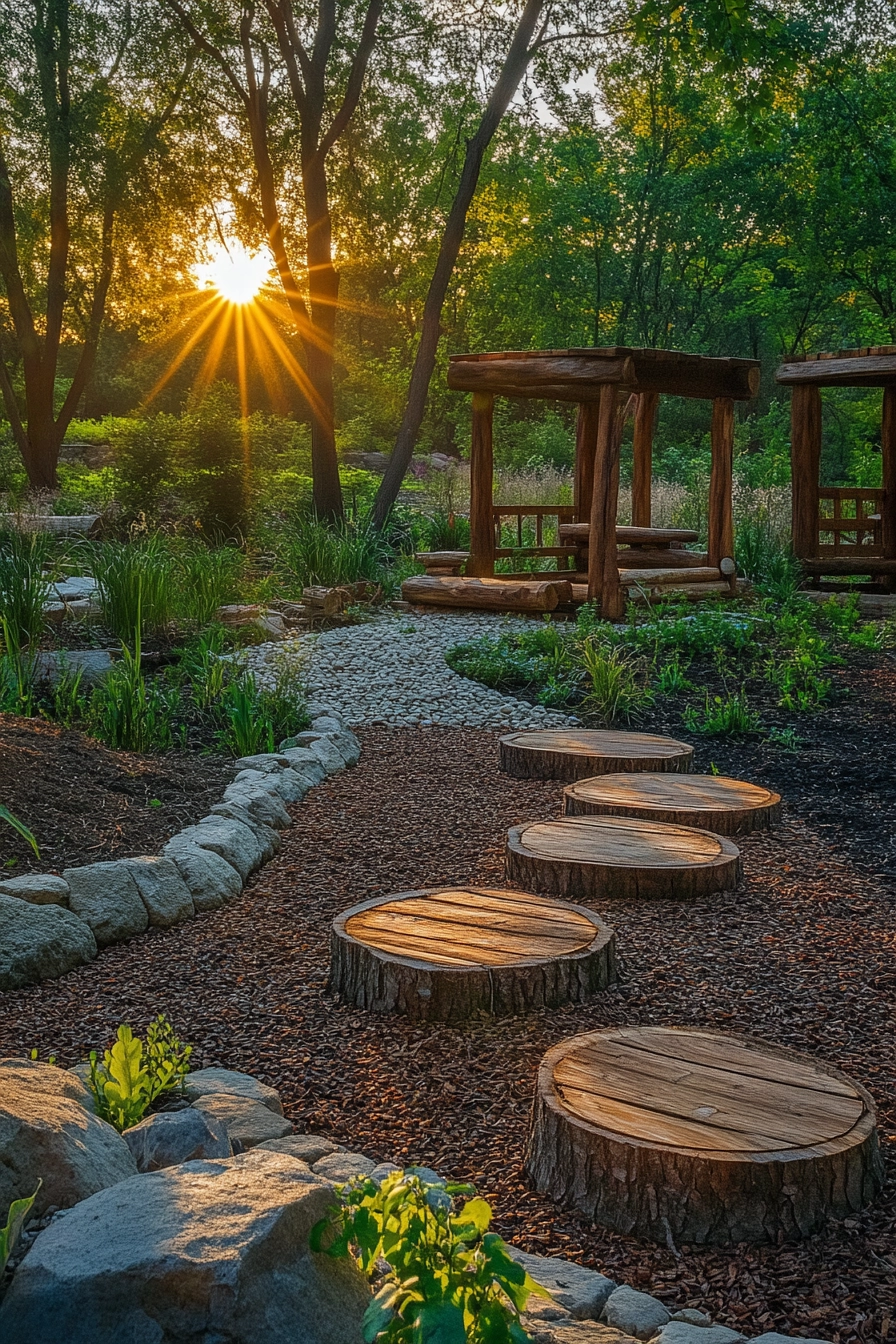
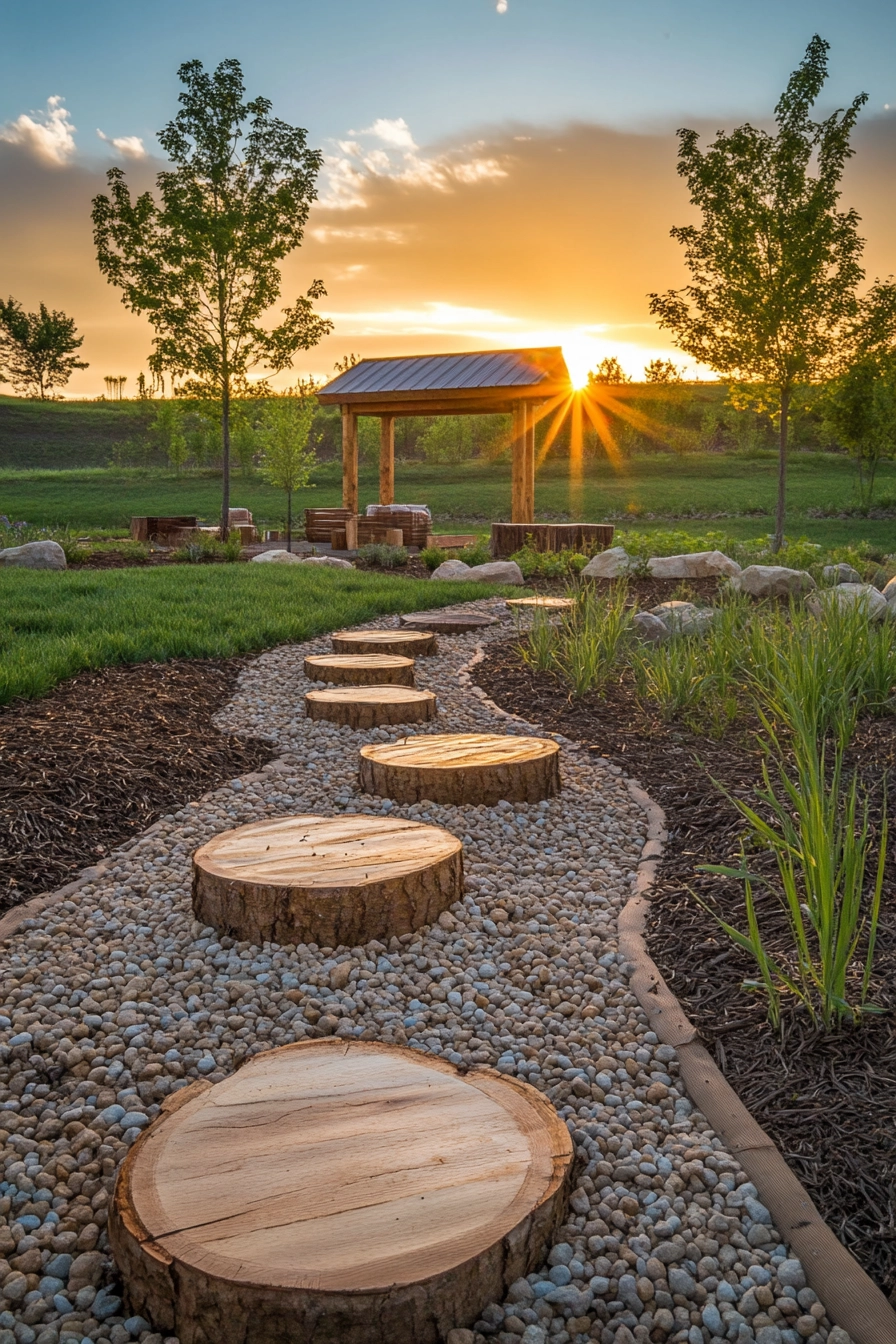
This backyard concept presents a nature-inspired exploration area that encourages kids to engage with their environment. Log stepping stones lead to a small creek simulation, providing a sensory experience that fosters imaginative play.
A native plant discovery zone introduces children to local ecosystems, with educational signage highlighting the importance of biodiversity. The use of natural wood structures enhances the overall aesthetic, creating a harmonious blend with the outdoors.
The design emphasizes sustainable principles, making it a perfect teaching tool for parents looking to instill a love for nature in their children. This exploration area not only serves as a play space but also as an interactive learning environment that promotes curiosity and respect for nature.
- Incorporate natural materials such as logs and stones for an organic feel.
- Design pathways that encourage exploration and discovery.
- Use educational signage to promote learning opportunities.
- Plan for seasonal changes in plants to keep the area dynamic.
- Incorporate seating areas for parents to relax while supervising play.
Pro Design Tip: Organize guided nature walks or activities to deepen kids’ understanding of their local ecosystem.
Budget Consideration: Sourcing native plants and natural materials locally can save costs and enhance sustainability.
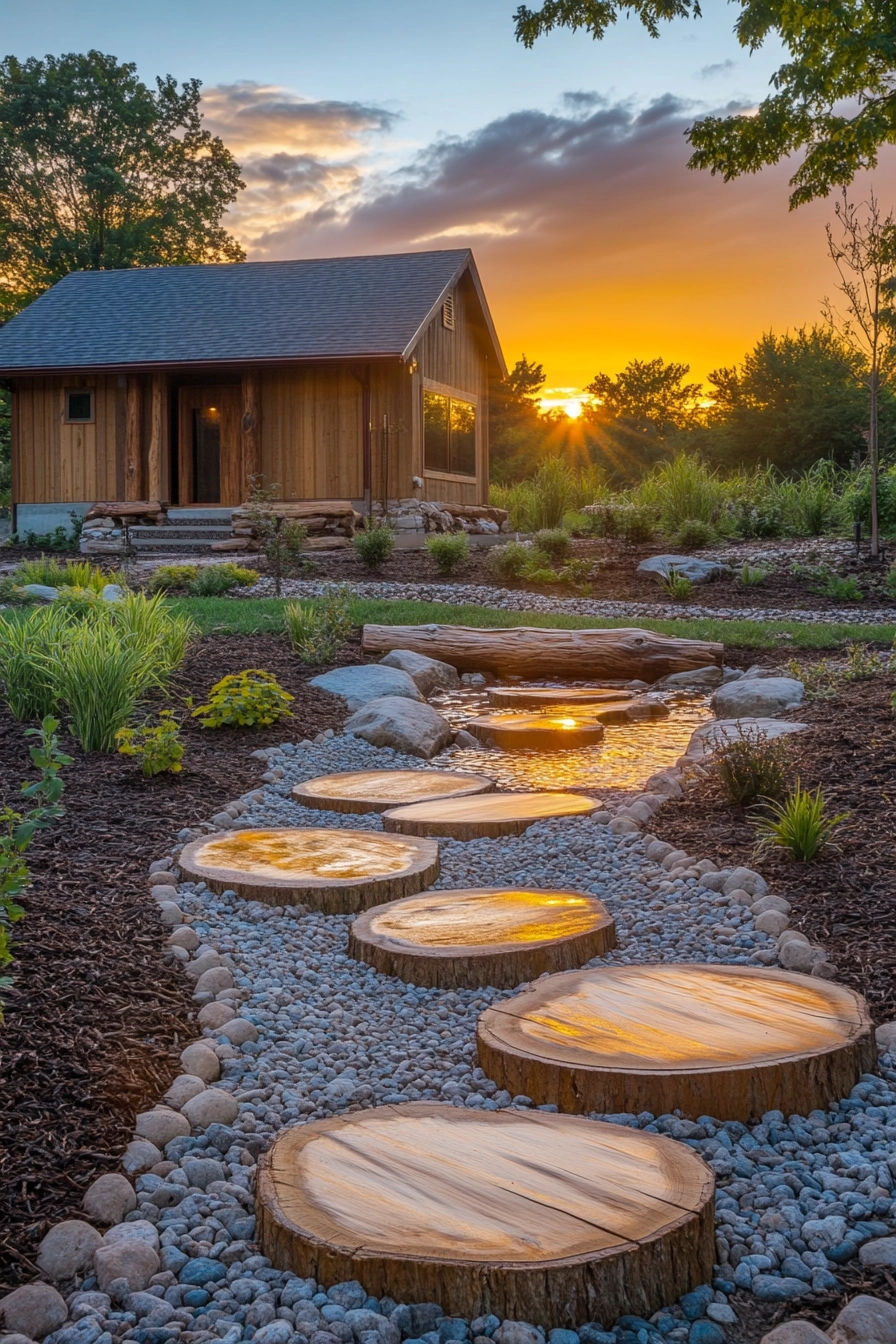
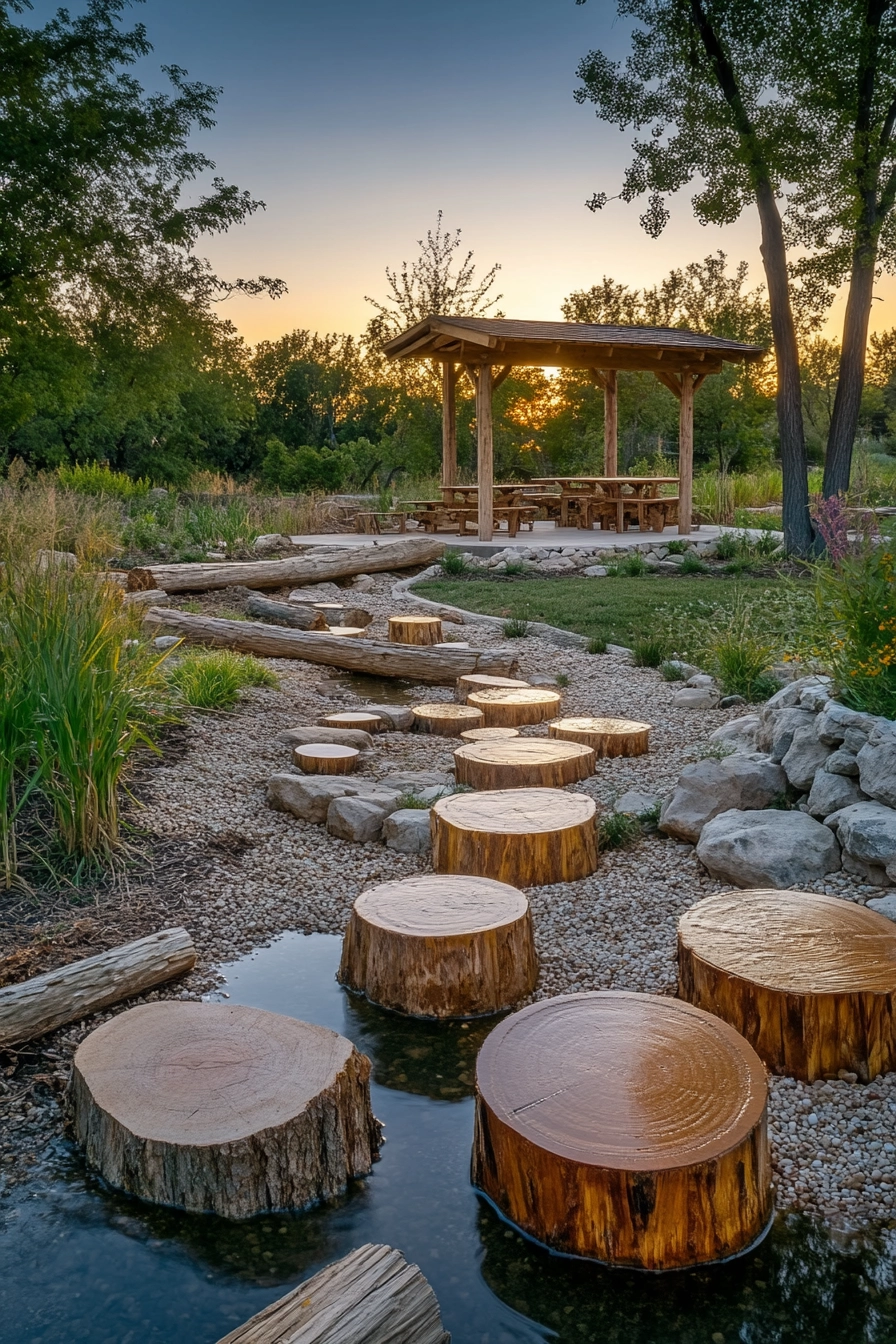
7. Compact STEM-Focused Play Environment
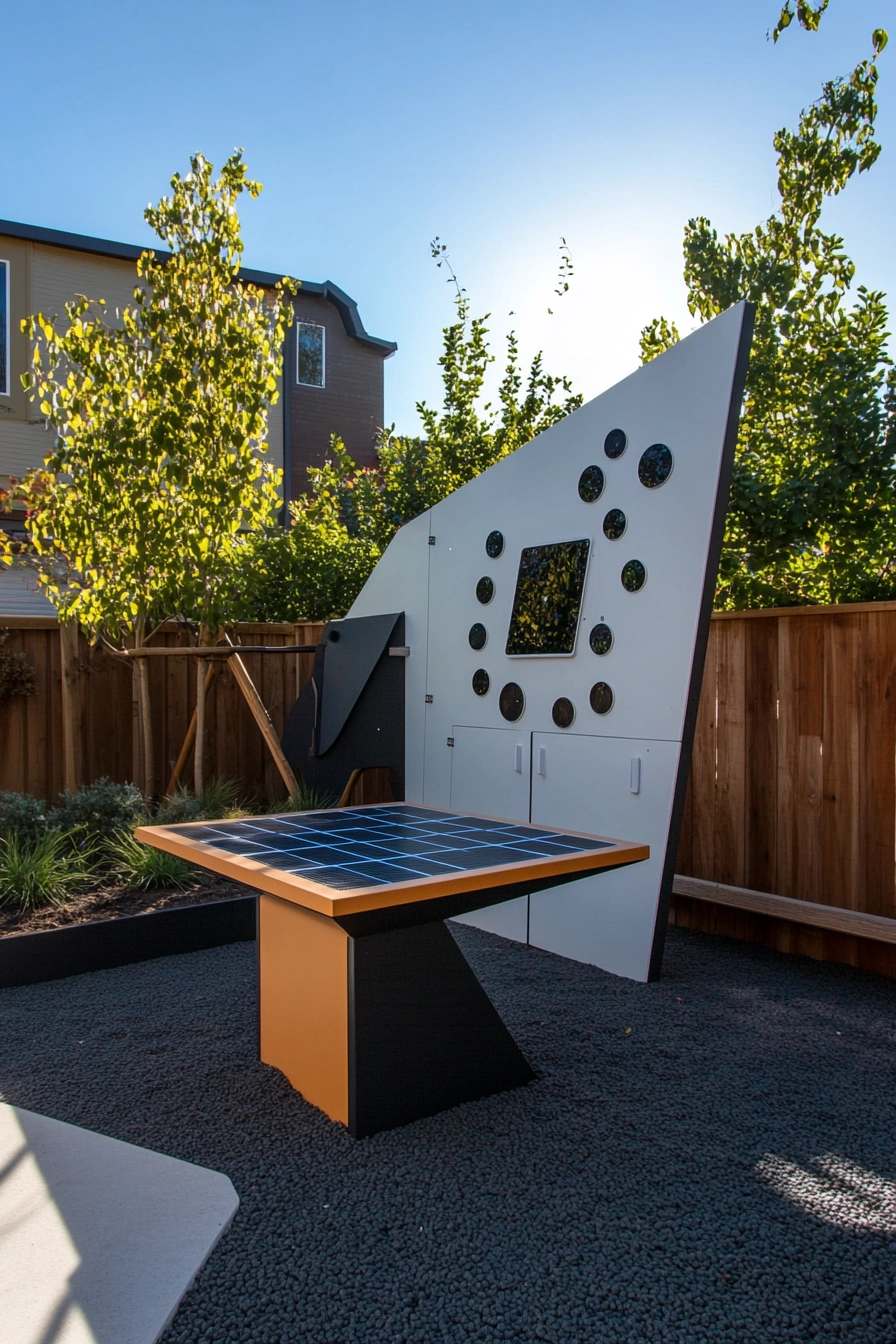
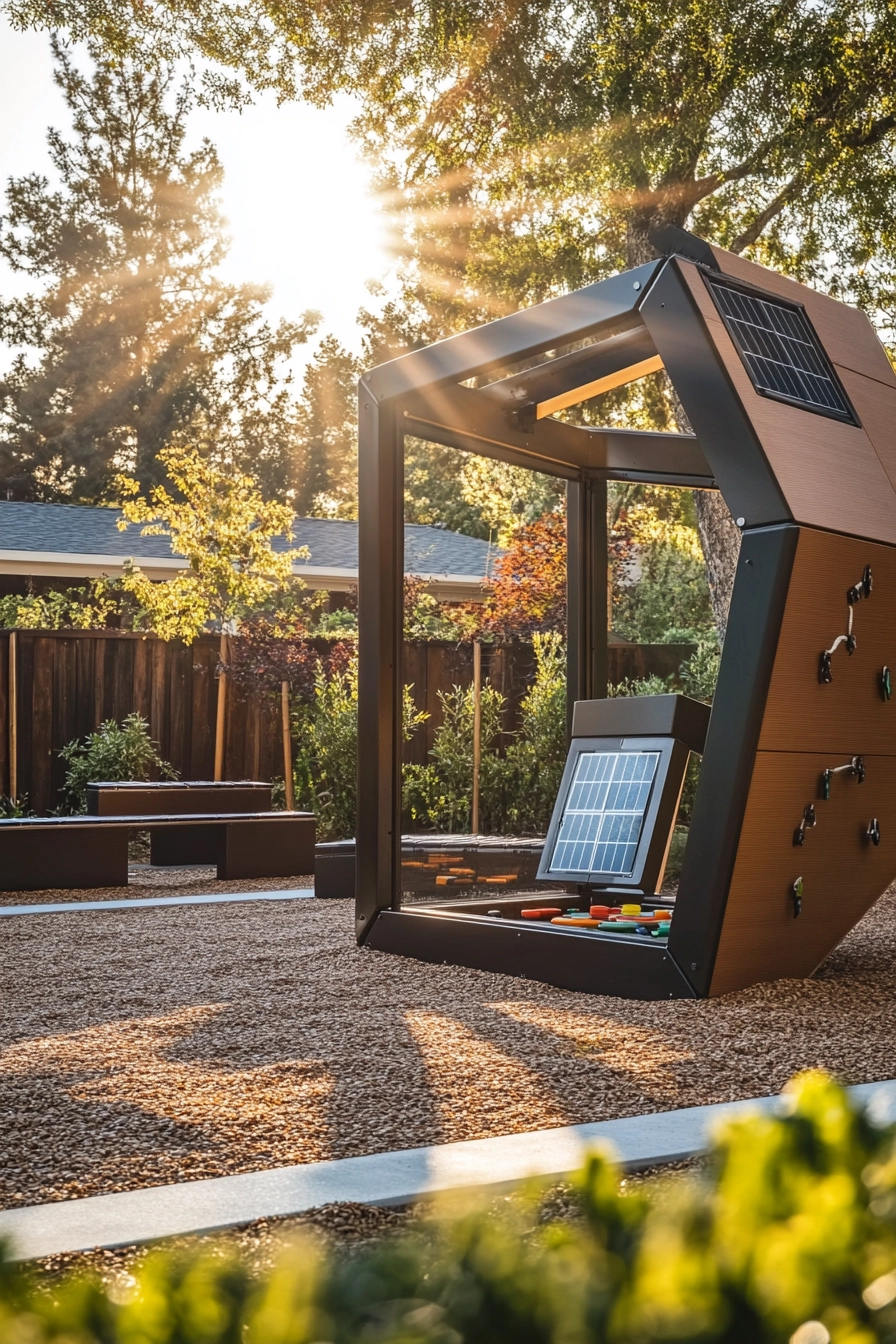
This small backyard idea centers around a compact STEM-focused play environment designed to spark curiosity and innovation. A modular robotic building station allows children to engage in hands-on learning while developing critical thinking skills.
Solar-powered interactive elements provide additional learning opportunities, while geometric play structures encourage imaginative construction and exploration. The use of rubber ground cover in neutral tones offers a safe space for active play.
This design prioritizes modern educational principles, enabling kids to learn through play in a dynamic and engaging atmosphere. The sleek lines and contemporary aesthetics create a visually appealing space that parents will appreciate, while the focus on STEM subjects ensures that children are being prepared for the future.
- Incorporate easily movable elements to encourage creativity and experimentation.
- Use solar-powered features to teach kids about renewable energy.
- Design with safety in mind, ensuring all structures are securely anchored.
- Plan for flexible spaces that can be adapted for various activities.
- Integrate technology in a way that promotes healthy engagement and learning.
Pro Design Tip: Host themed STEM challenges to encourage kids to collaborate and explore together.
Budget Consideration: Consider DIY building stations using recycled materials to reduce costs.
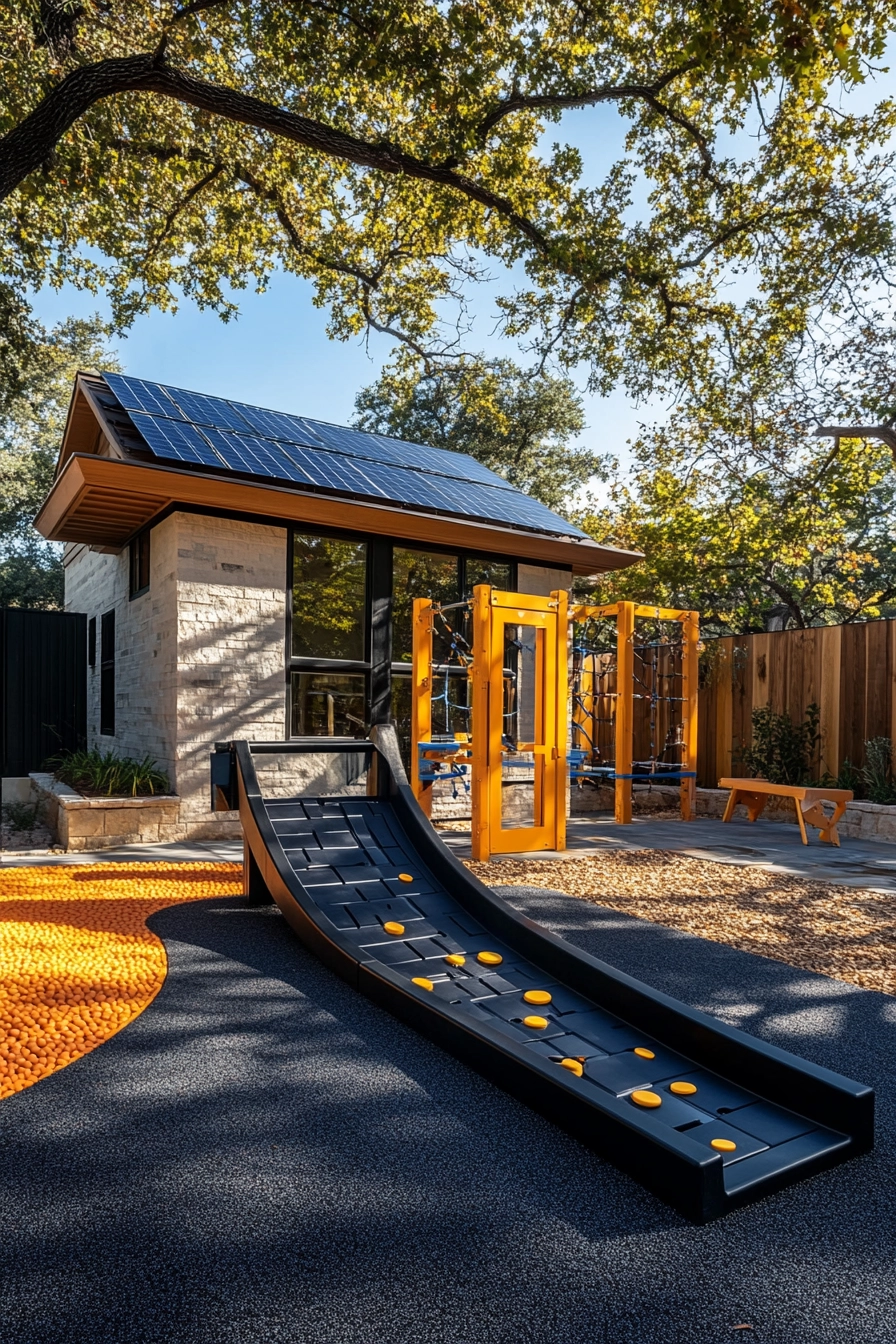

8. Sensory Garden Design
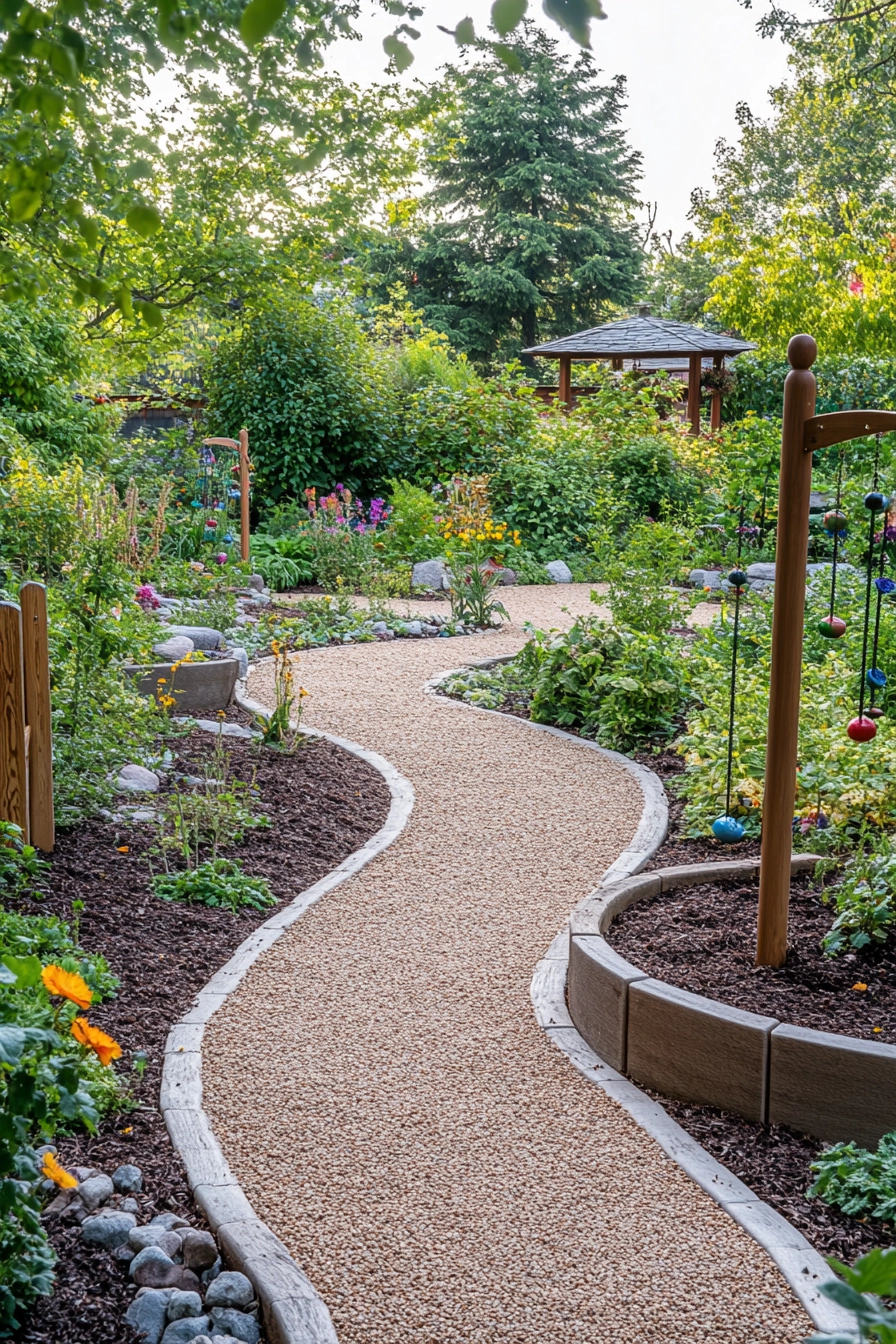
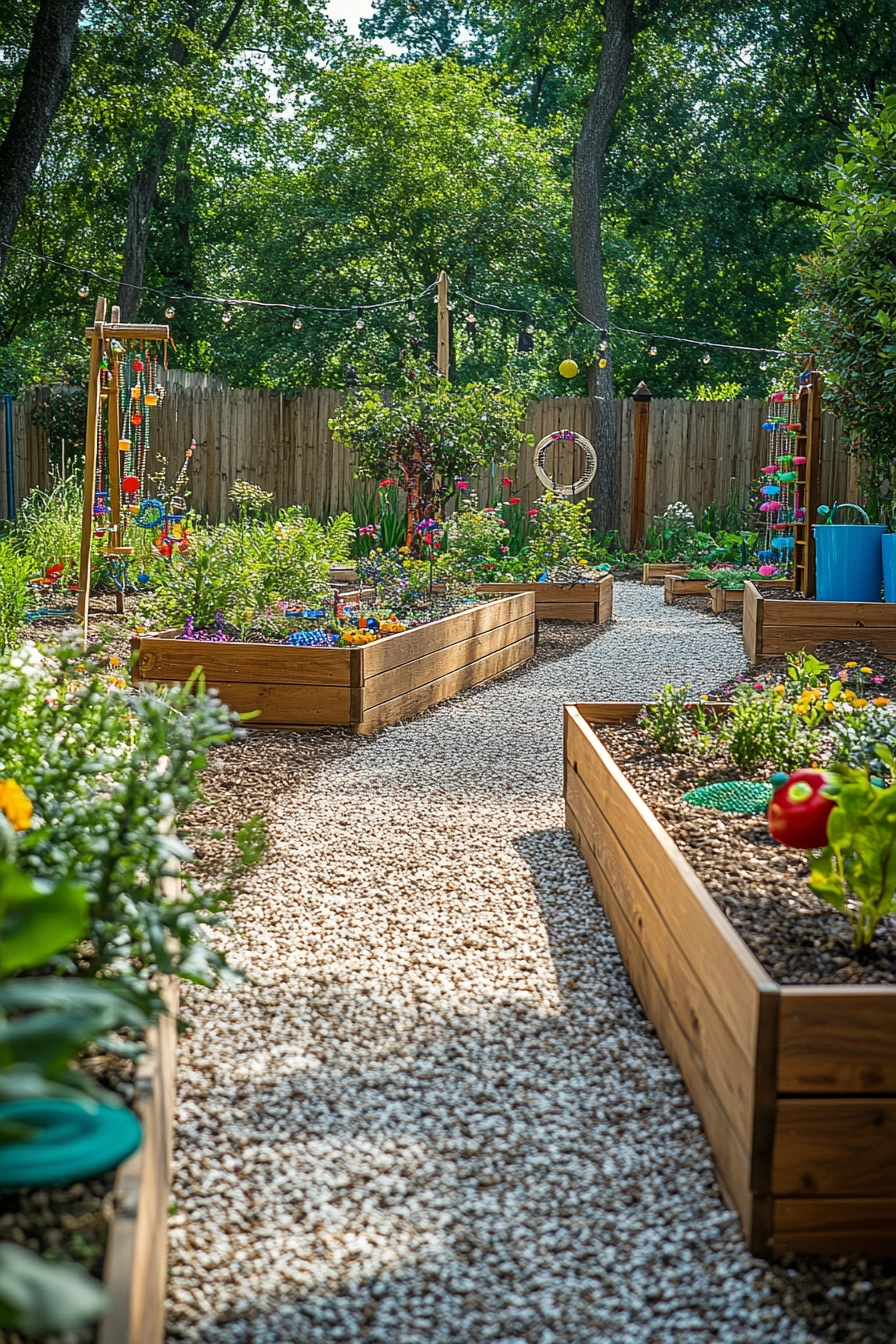
This backyard concept features a sensory garden design, providing an immersive experience for children. A textured walking path guides kids through the garden, while wind chimes and musical elements encourage auditory exploration.
Raised planter beds with child-height gardening areas allow kids to engage in hands-on gardening, fostering a sense of responsibility and connection to nature. The soft color palette creates a calming atmosphere, ideal for both play and relaxation.
The inclusive design of the sensory garden ensures that children of all abilities can engage with the space. Natural lighting enhances the vibrant colors and textures, inviting children to explore and discover.
This garden is not just a play area but a sanctuary that promotes sensory development and well-being.
- Incorporate a variety of plants with different textures, colors, and scents.
- Design pathways that are accessible for all children.
- Include interactive elements like musical instruments for added sensory stimulation.
- Plan for shaded areas to provide comfort during hot days.
- Encourage seasonal planting to keep the garden fresh and exciting.
Pro Design Tip: Organize sensory play dates to create community engagement and shared learning experiences.
Budget Consideration: Growing plants from seeds or cuttings can help reduce costs while creating a unique garden.
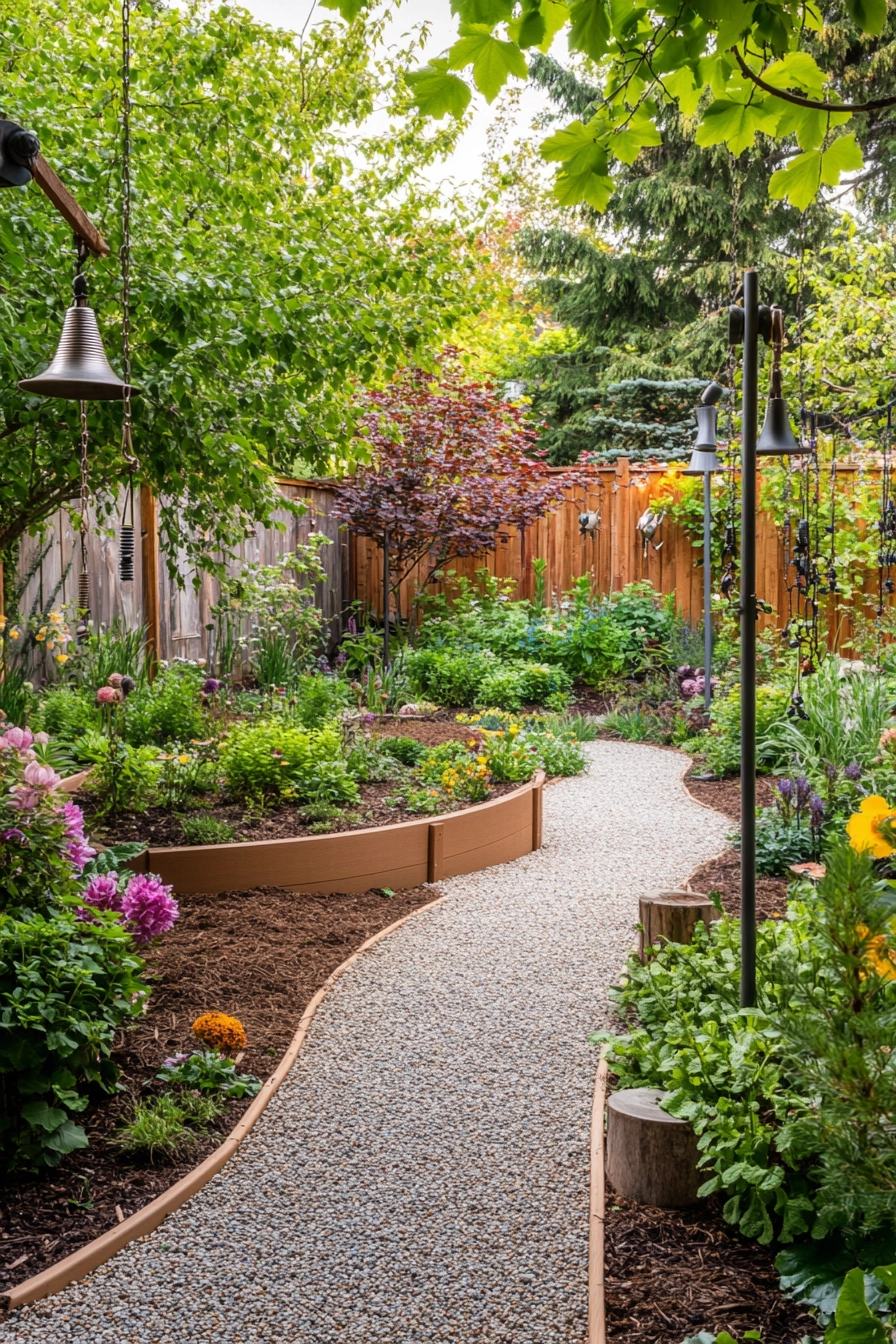
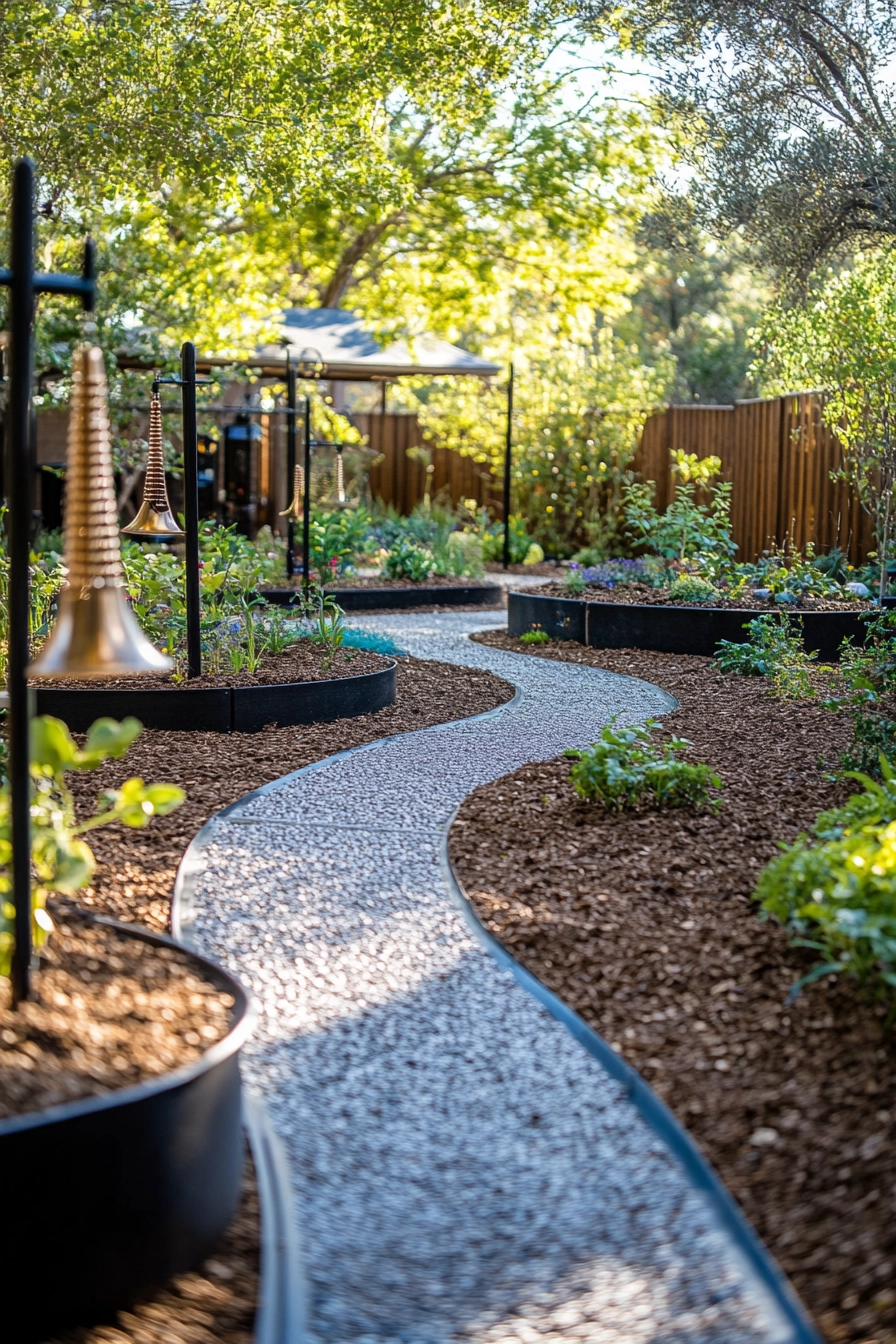
9. Compact Obstacle Course
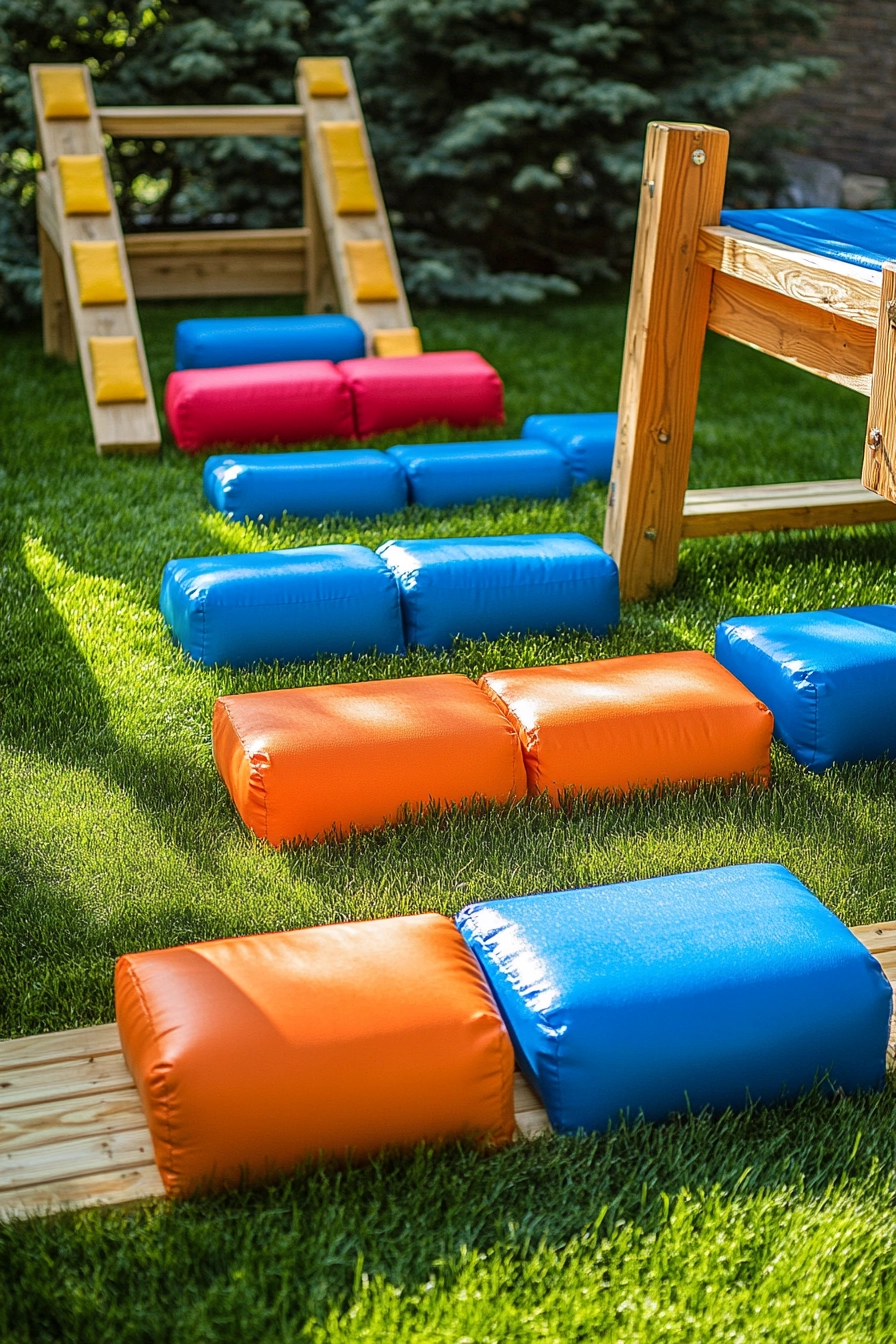
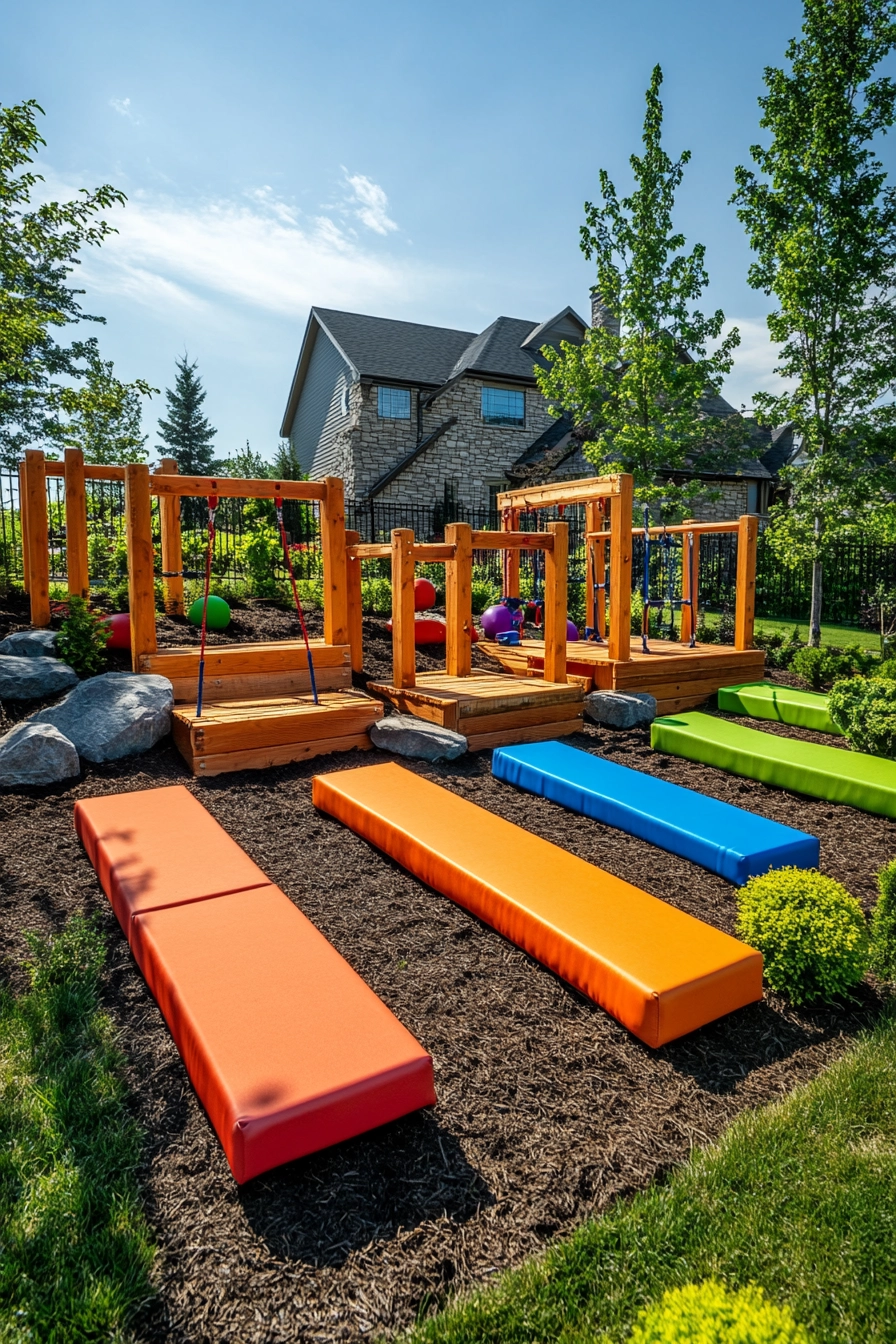
This small backyard idea focuses on creating a compact obstacle course that challenges kids physically and mentally. Ninja-style training elements, low-height challenges, and safety padding in bright colors make this space a fun and exciting environment for active play.
Sustainable wooden structures ensure durability, while integrated fitness zones promote healthy habits from a young age.
The professional sports photography perspective captures the energy and excitement of children navigating the various obstacles. This design not only provides a playground but also fosters teamwork and perseverance as kids tackle challenges together.
- Incorporate a variety of challenges to cater to different skill levels.
- Design pathways that connect obstacles for a cohesive experience.
- Ensure all materials are safe and weather-resistant.
- Plan for regular updates to keep the course engaging and challenging.
- Use bright colors to create an energizing atmosphere.
Pro Design Tip: Organize friendly competitions to encourage teamwork and community spirit.
Budget Consideration: DIY obstacle course elements can significantly reduce costs while promoting creativity.
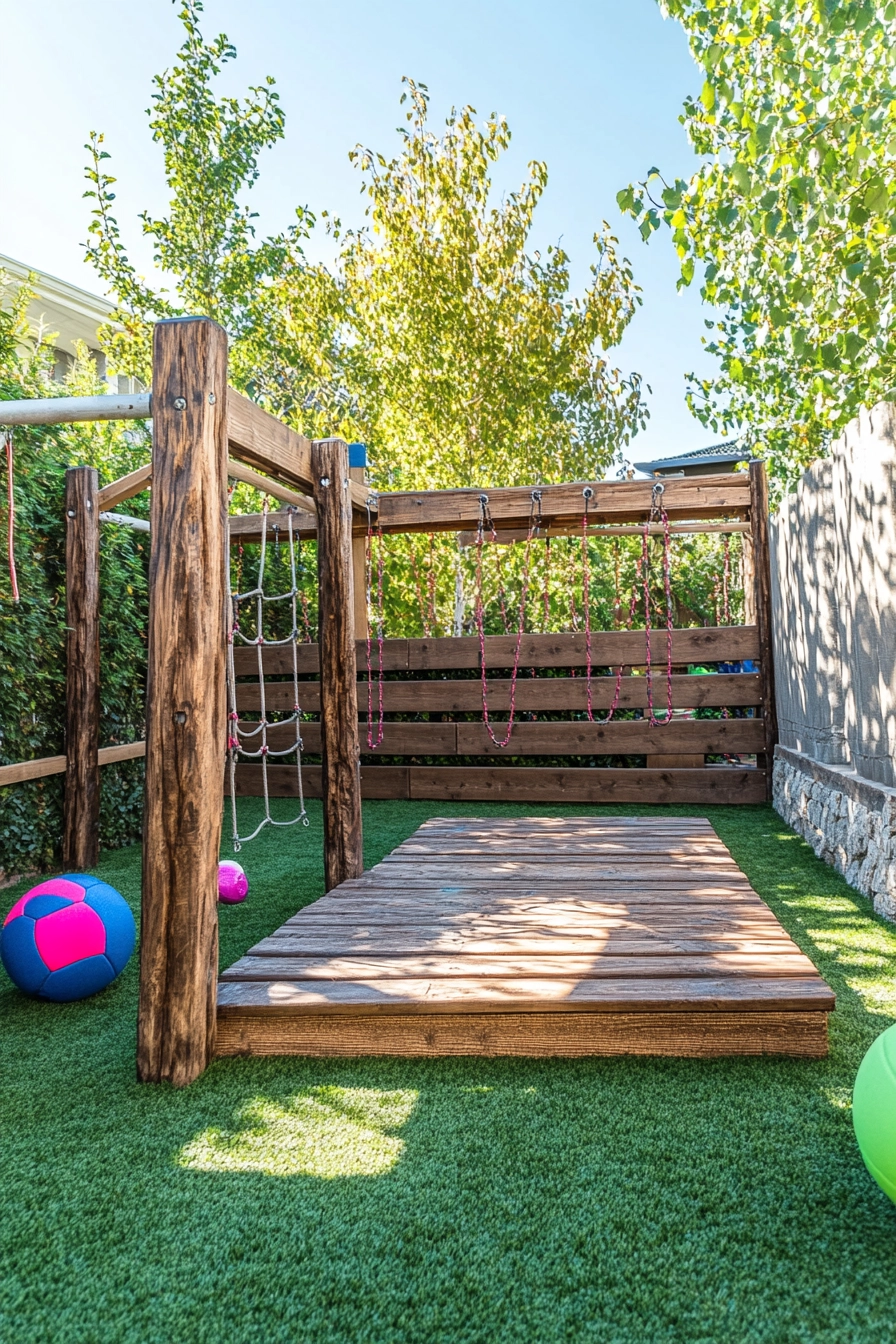
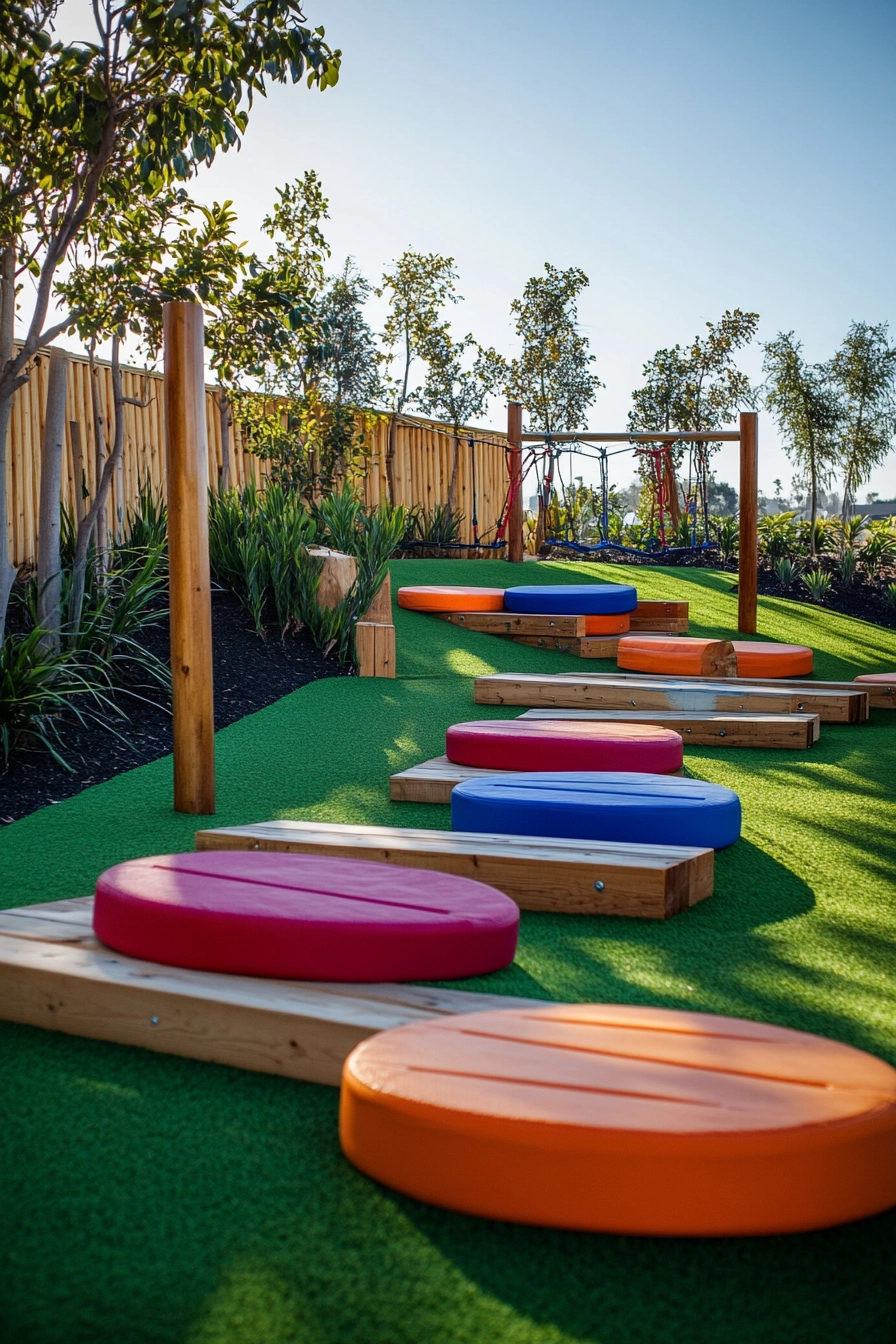
10. Art and Creativity Zone
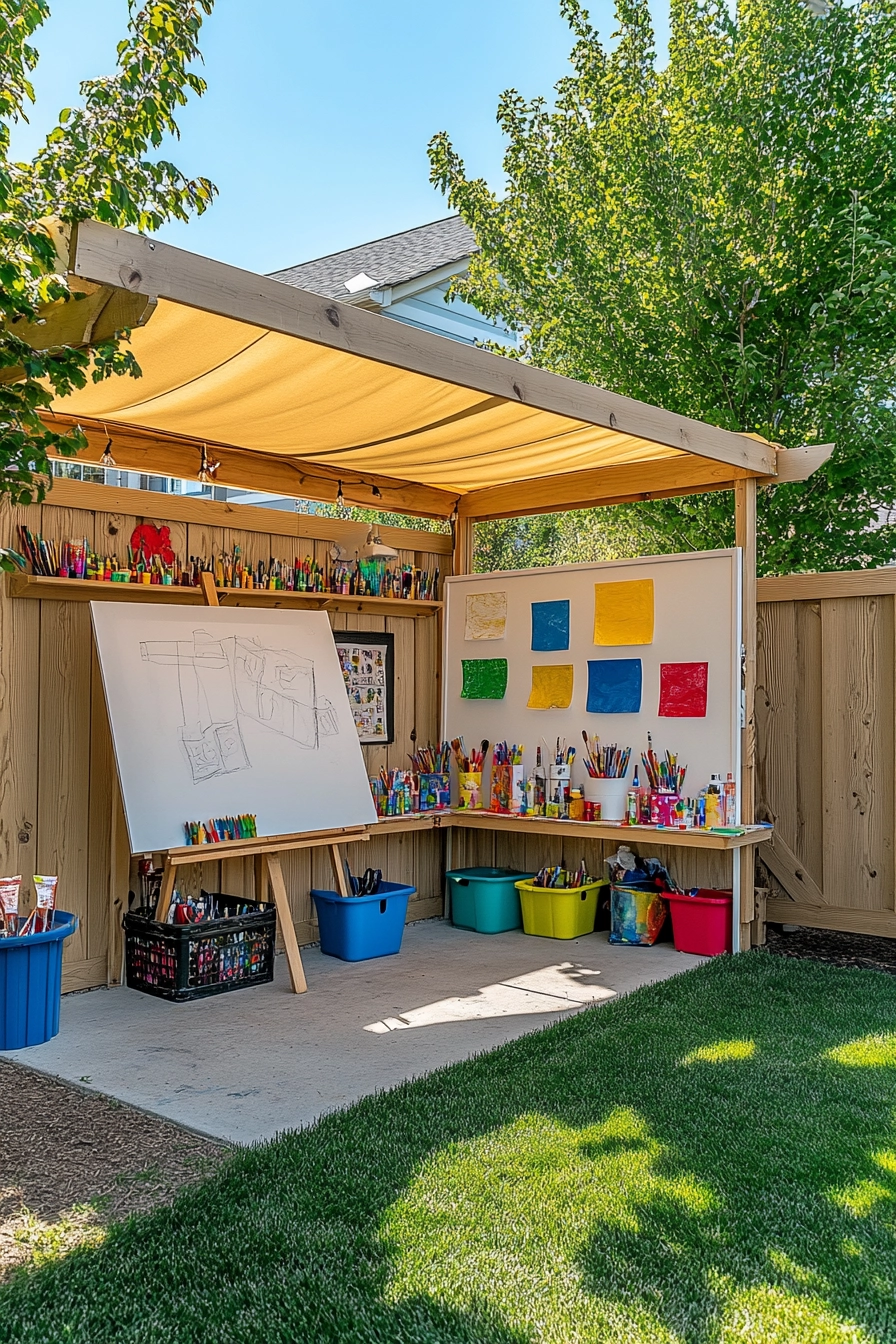

This backyard concept presents an art and creativity zone designed to inspire young artists. An outdoor easel station, washable wall surfaces, and storage for art supplies create an organized and inviting space for creative expression.
A covered area with adjustable shade ensures that children can paint and craft regardless of the weather, while a bright, inspiring color scheme adds to the joy of artistic exploration.
Natural light enhances the creative process, while the overall design promotes a sense of freedom and imagination. This area serves as a sanctuary for kids to express themselves through art, while also providing parents with a comfortable space to oversee their activities.
- Choose weather-resistant materials for outdoor art supplies and structures.
- Incorporate storage solutions that keep the area tidy and organized.
- Design the space for easy access to natural light.
- Include a variety of art mediums to encourage diverse creativity.
- Host art-themed workshops to foster community engagement.
Pro Design Tip: Set up an art showcase to display children’s creations, encouraging pride in their work.
Budget Consideration: Utilize recyclables and natural materials for DIY art projects to save on costs.
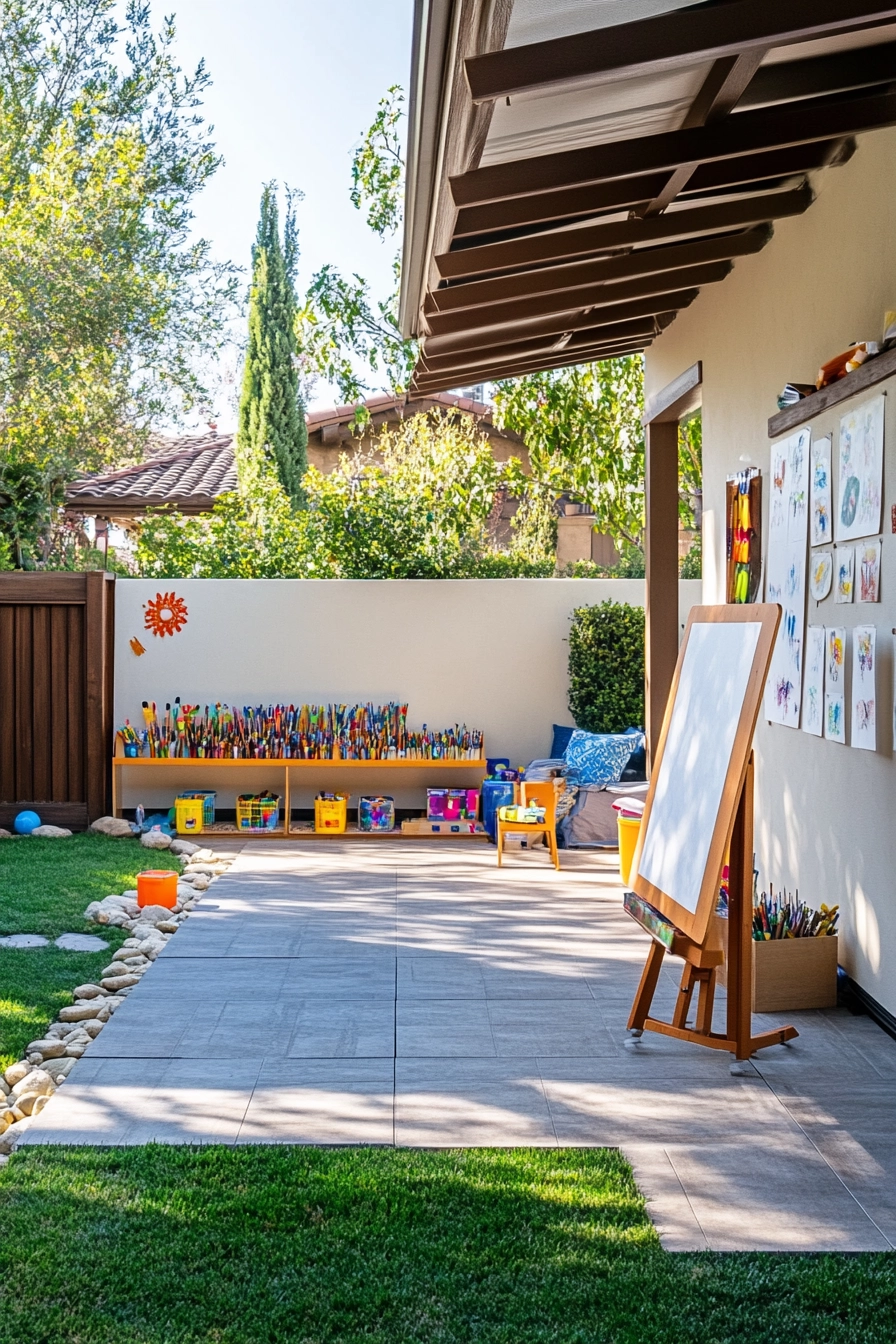
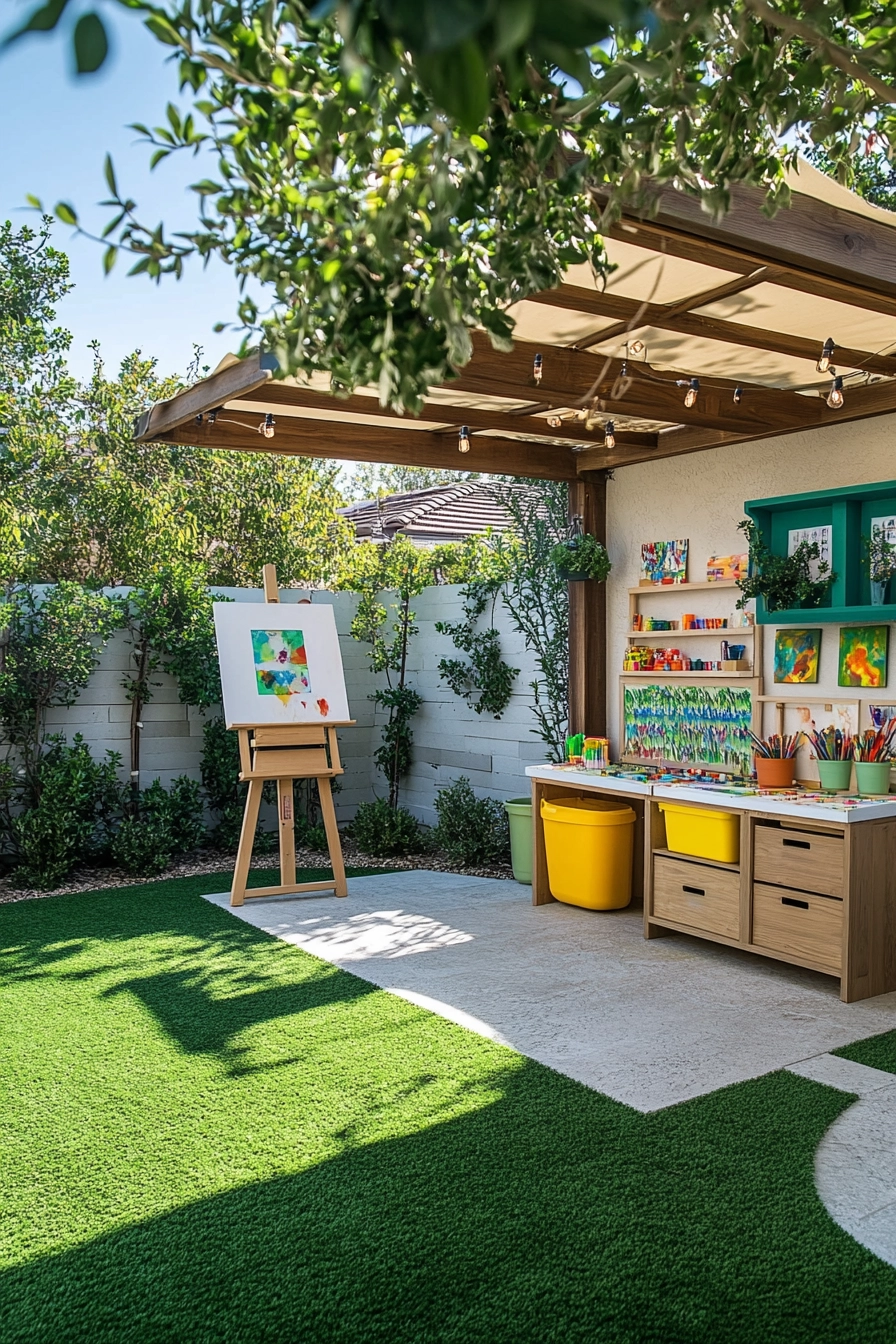
11. Sustainable Ecological Play Space
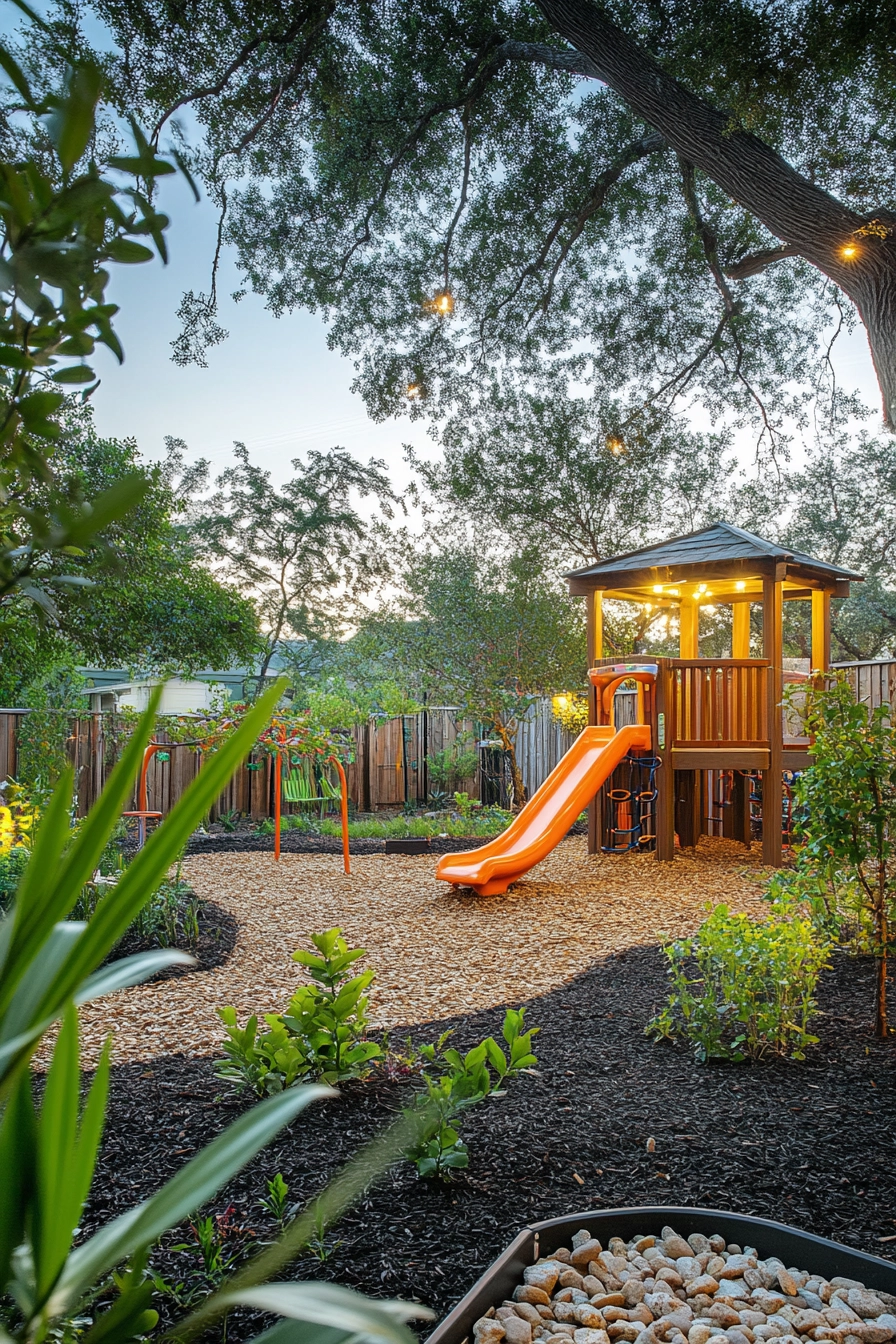
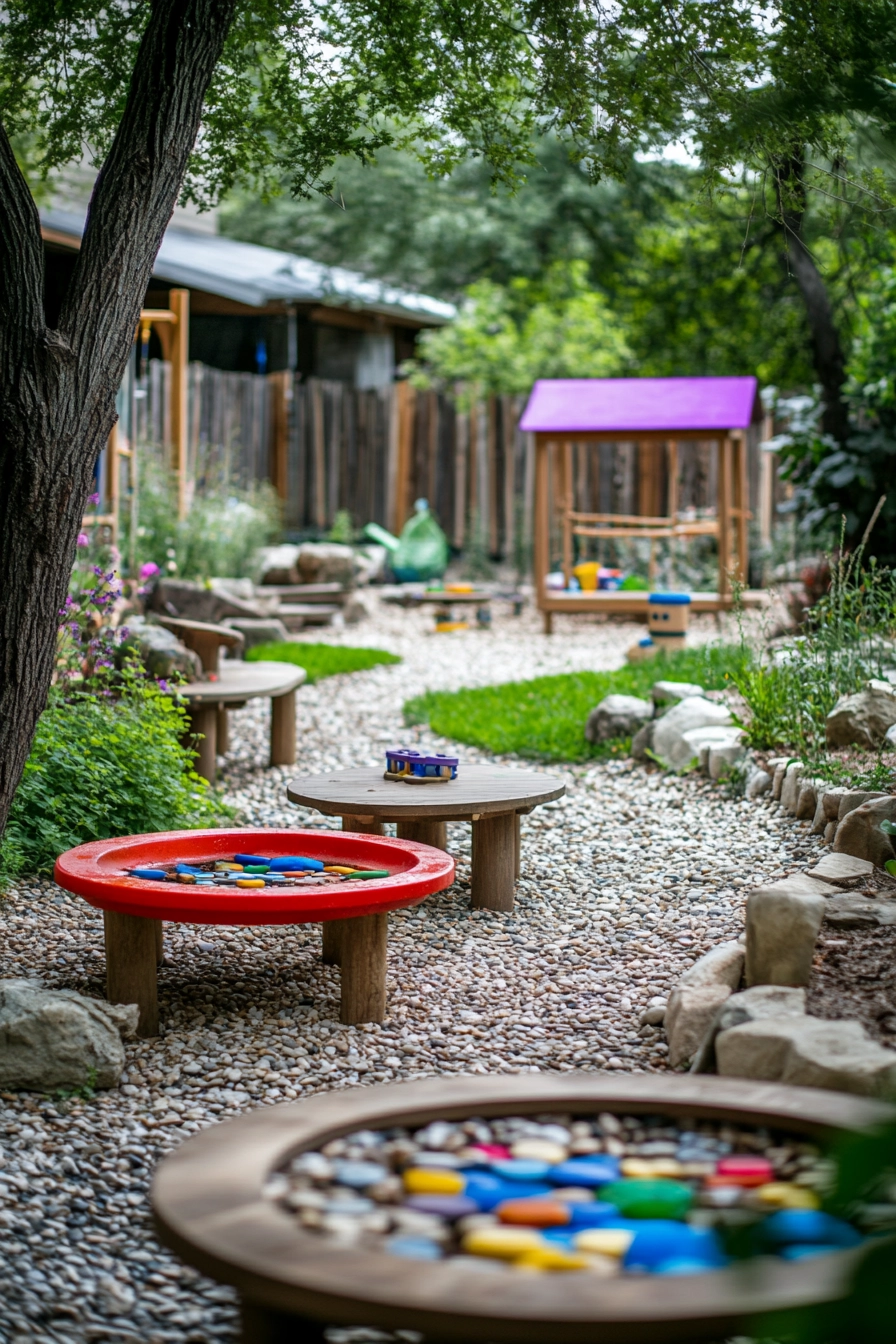
This small backyard idea centers around a sustainable ecological play space that teaches children about the environment while they play. Recycled material play structures invite children to explore and engage in active play, while a rainwater collection system promotes conservation practices.
Surrounding the play area is a native pollinator garden that enhances biodiversity and provides a real-life learning experience about ecosystems.
The educational environmental design of this playground encourages kids to become stewards of the earth. The wide-angle landscape photography captures the beauty and functionality of the space, showcasing how play and nature can coexist harmoniously.
- Incorporate educational signage about recycling and conservation.
- Design play structures with reclaimed materials for sustainability.
- Utilize native plants to create a low-maintenance environment.
- Plan for interactive learning opportunities to engage children.
- Encourage community involvement in maintaining the garden.
Pro Design Tip: Host eco-friendly workshops to educate kids about sustainability and environmental care.
Budget Consideration: Using reclaimed materials for play structures can significantly reduce costs while promoting sustainability.

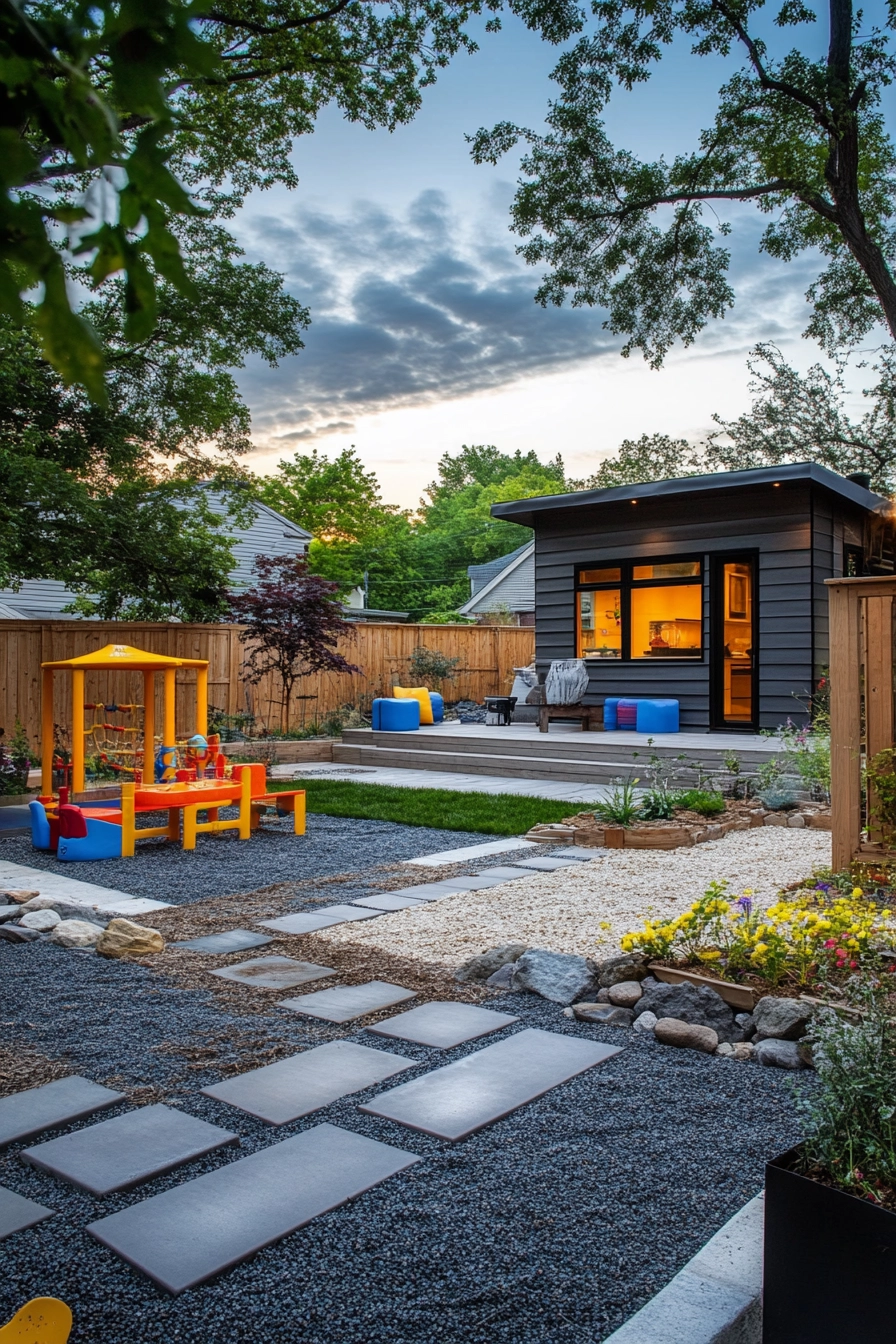
12. Compact Gymnastics Training Area
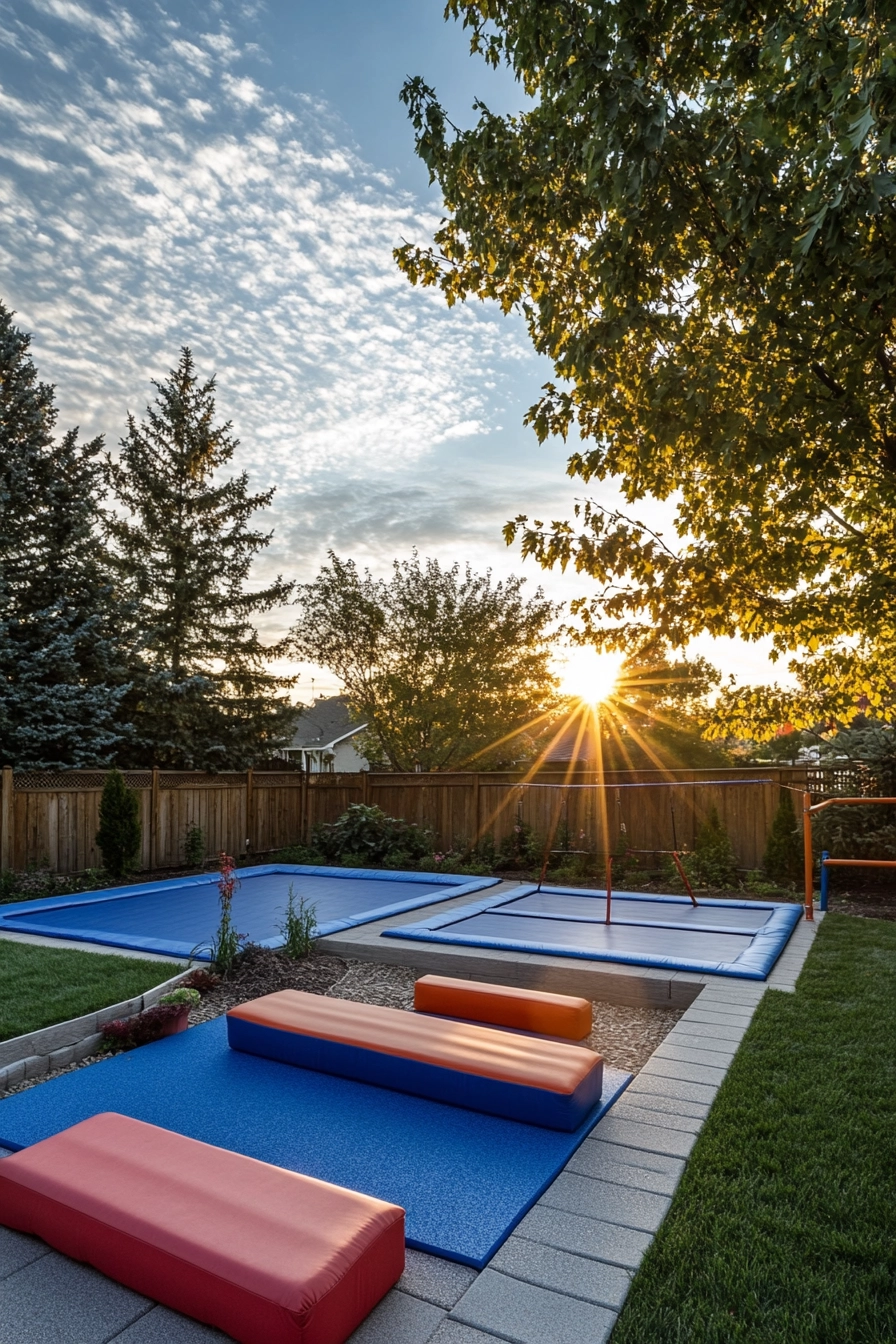
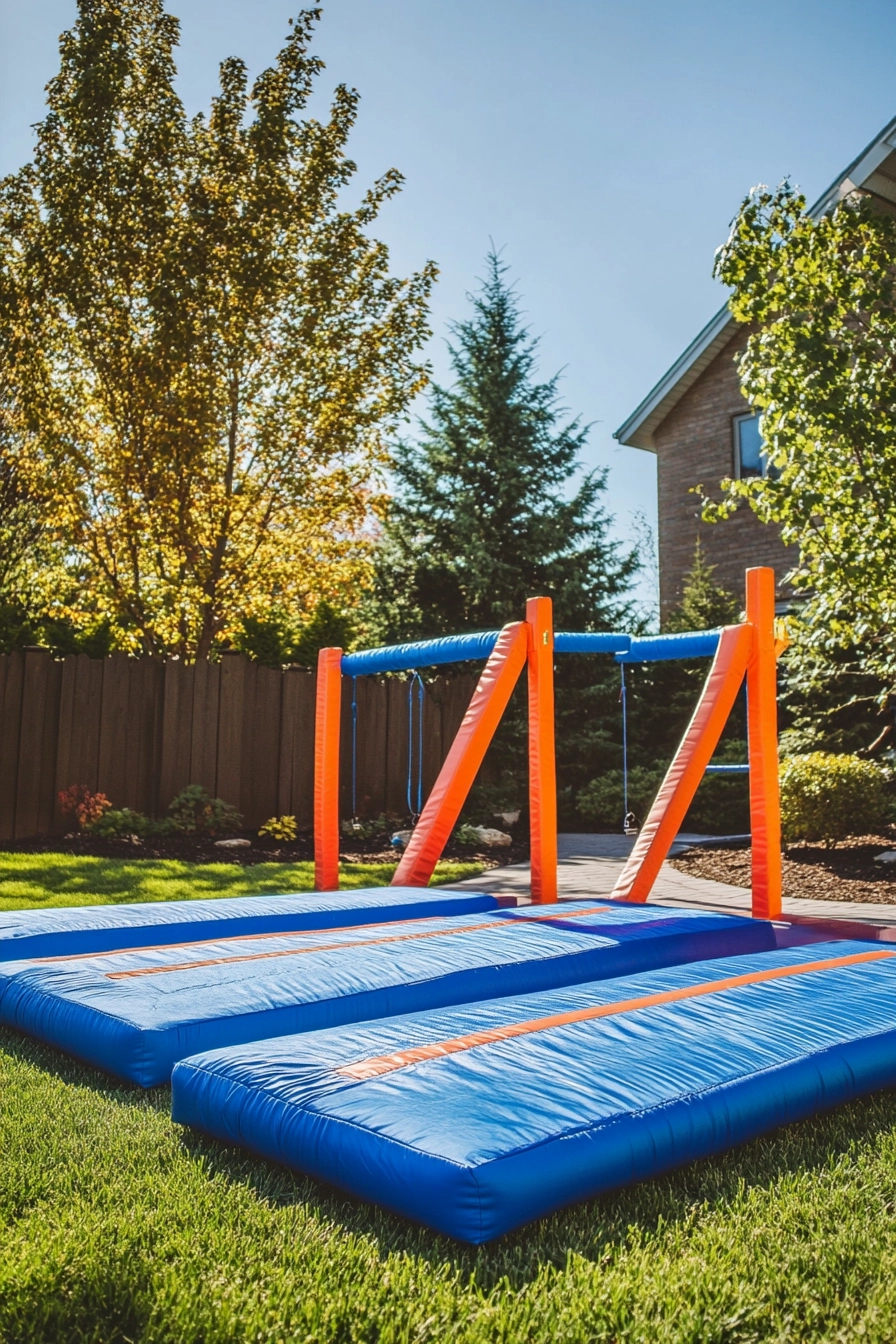
This backyard idea showcases a compact gymnastics training area designed for young athletes. Soft landing zones, adjustable balance beams, and mini trampolines provide a safe and engaging environment for children to develop their skills.
The use of neutral safety surfaces ensures that the space remains clean and organized while promoting active play.
The professional-grade equipment emphasizes quality and safety, allowing kids to train effectively while having fun. The overall design encourages physical fitness and confidence-building as children practice their gymnastics routines in a supportive environment.
- Incorporate soft mats for landing zones to ensure safety.
- Choose adjustable equipment to cater to various skill levels.
- Design the layout for easy visibility and supervision.
- Include a variety of equipment for a comprehensive training experience.
- Plan for regular competitions or showcases to encourage skill development.
Pro Design Tip: Offer gymnastics classes or workshops to encourage community involvement and skill-building.
Budget Consideration: Consider purchasing second-hand equipment to save on costs while maintaining quality.
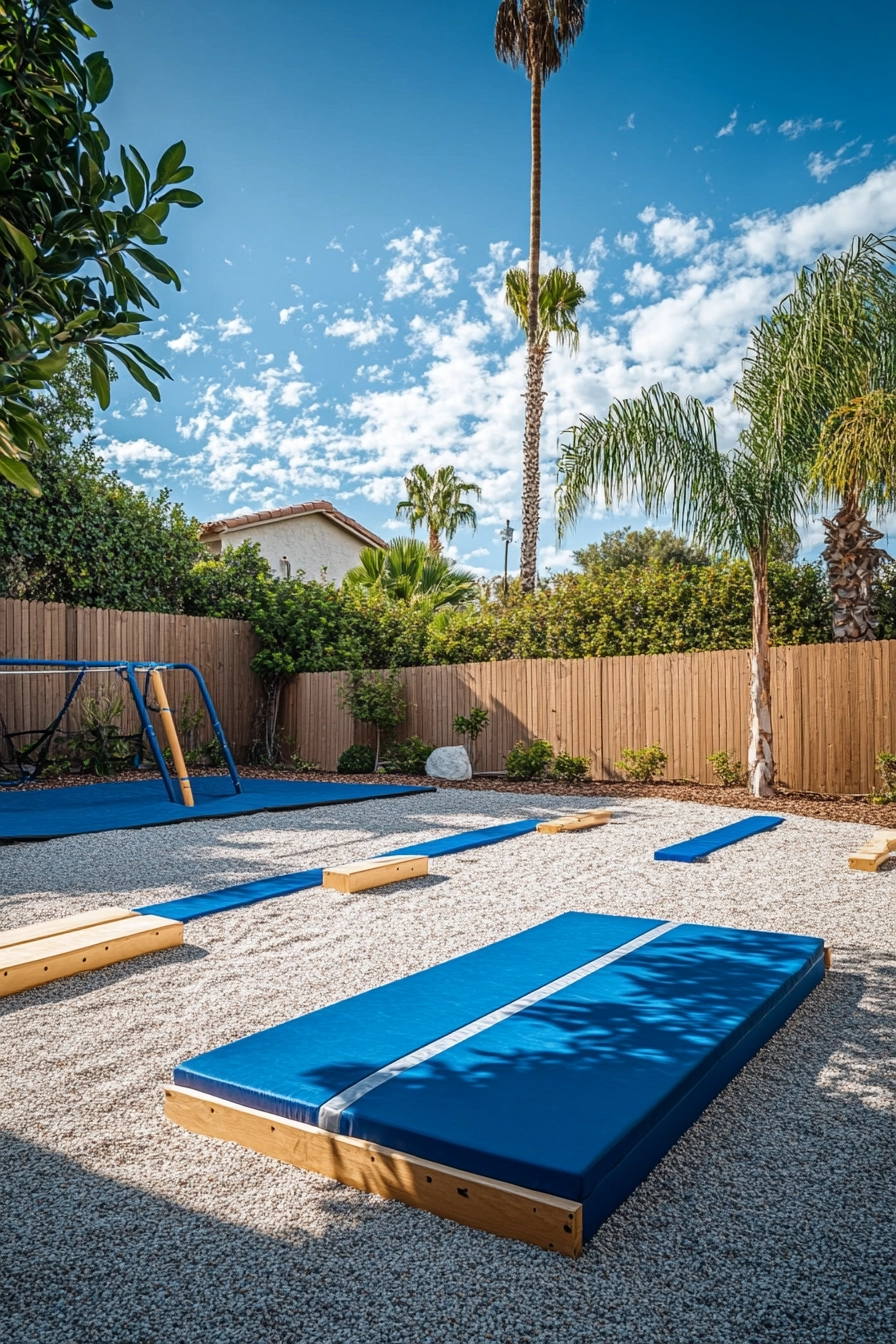
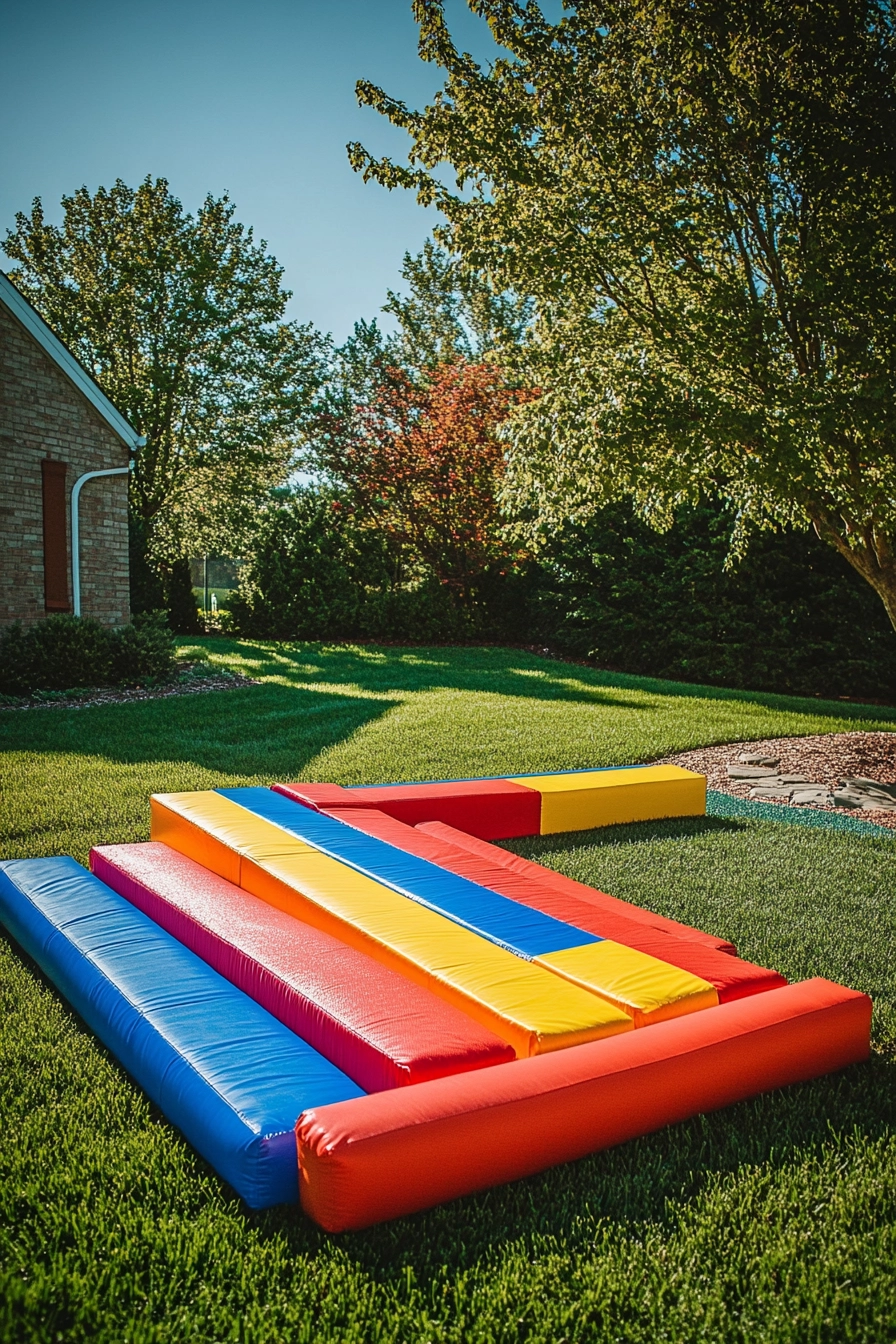
13. Musical Exploration Zone
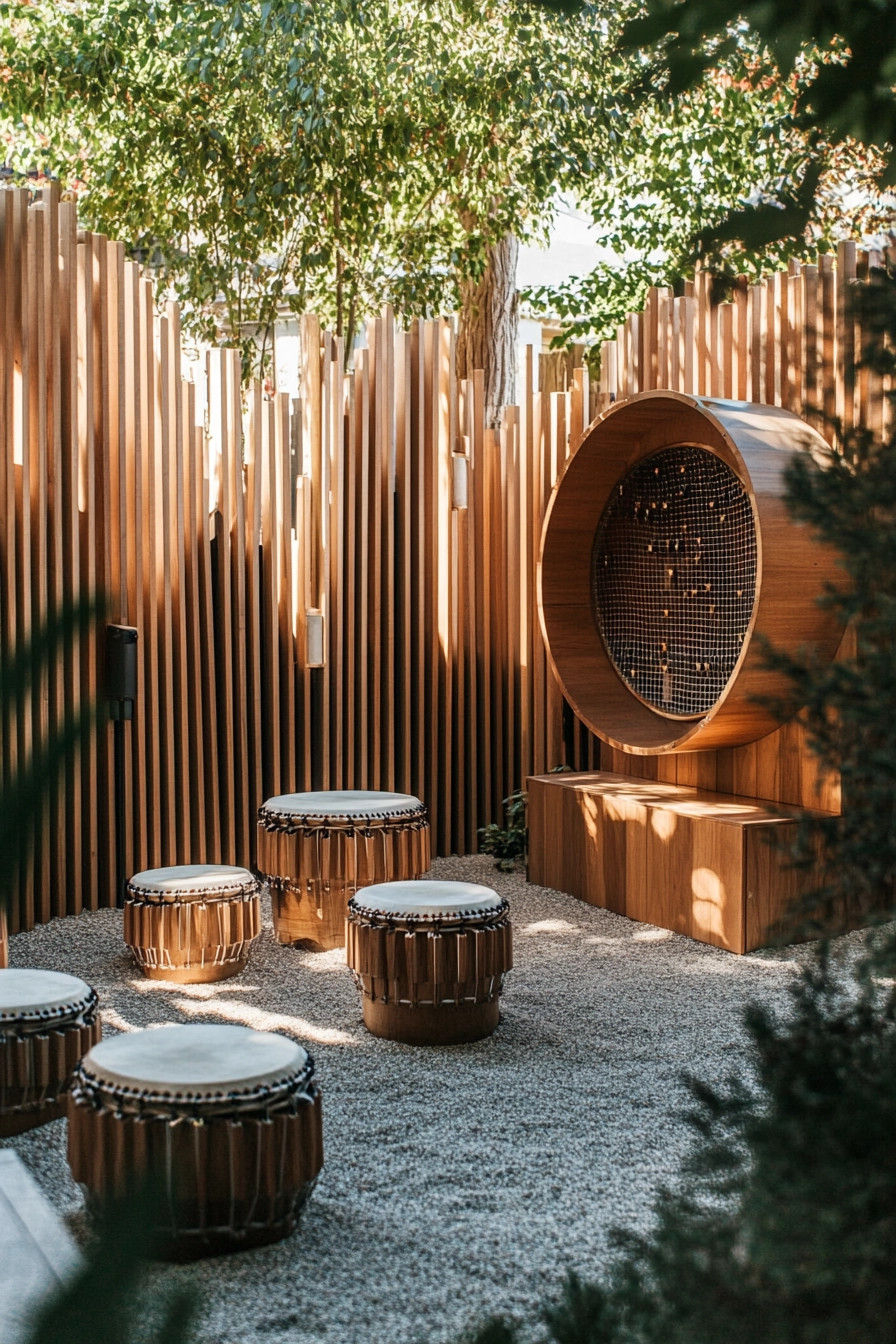

This backyard concept features a musical exploration zone that engages children in auditory play. Outdoor percussion instruments, wind-activated sound elements, and interactive musical walls create a dynamic space where kids can experiment with sound and rhythm.
Natural wood structures enhance the aesthetic while promoting tactile exploration.
The soft ambient lighting adds to the calming atmosphere, encouraging creativity and collaboration among children. This design not only nurtures a love for music but also provides a unique sensory experience that enriches playtime.
- Incorporate a variety of musical instruments for diverse sound experiences.
- Design pathways that encourage exploration and creativity.
- Use weather-resistant materials for all musical elements.
- Plan for seasonal performances to showcase children’s musical talents.
- Encourage collaboration by designing spaces for group play.
Pro Design Tip: Create a themed music day where children can showcase their compositions and performances.
Budget Consideration: DIY musical instruments using household items can provide cost-effective solutions while promoting creativity.
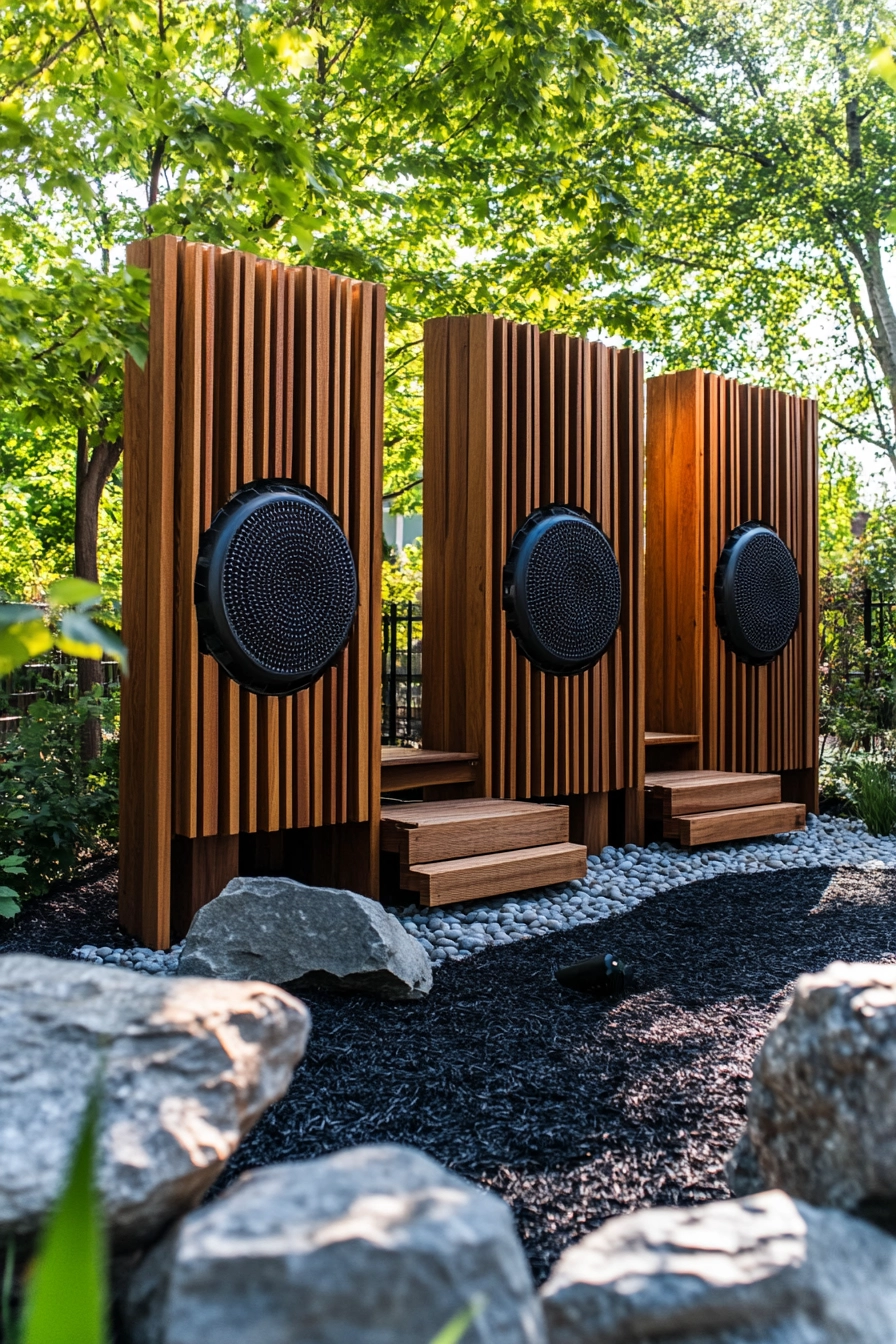
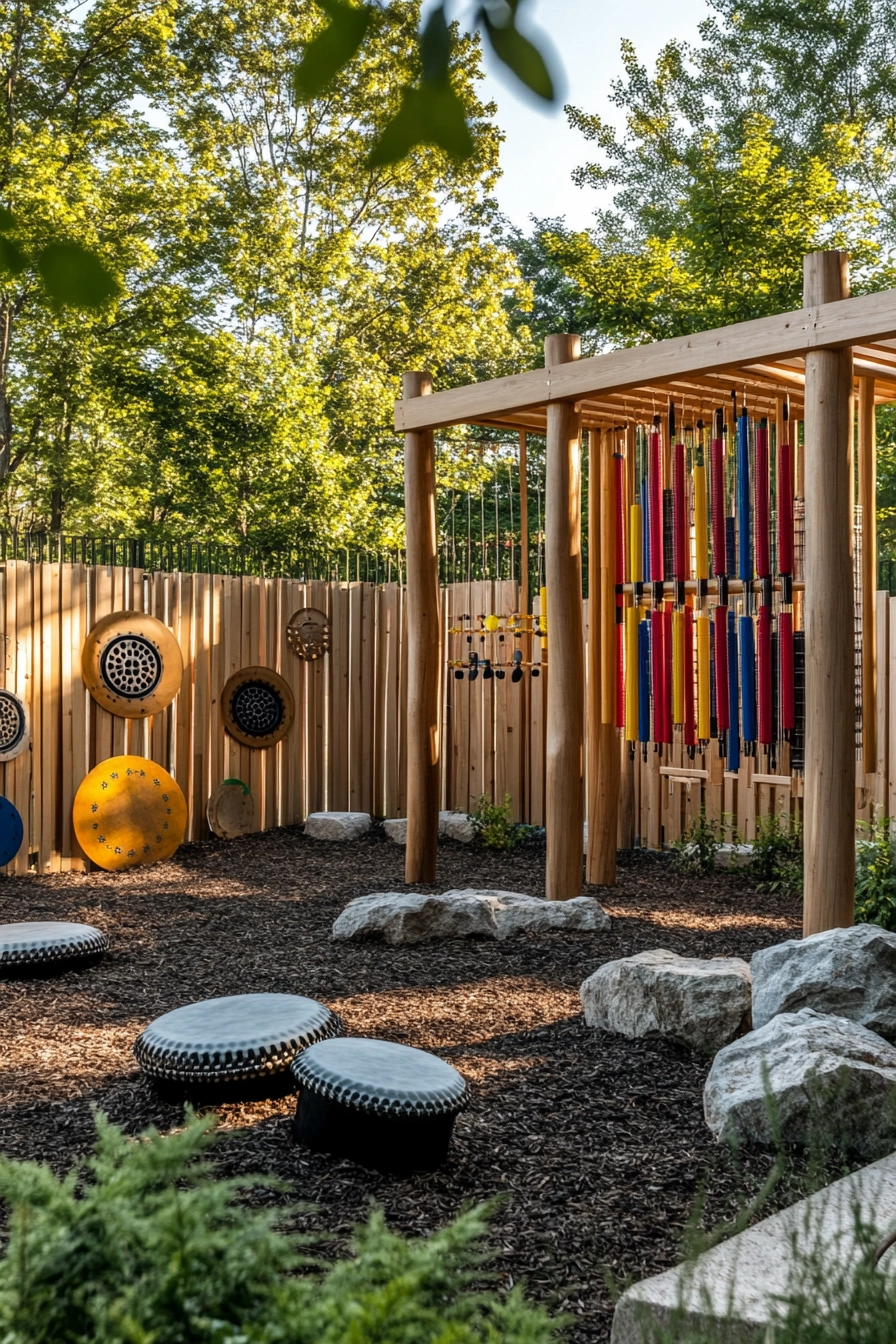
14. Compact Meditation and Yoga Space
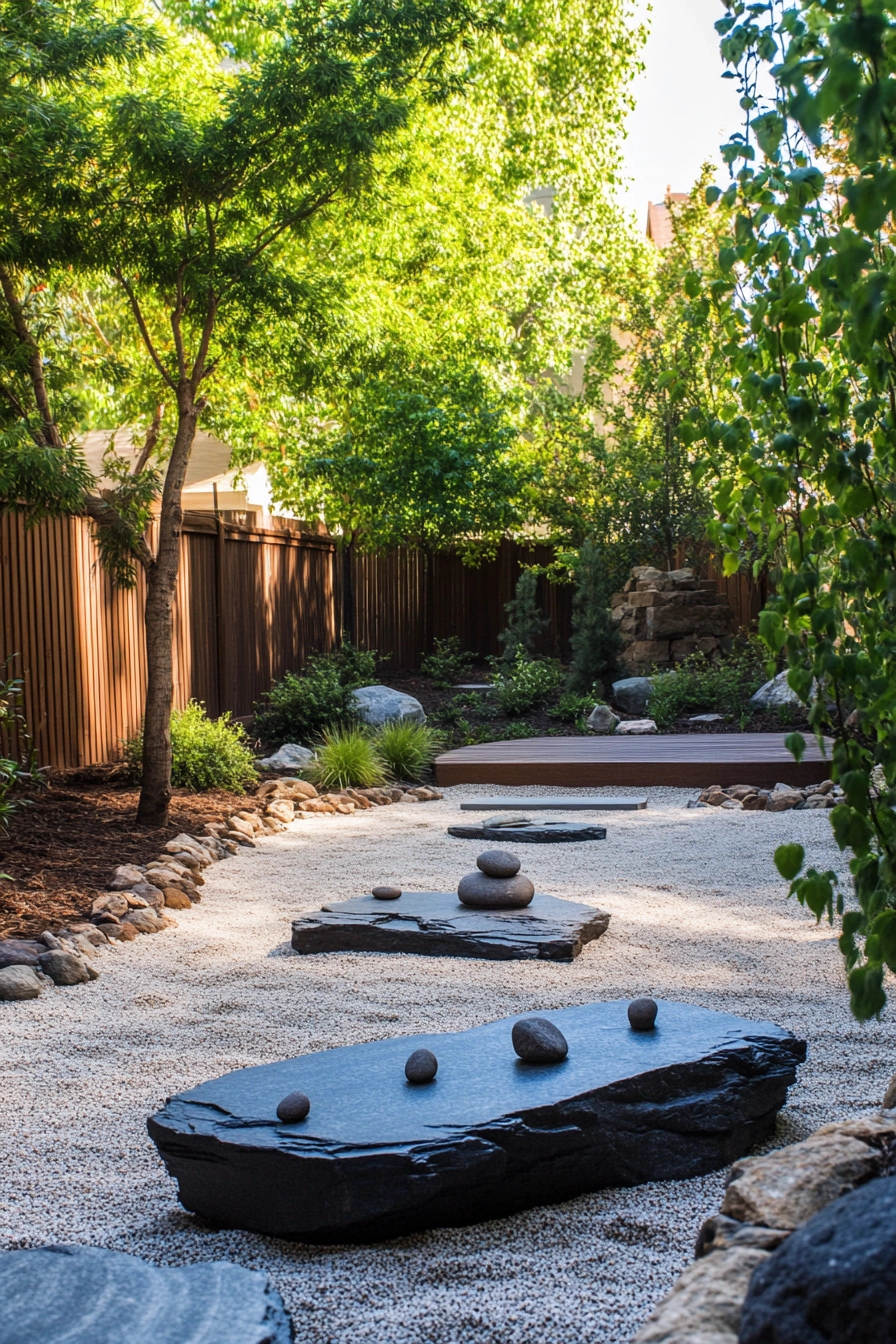
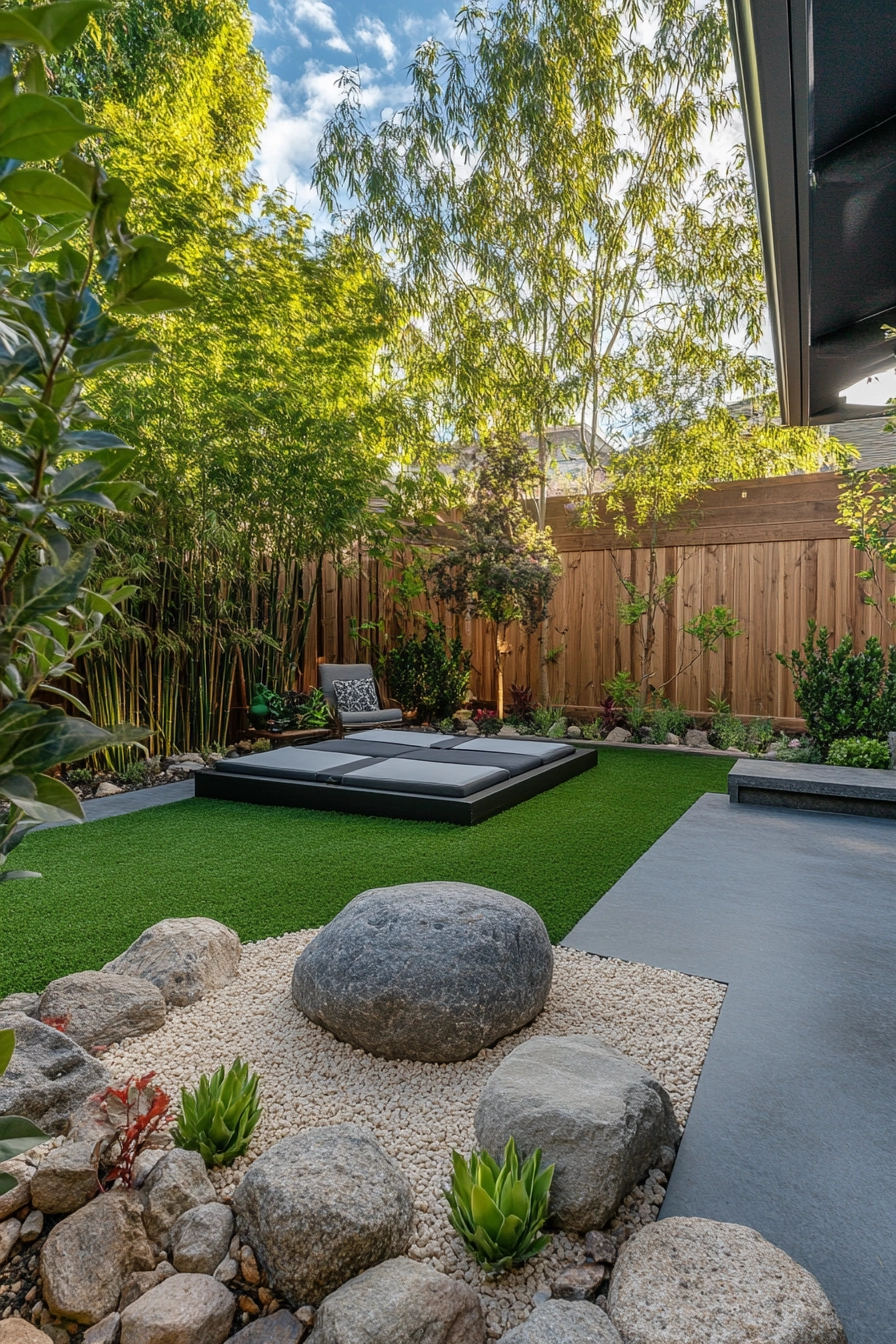
This small backyard idea presents a compact meditation and yoga space designed to promote mindfulness and relaxation. A zen-inspired design featuring soft ground surfaces and a miniature rock garden creates a peaceful atmosphere where children can learn to unwind.
Surrounding native plants enhance the tranquility of the area, while a calming color palette promotes a sense of well-being.
This design encourages children to develop mindfulness practices from a young age, fostering emotional intelligence and self-awareness. The overall ambiance invites reflection and relaxation, making it an ideal retreat within the backyard.
- Incorporate comfortable seating options for relaxation and meditation.
- Design pathways that promote tranquility and ease of movement.
- Use soft colors and natural materials to enhance the calming atmosphere.
- Plan for shaded areas to provide comfort during hot days.
- Encourage activities like yoga and meditation classes for community engagement.
Pro Design Tip: Organize mindfulness workshops to teach kids about meditation and relaxation techniques.
Budget Consideration: Creating a rock garden can be done on a budget with local stones and plants that thrive in your climate.
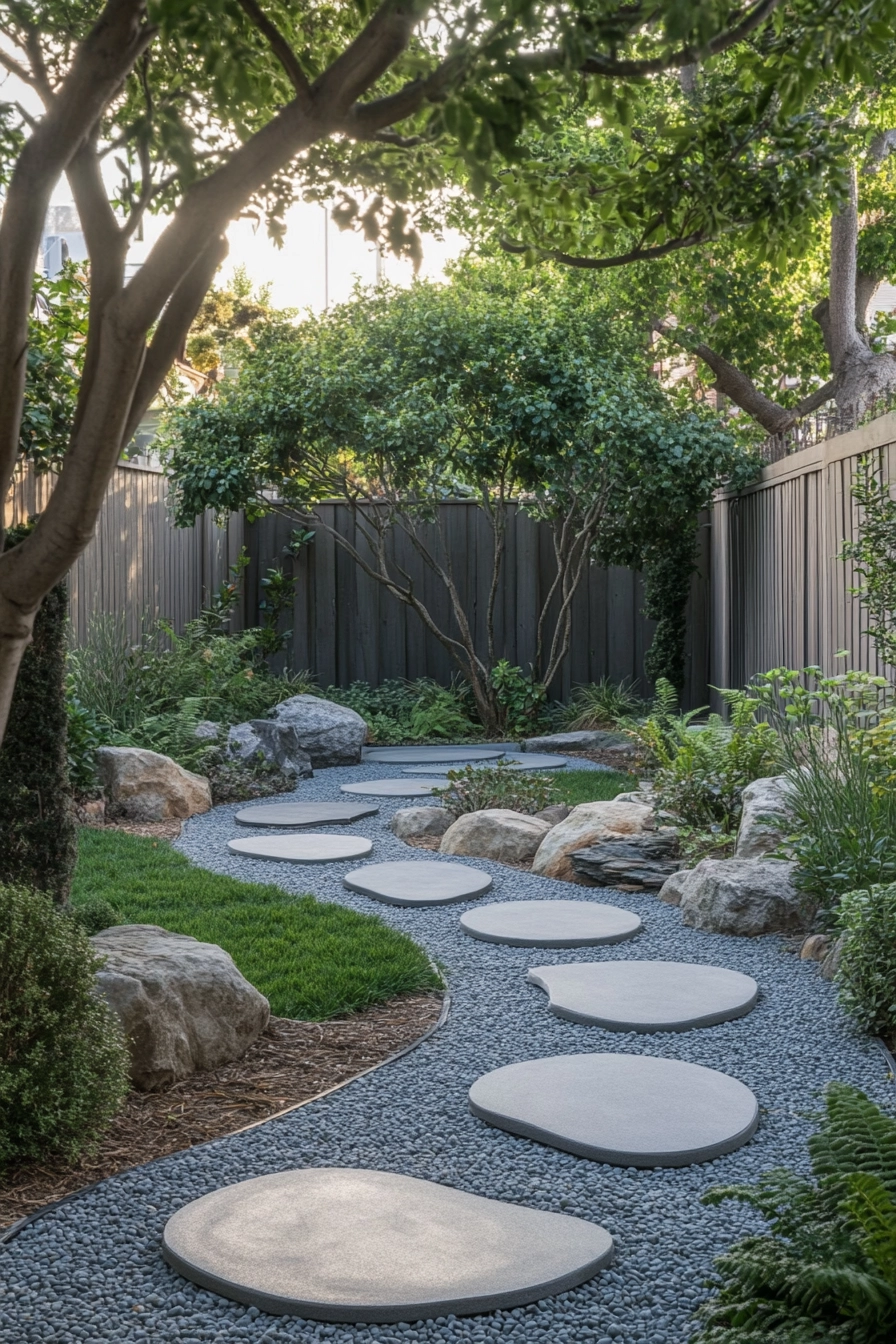
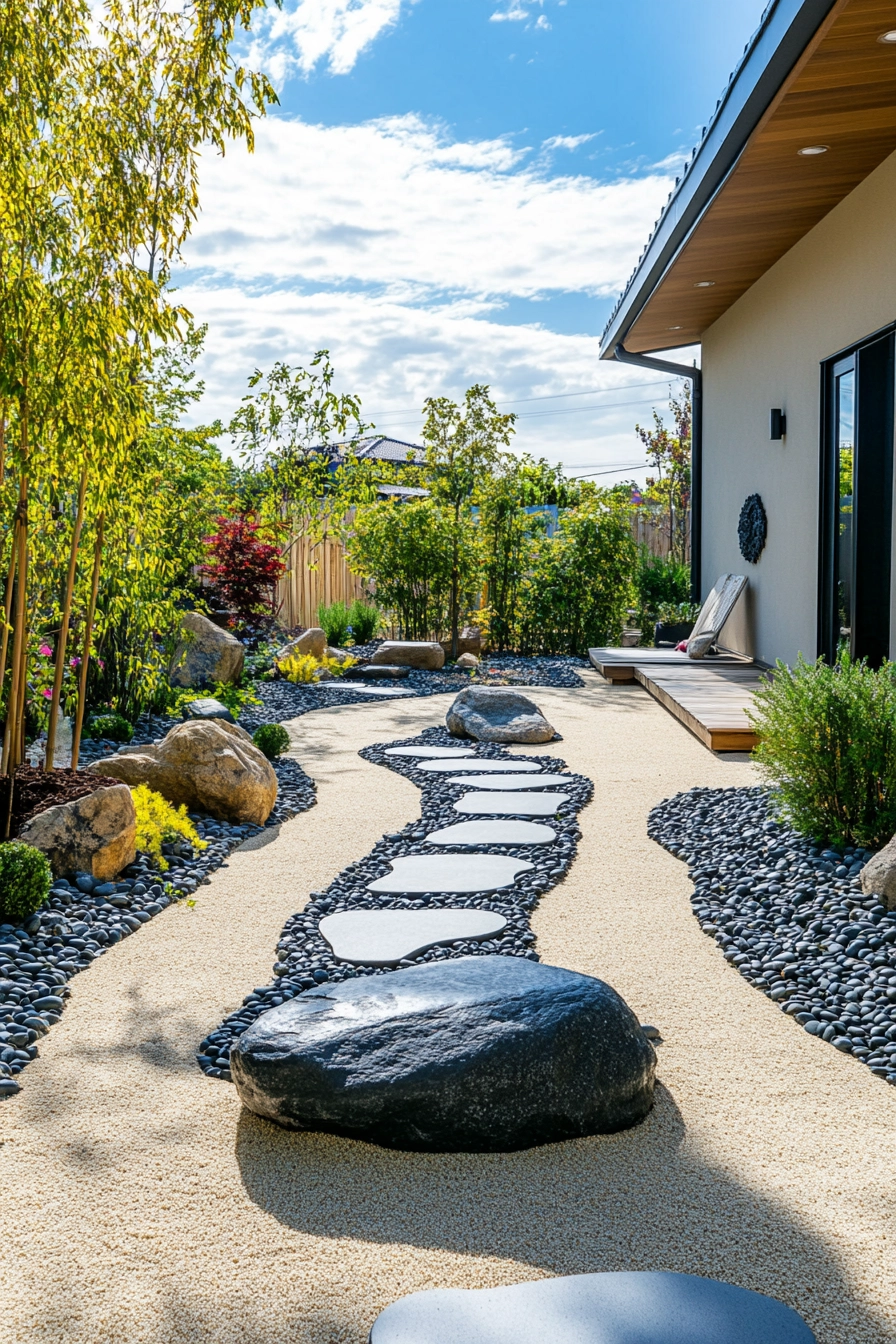
15. Technology Integration Zone
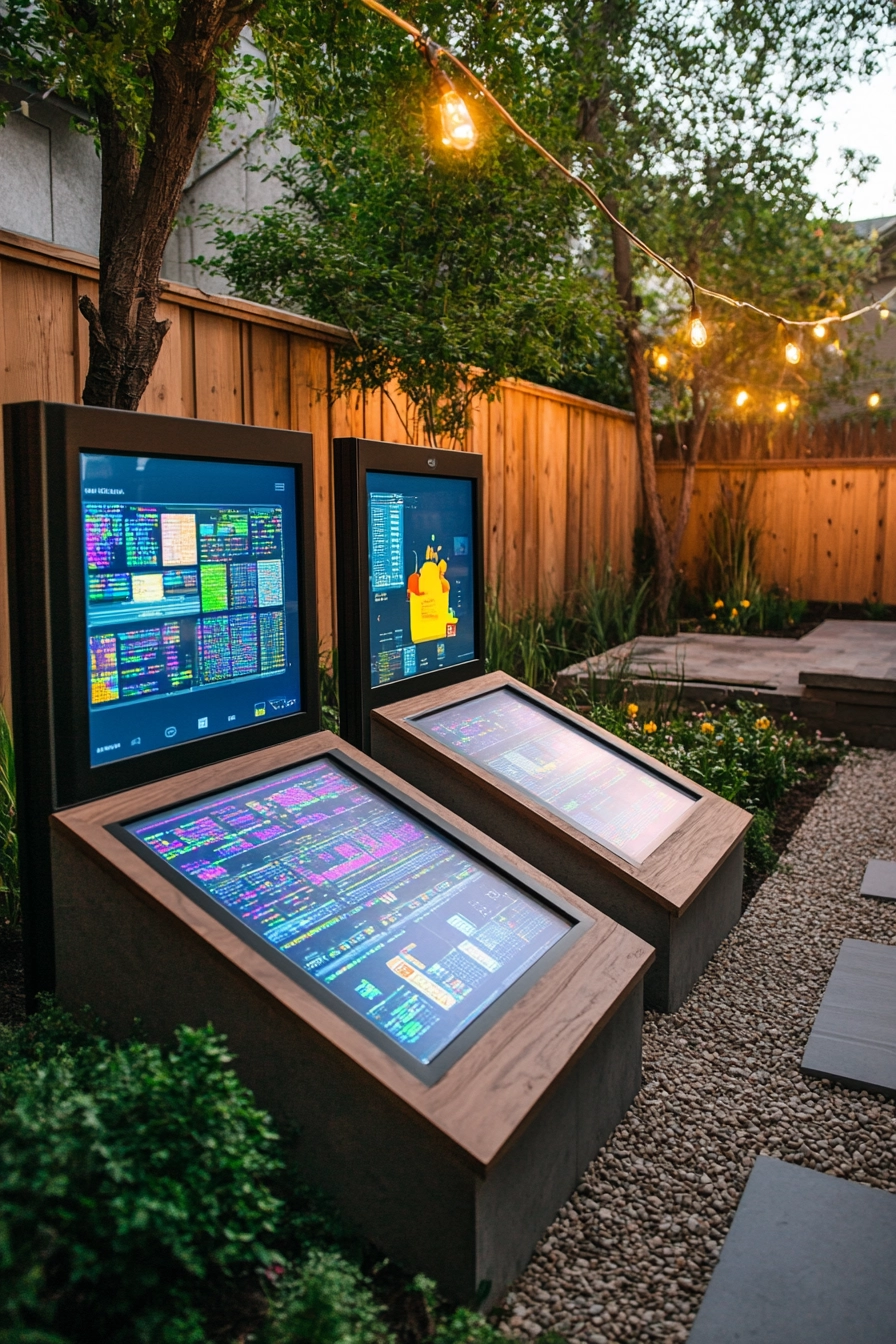
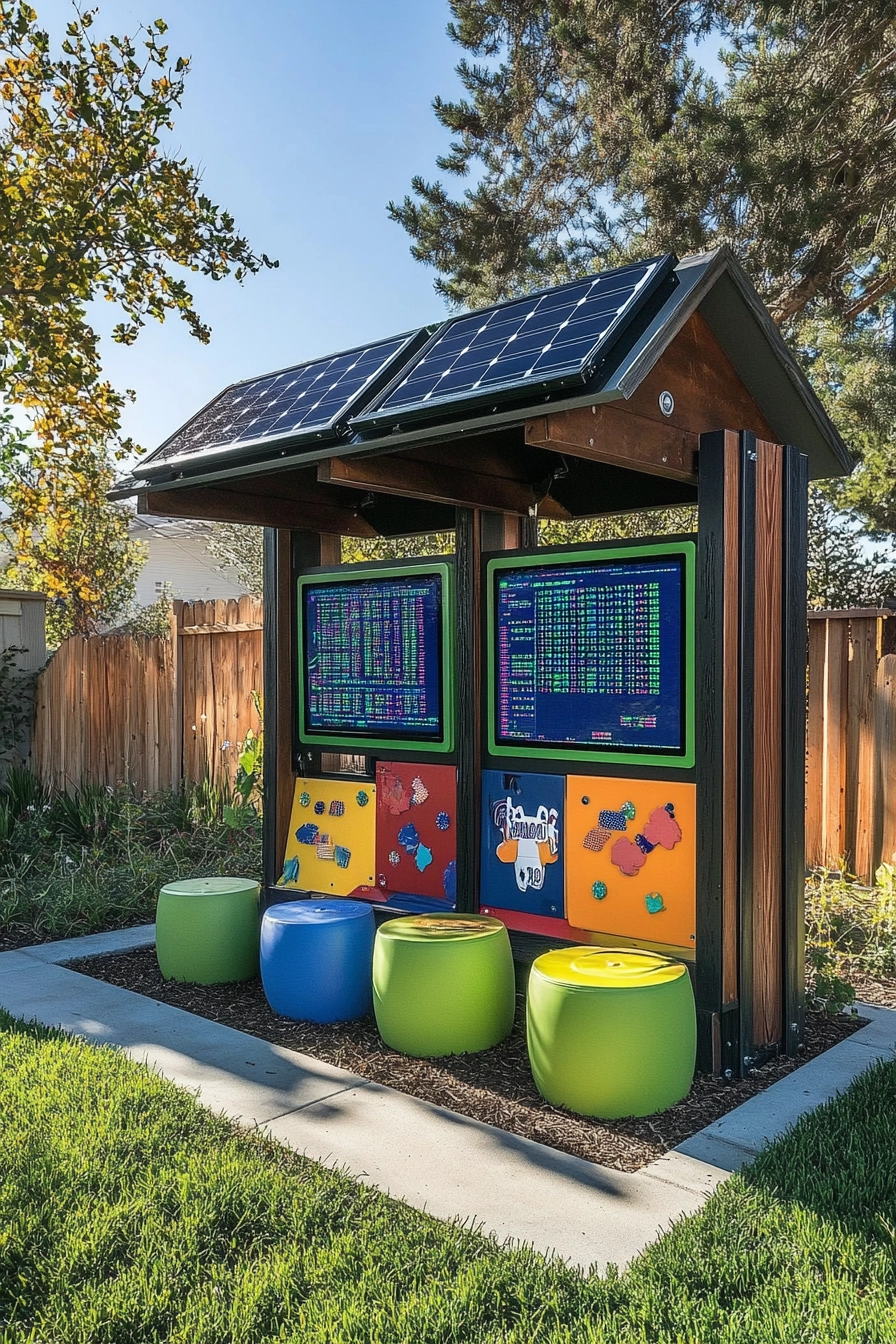
This backyard concept features a technology integration zone that embraces modern learning methods. Solar-powered interactive screens, coding stations, and outdoor digital learning elements provide children with opportunities to engage with technology while playing outside.
The modern minimalist design creates a clean and organized space that encourages focus and creativity.
By incorporating technology into play, this design prepares kids for future careers and enhances their problem-solving skills. The sleek aesthetics provide a visually appealing environment that parents can enjoy while their kids learn and explore.
- Integrate age-appropriate technology that promotes learning and creativity.
- Choose weather-resistant materials for all tech elements.
- Design spaces for collaboration and group learning.
- Plan for regular updates to keep technology current and engaging.
- Encourage coding and digital literacy through themed workshops.
Pro Design Tip: Host technology-themed events to engage the community and promote learning.
Budget Consideration: Look for educational grants or community programs that support technology integration in outdoor spaces.
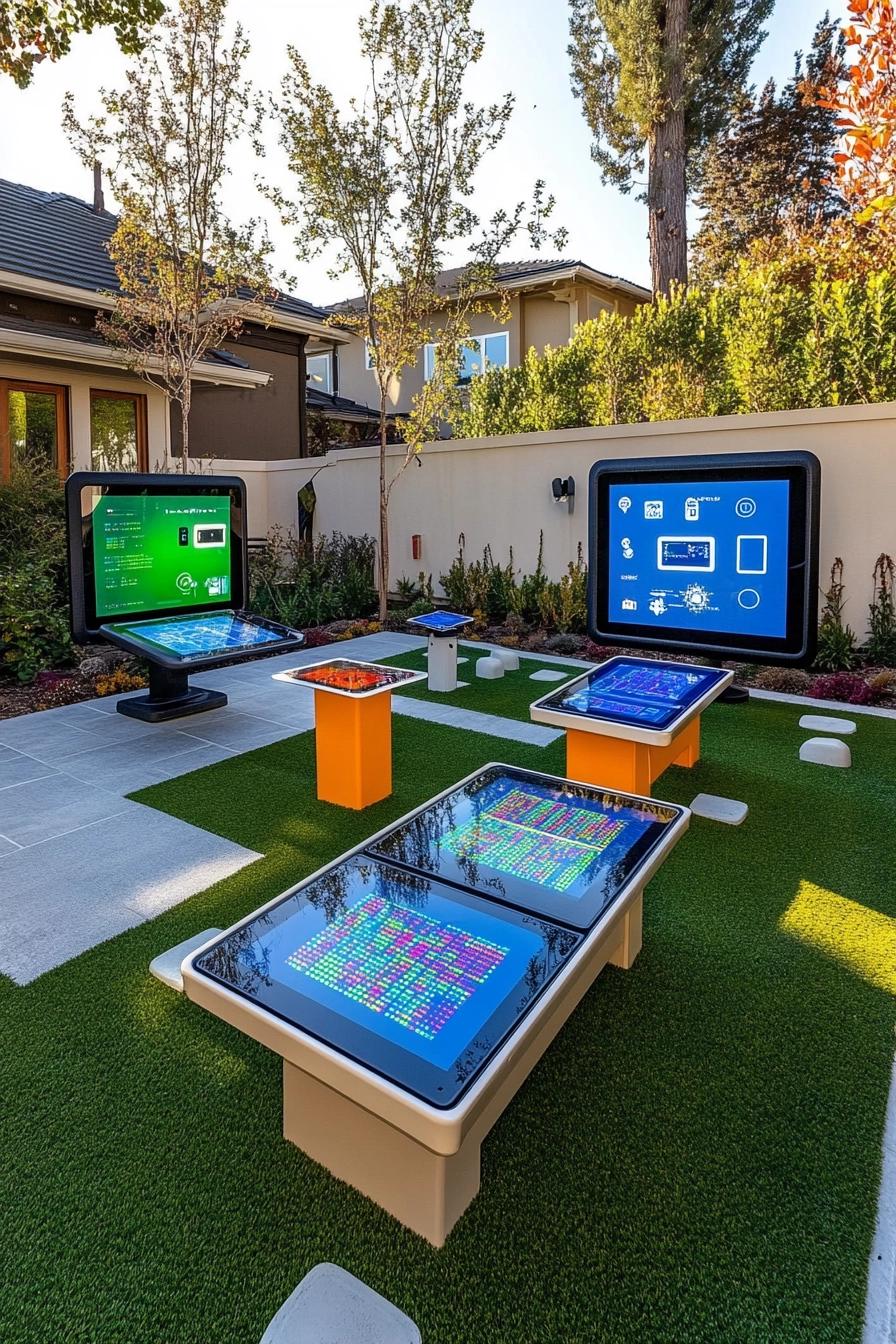
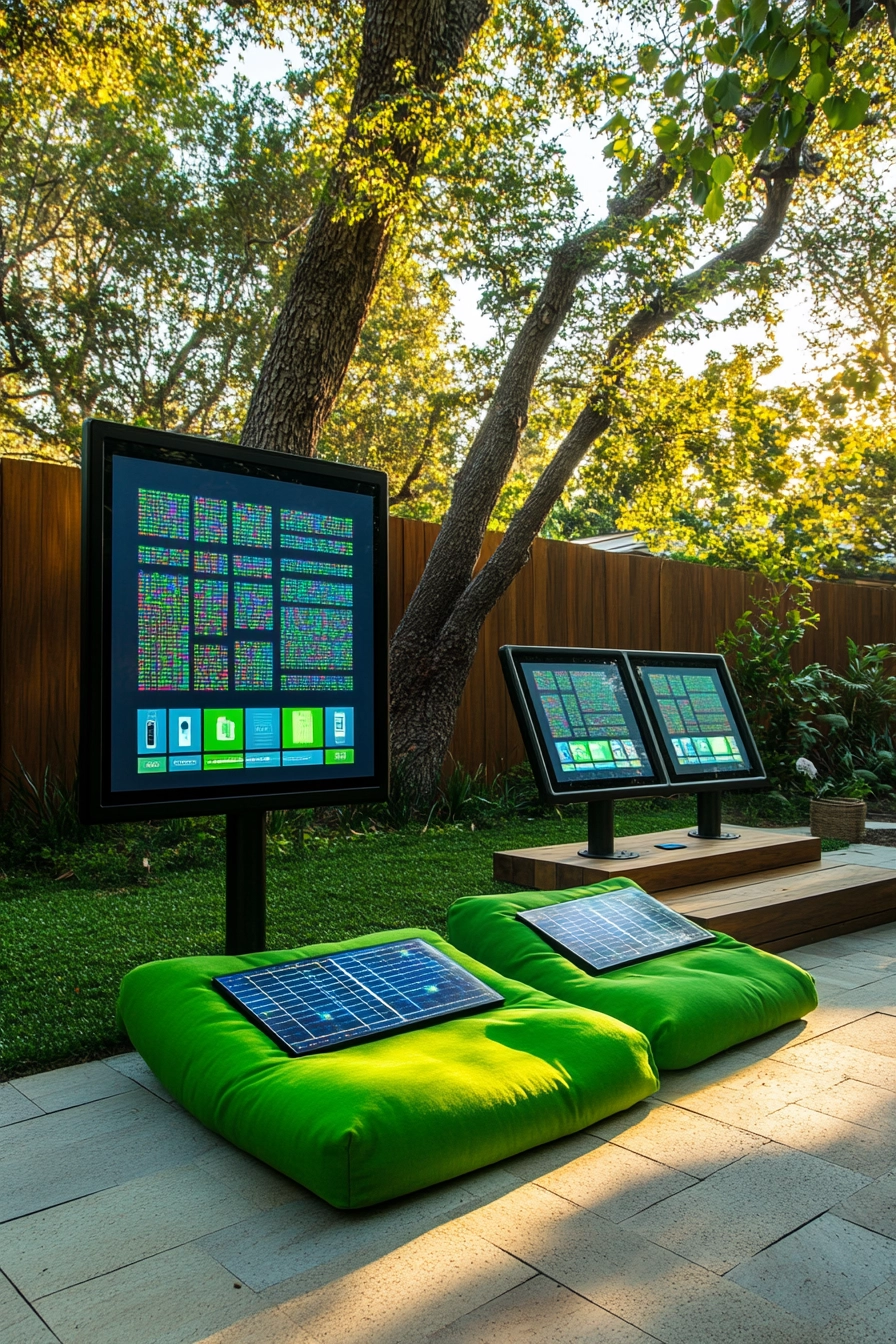
16. Compact Wildlife Observation Area
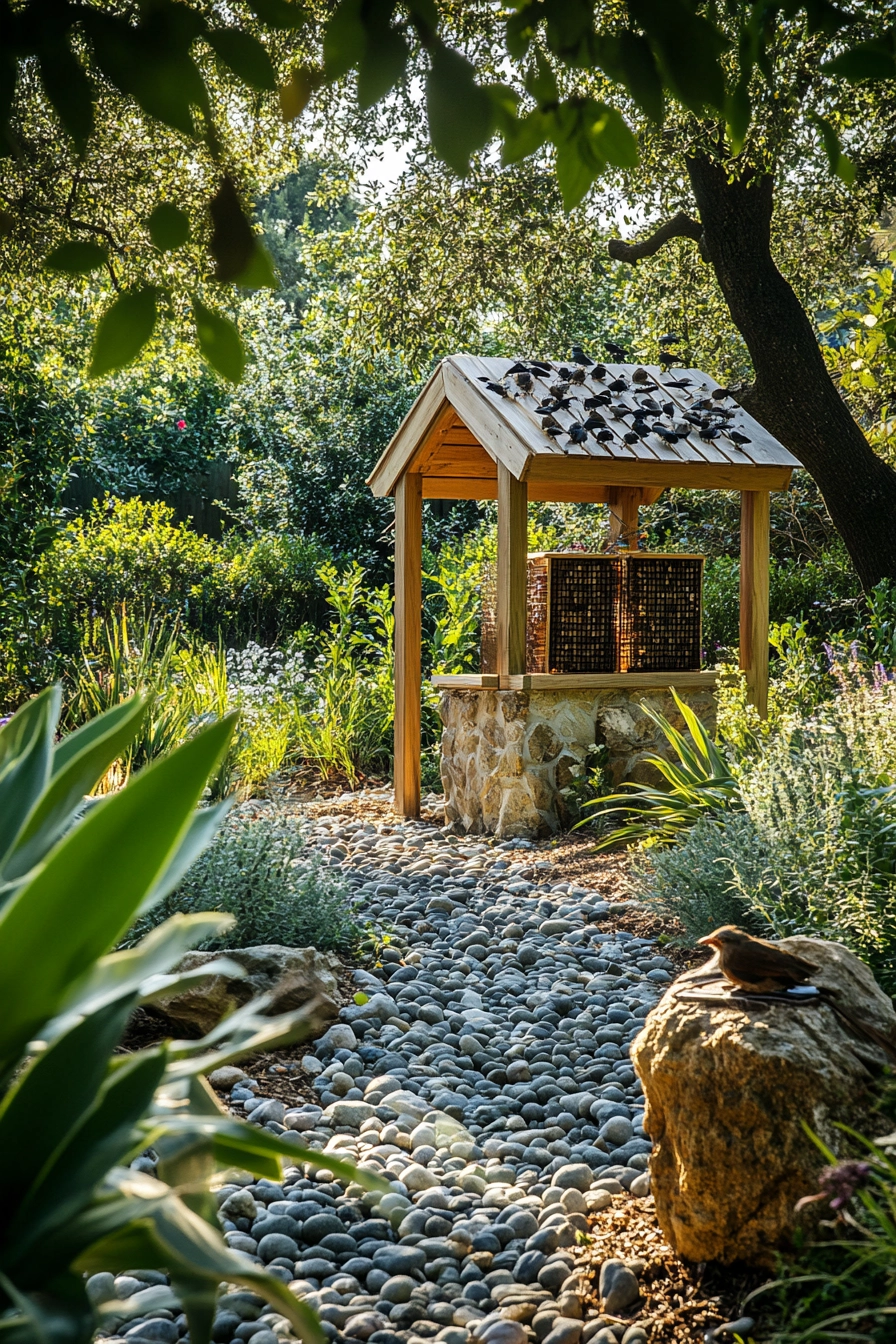
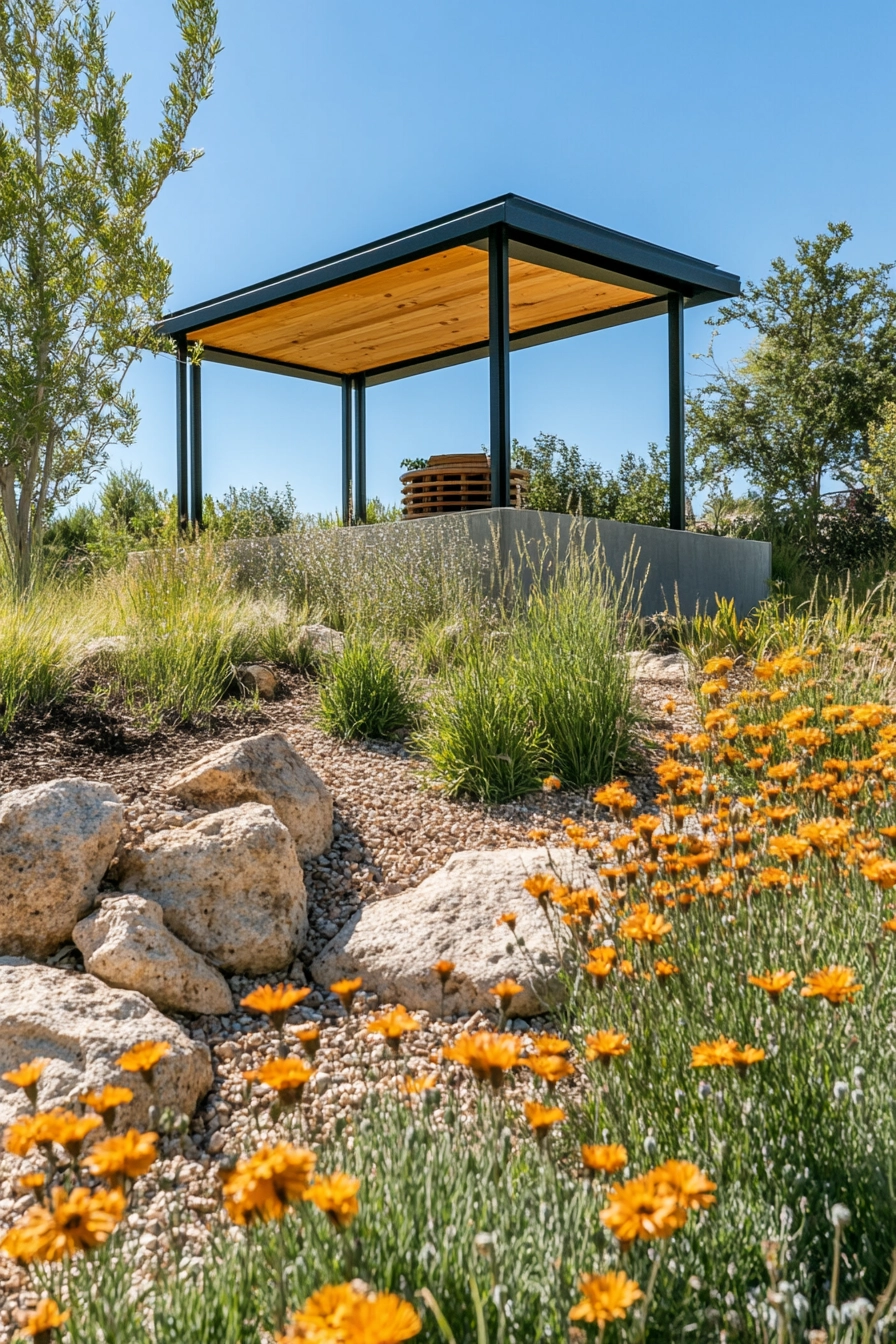
This small backyard idea focuses on creating a compact wildlife observation area that encourages children to connect with nature. Birdwatching stations, insect hotels, and native plant zones invite kids to observe and learn about local wildlife.
Educational signage enhances the learning experience, providing valuable information about the importance of biodiversity and conservation.
The sustainable design principles ensure that the area is not only functional but also environmentally friendly. This wildlife observation area serves as a living classroom, fostering an appreciation for nature and encouraging kids to become stewards of the environment.
- Incorporate bird feeders and baths to attract wildlife.
- Design educational signage that engages and informs children.
- Use native plants to create a habitat for local species.
- Plan for seating areas to encourage quiet observation.
- Incorporate interactive elements to promote hands-on learning.
Pro Design Tip: Organize nature observation days to encourage community involvement and learning.
Budget Consideration: Building birdhouses and insect hotels can be done on a budget with simple materials.
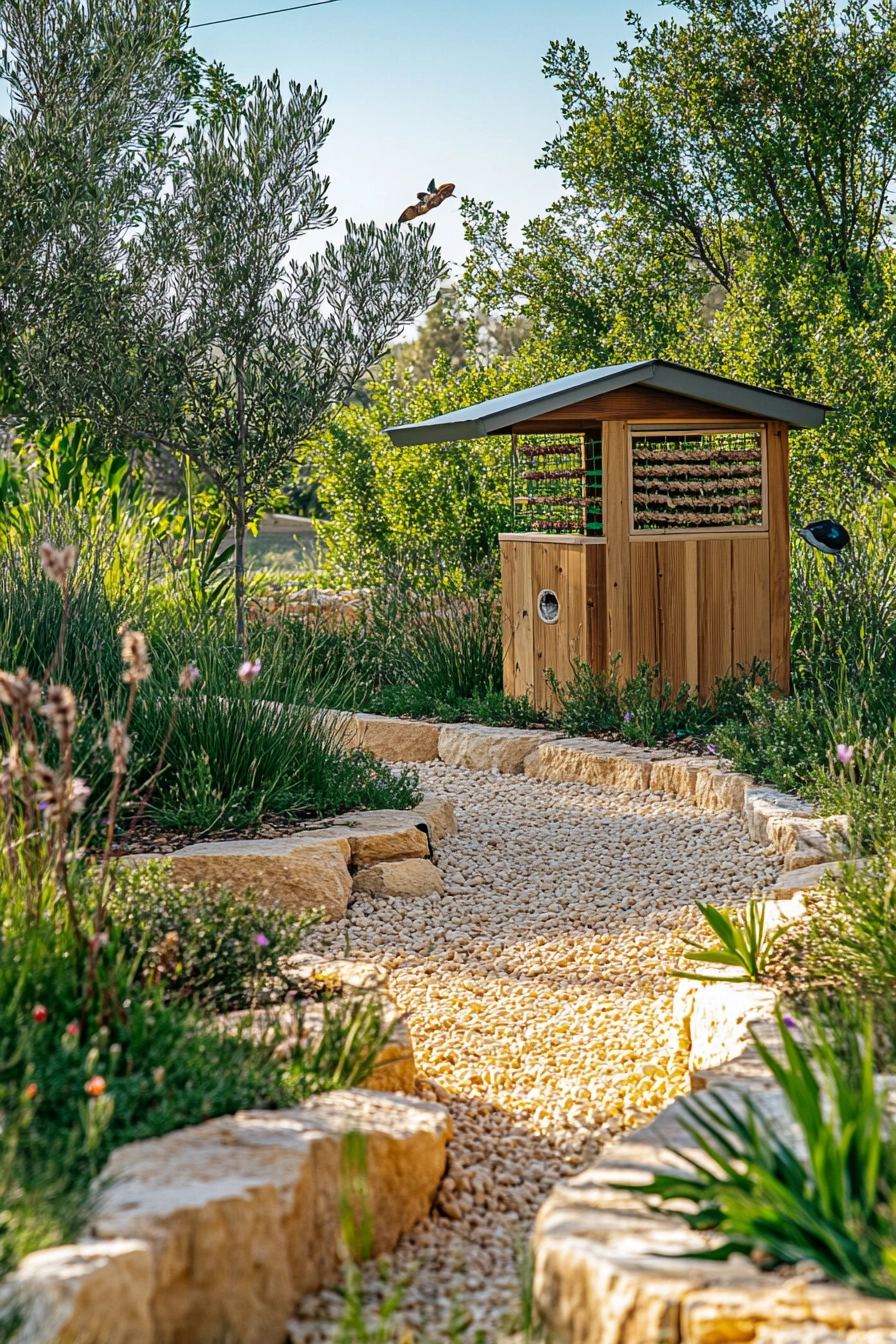
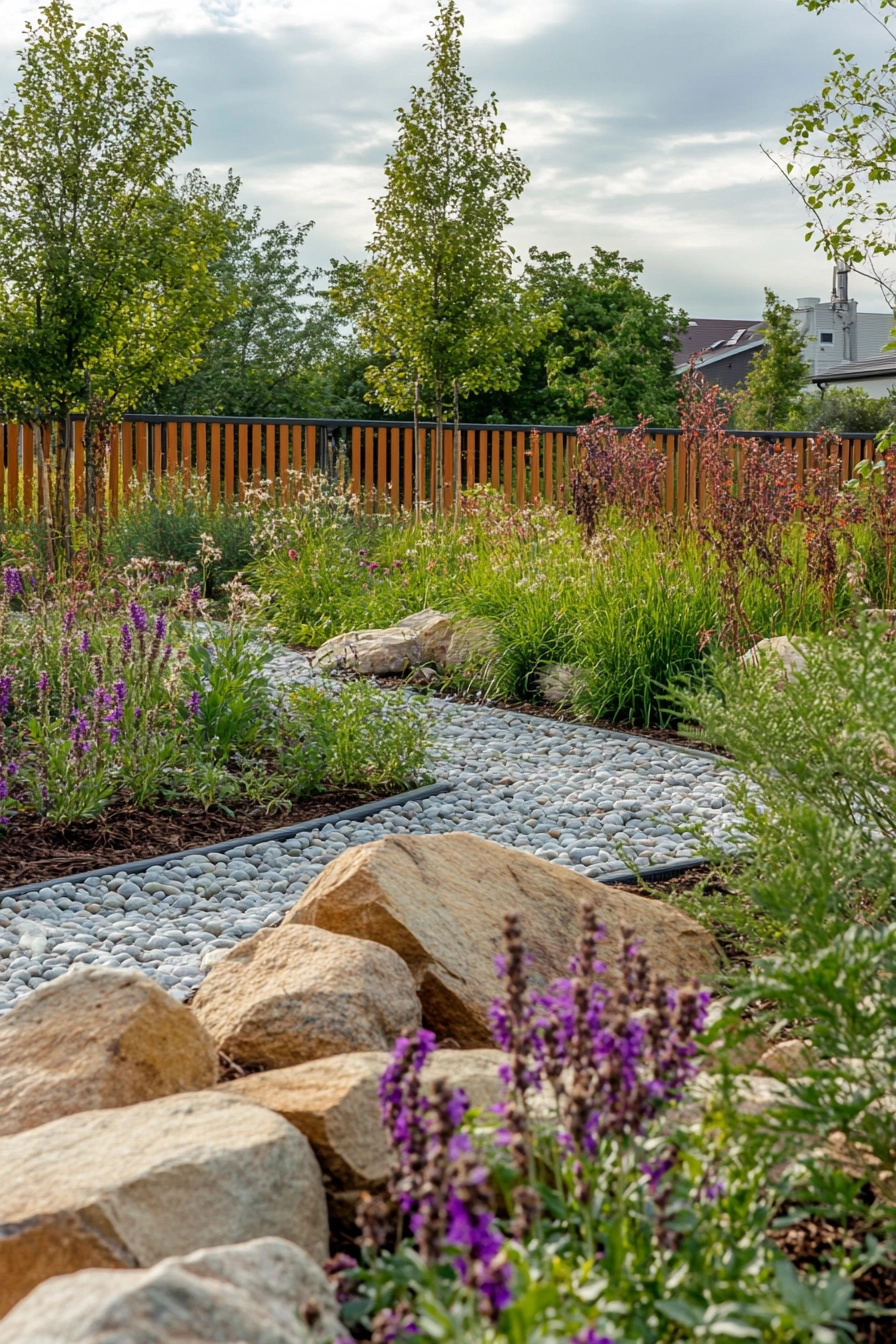
17. Adaptive Play Environment
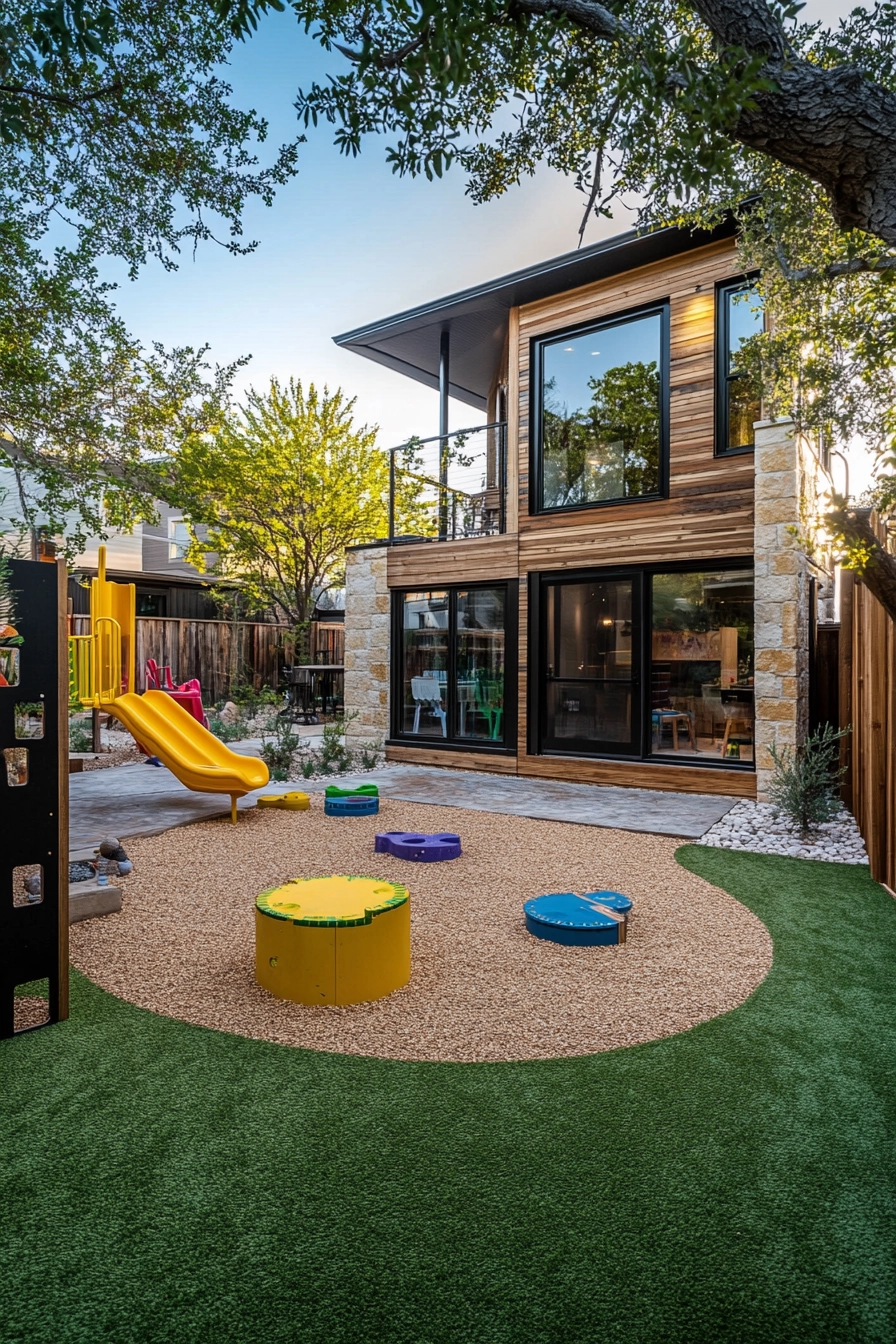
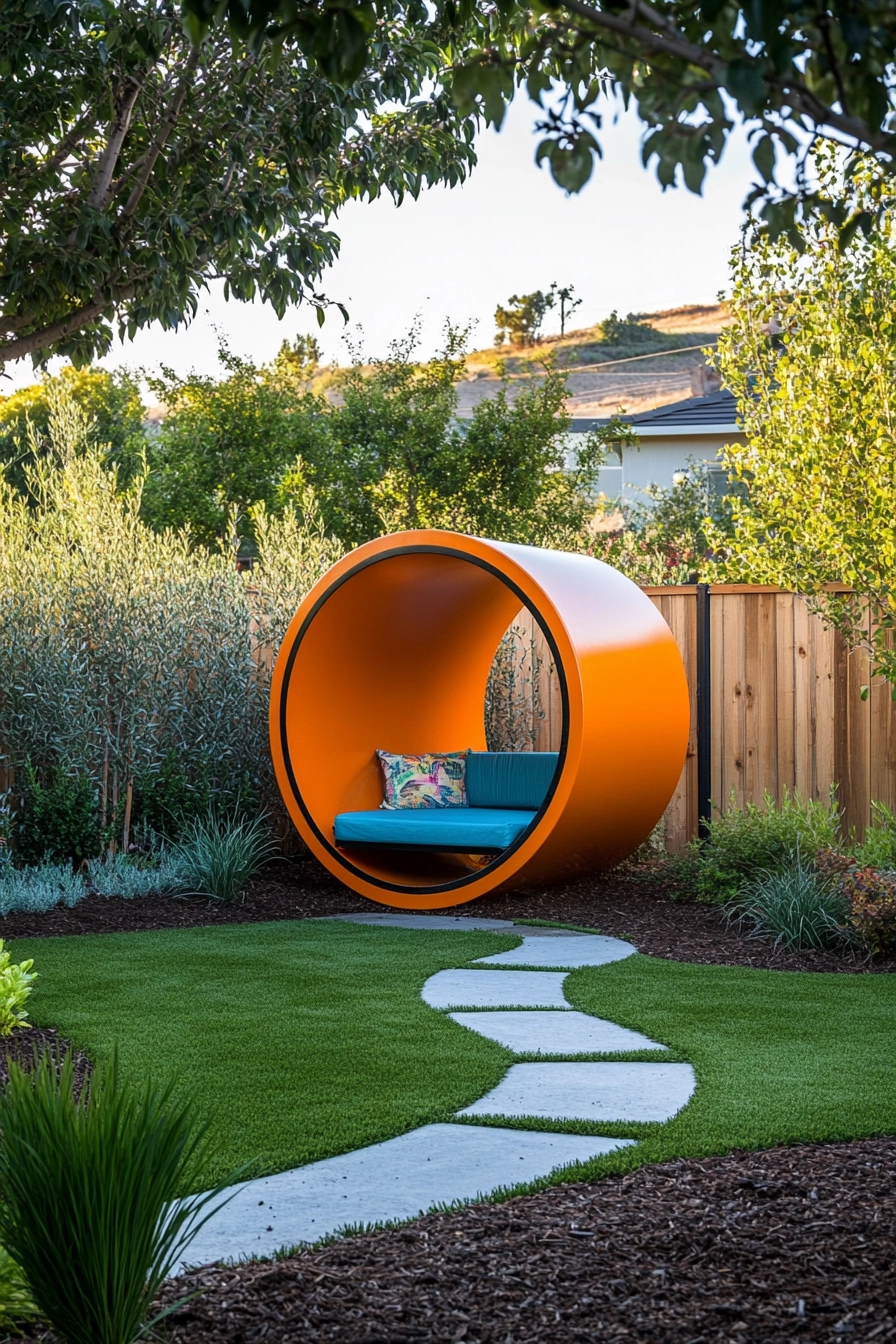
This backyard concept features an adaptive play environment designed to be inclusive for all children. Wheelchair-accessible structures, multi-sensory elements, and soft ground surfaces create a welcoming space for kids of all abilities.
The bright color scheme promotes a joyful atmosphere, ensuring that every child feels valued and included in play.
This design emphasizes the importance of inclusivity, allowing children to learn from and support each other as they play together. The architectural landscape photography perspective showcases the beauty of diversity in play, highlighting the importance of creating spaces that cater to everyone.
- Incorporate accessible pathways and structures for ease of movement.
- Design sensory play elements that engage all children.
- Use durable, weather-resistant materials for long-lasting play.
- Plan for community input to ensure the design meets diverse needs.
- Encourage collaboration between children through group activities.
Pro Design Tip: Host inclusive play days to promote community engagement and awareness.
Budget Consideration: Partner with local organizations to secure grants for adaptive play equipment.
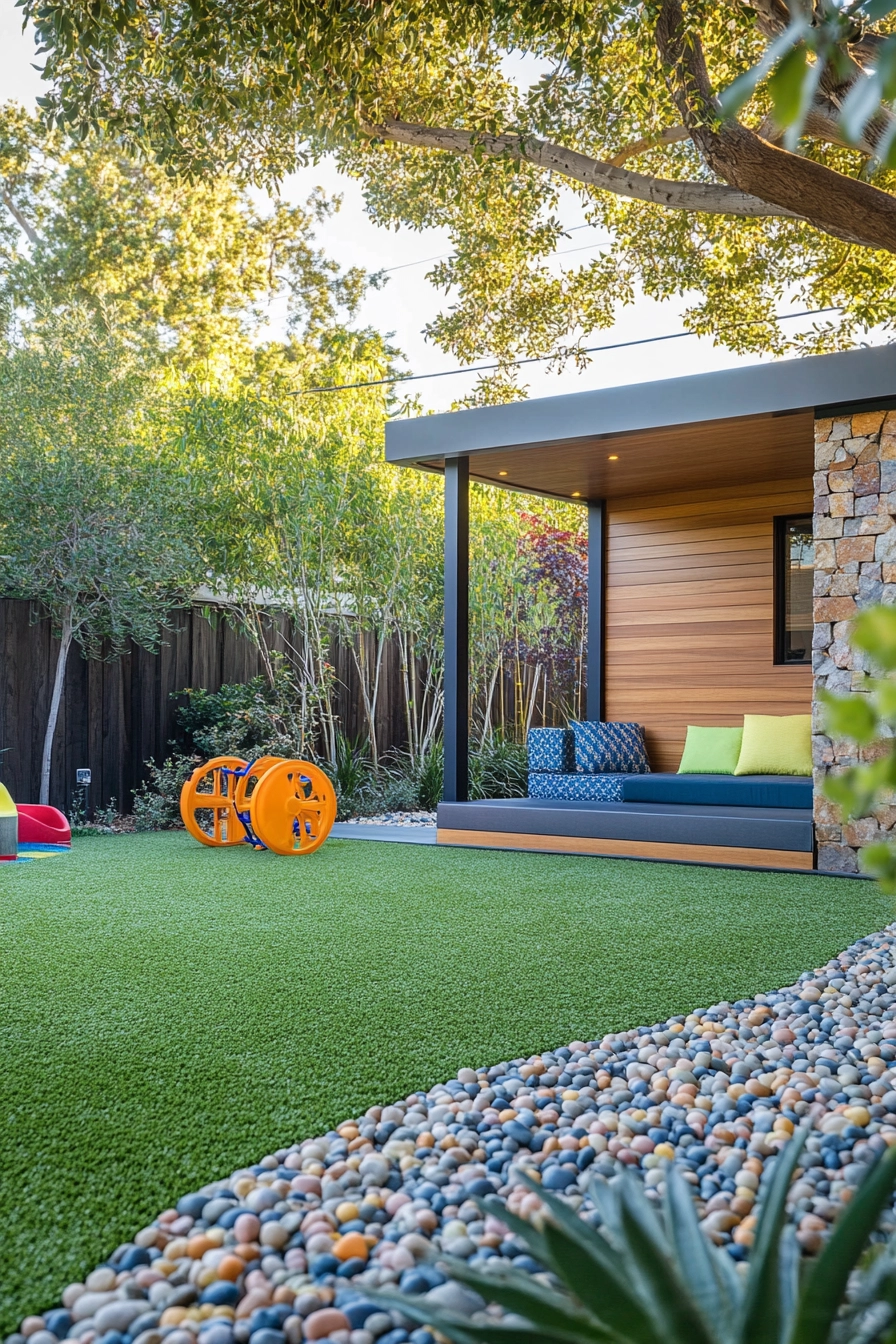
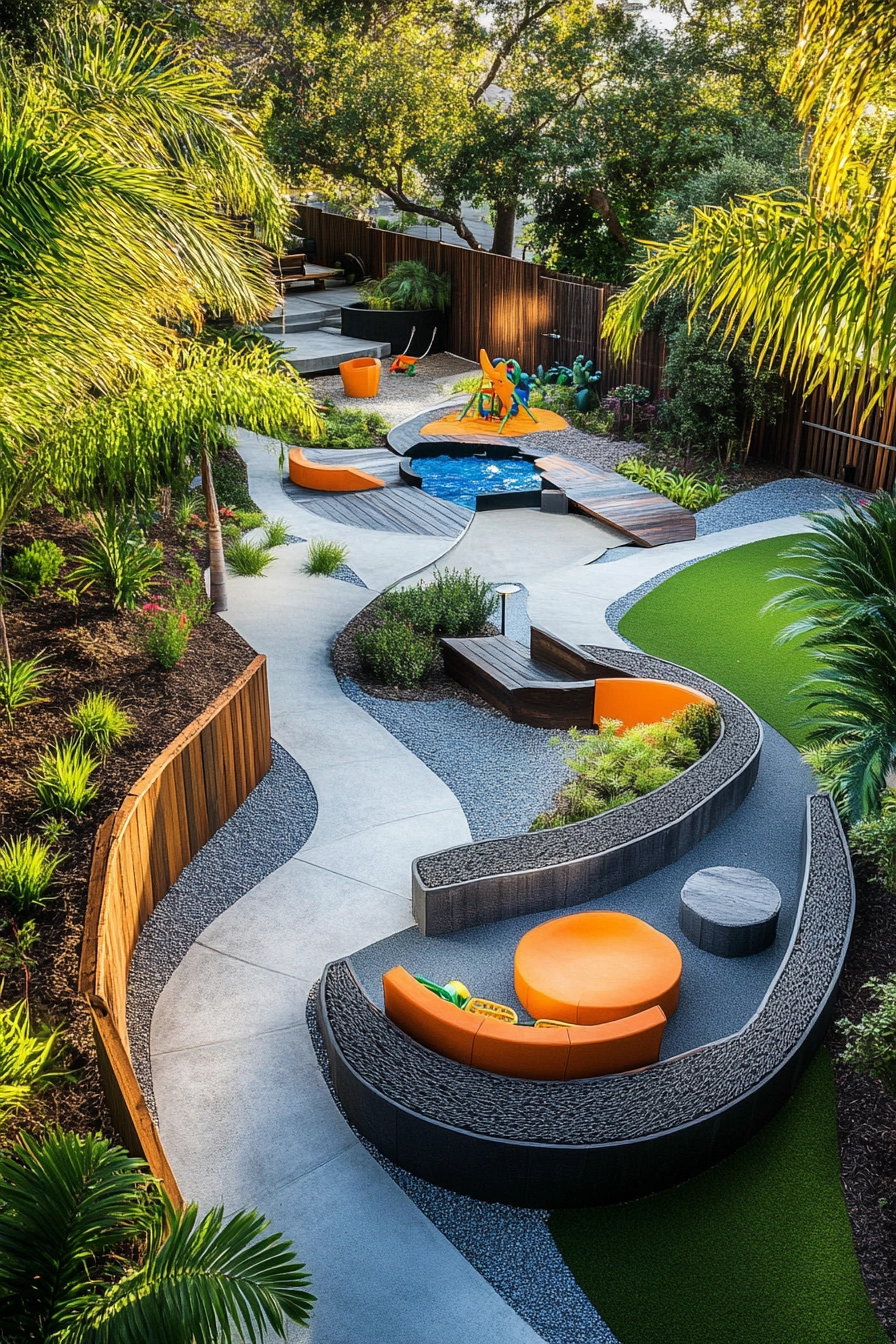
18. Compact Survival Skills Training Zone
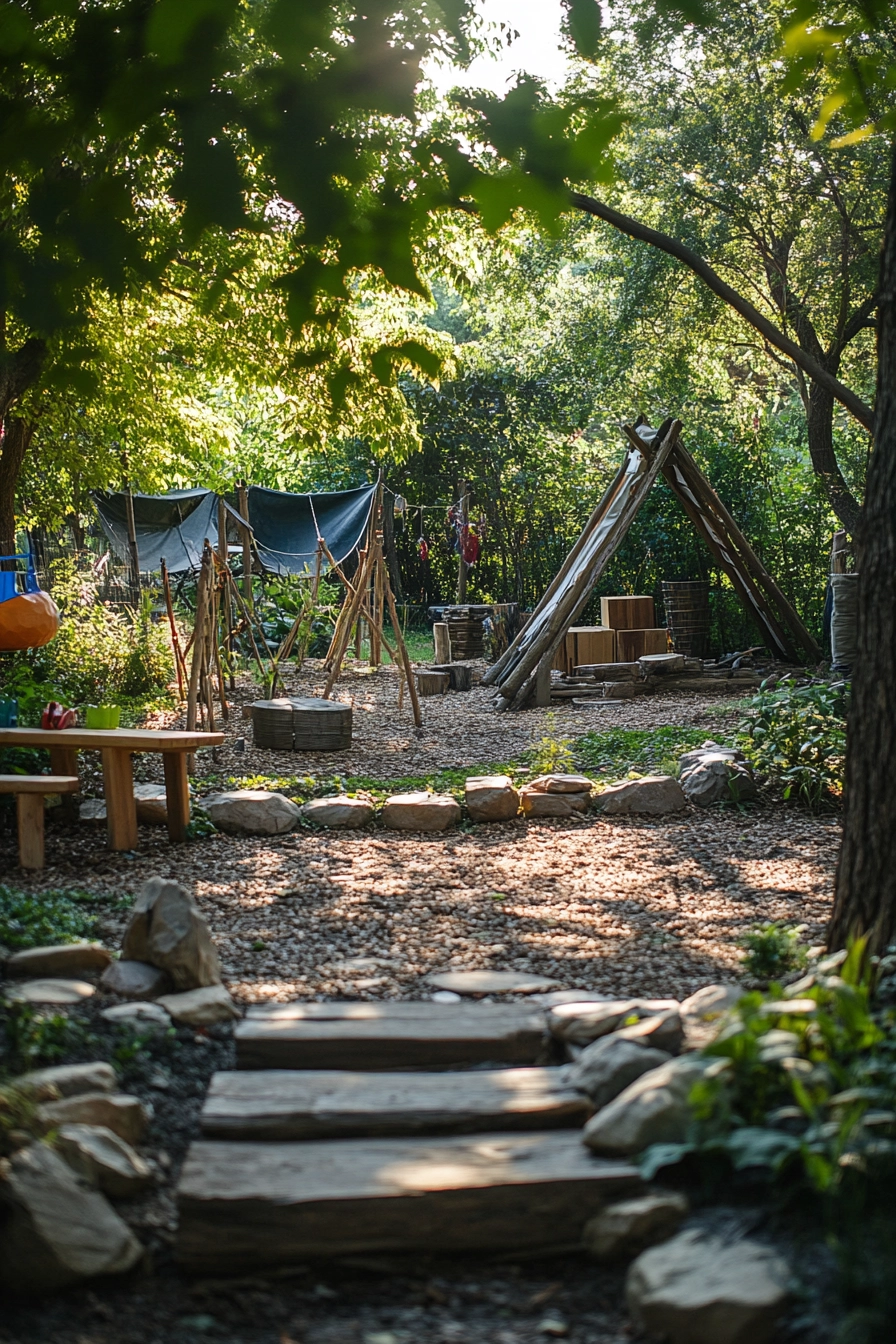
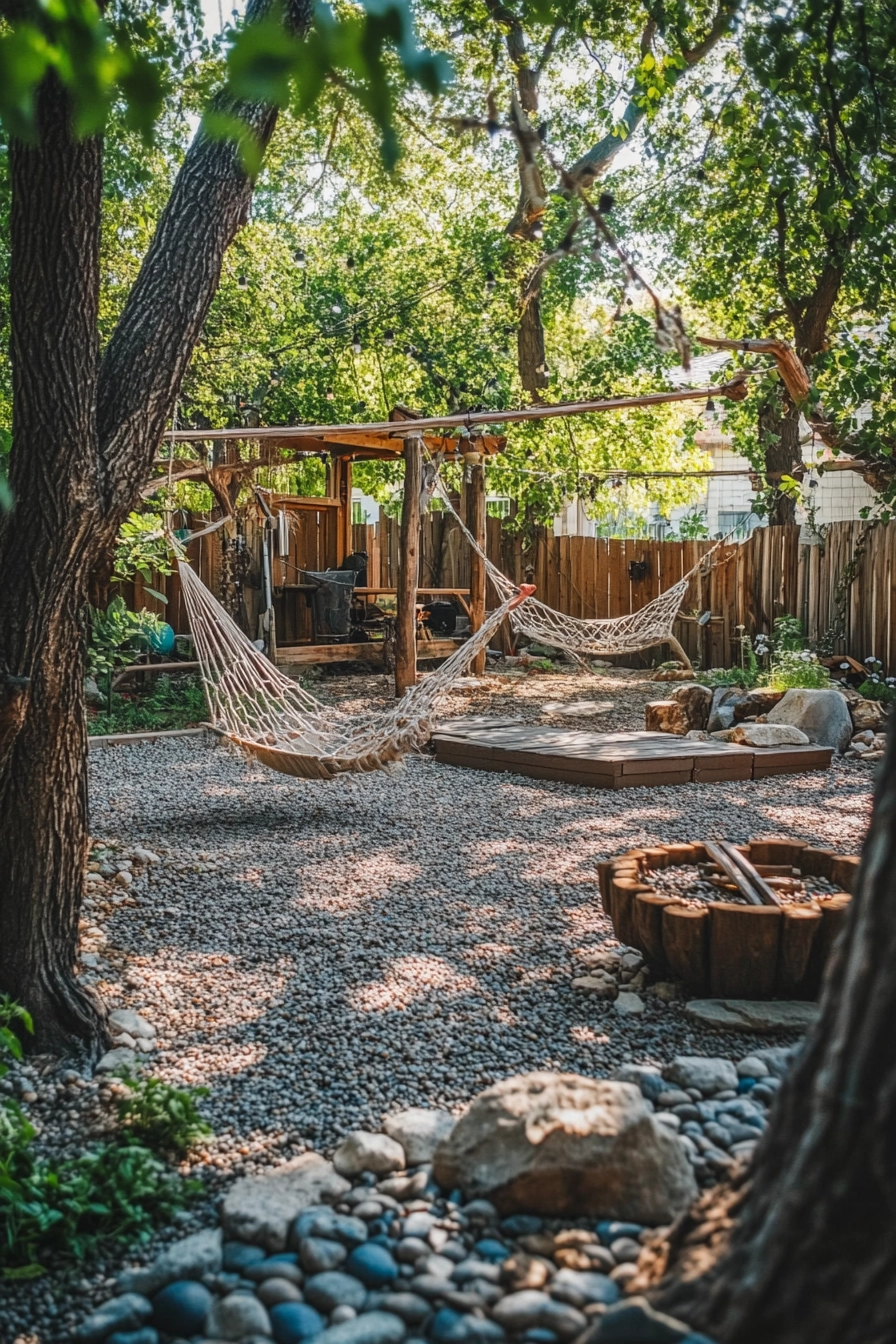
This small backyard idea focuses on creating a compact survival skills training zone that teaches children essential outdoor skills. Knot-tying stations, basic tool usage areas, and safe exploration structures provide practical learning experiences in a fun and engaging way.
The use of natural materials reinforces the connection to the outdoors while promoting hands-on learning.
This design teaches children valuable life skills while encouraging teamwork and problem-solving. The overall layout fosters a sense of adventure, making it a perfect space for kids to develop confidence and self-reliance.
- Incorporate safe tools and equipment for learning.
- Design activity areas that promote teamwork and collaboration.
- Use natural materials to enhance the outdoor experience.
- Plan for regular skill-building events to keep kids engaged.
- Encourage family involvement in learning activities.
Pro Design Tip: Organize survival skills workshops to teach kids practical outdoor knowledge.
Budget Consideration: Utilize household items and natural materials for DIY learning tools and stations.
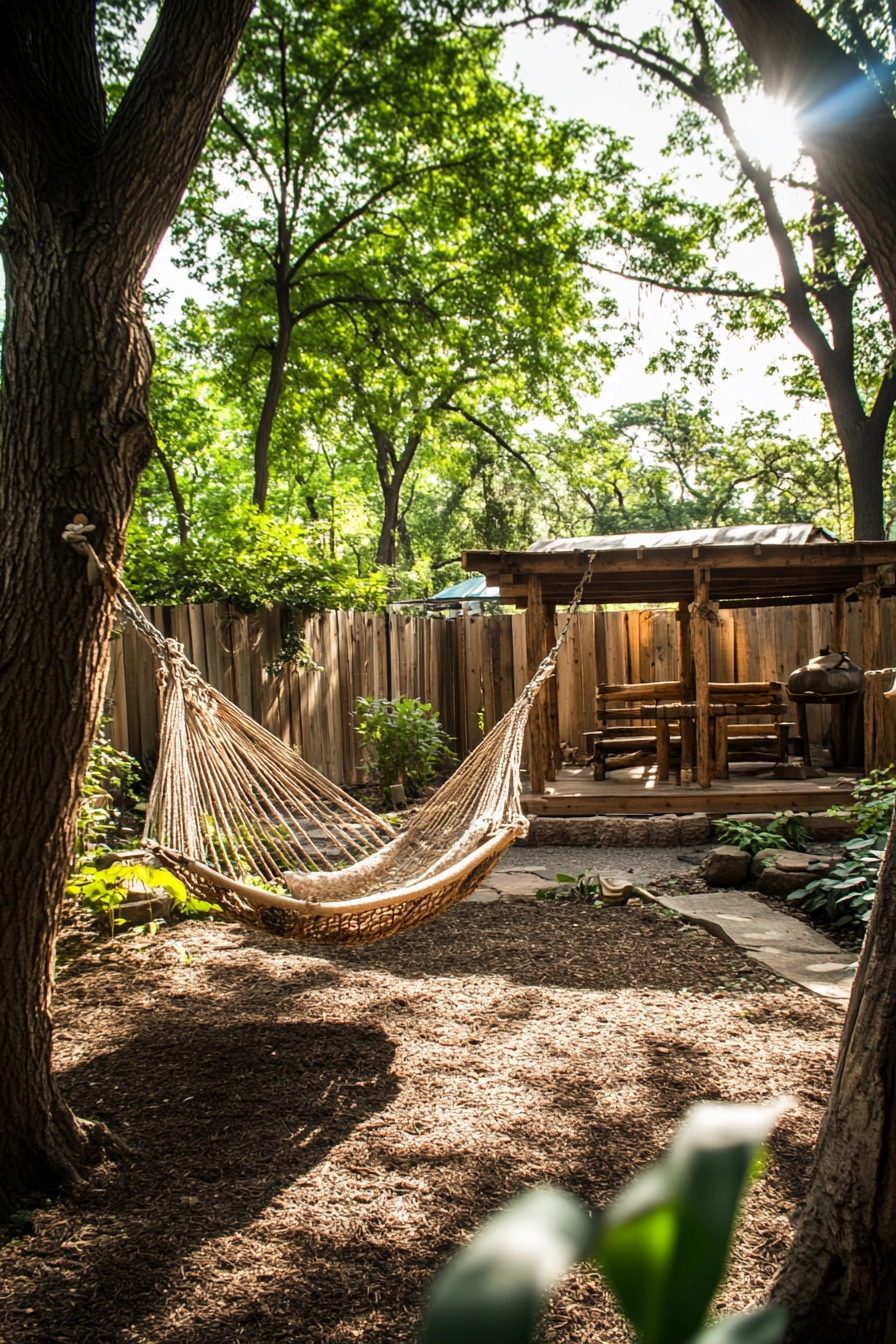
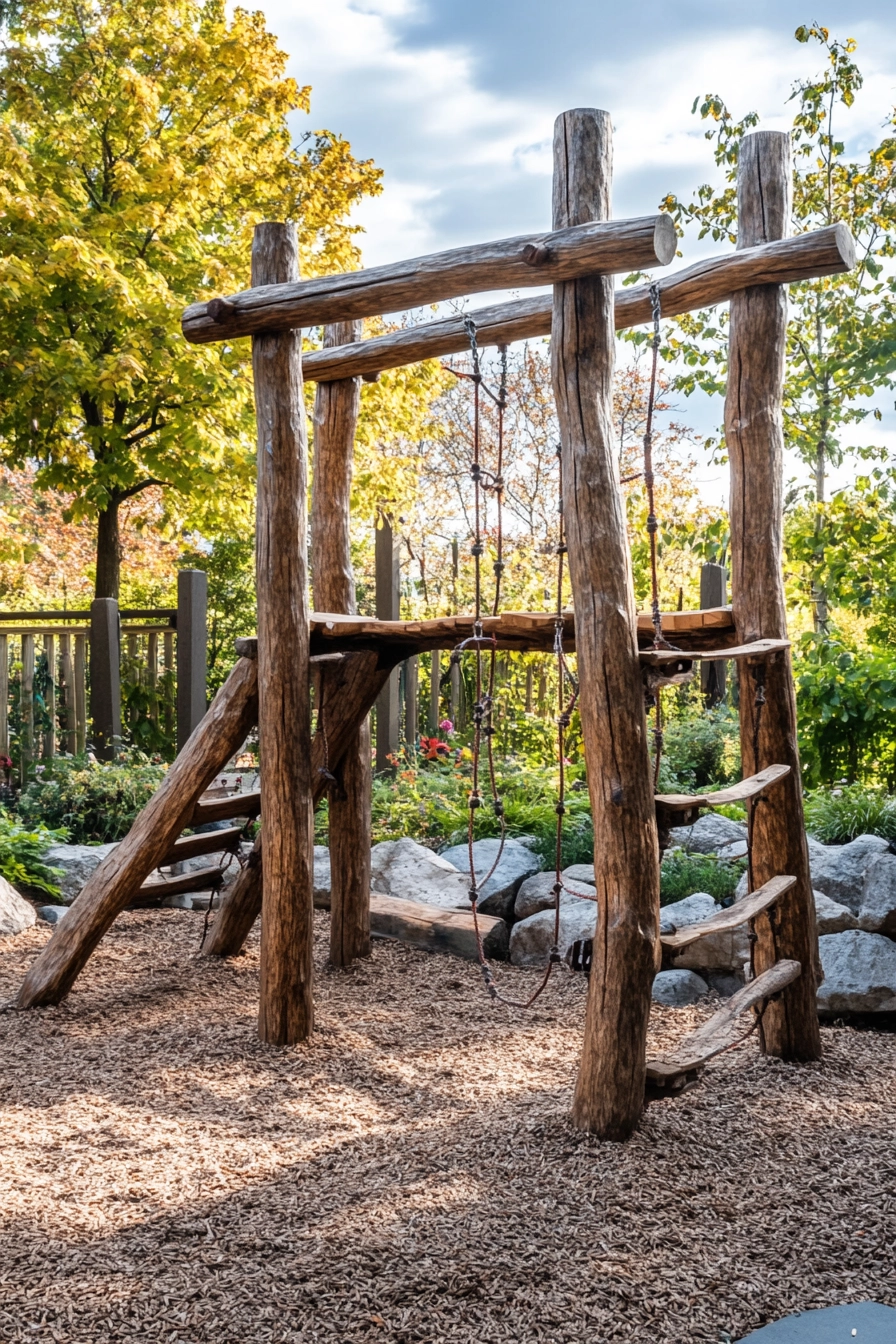
19. Compact Astronomy Observation Platform
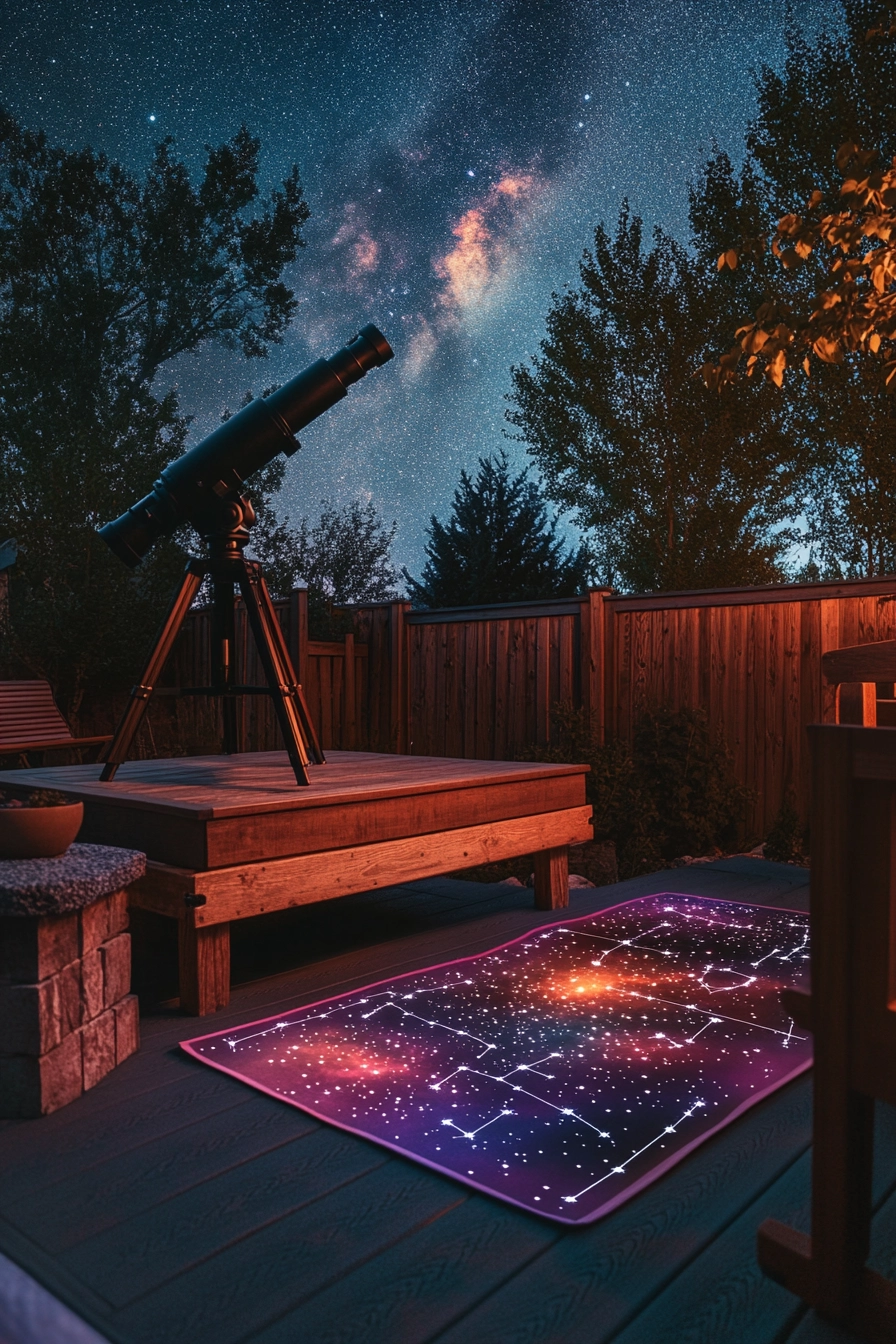
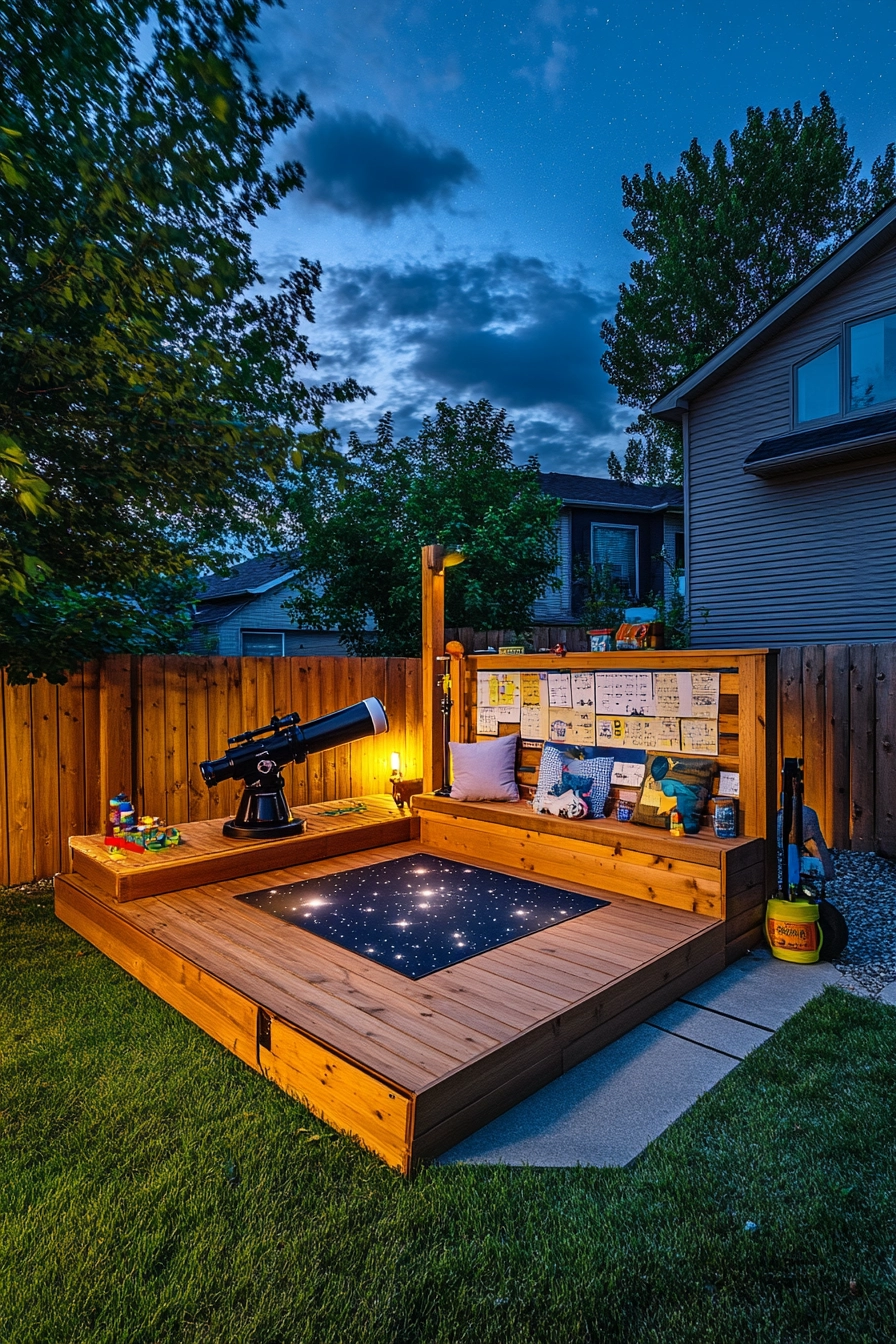
This backyard concept presents a compact astronomy observation platform that allows children to explore the wonders of the night sky. A raised deck with a dedicated telescope area, star chart installations, and soft ambient lighting create a magical atmosphere for stargazing.
The minimalist design emphasizes the beauty of the night sky, encouraging curiosity and exploration.
This space not only serves as a playground but also as an educational platform that fosters a love for science and discovery. The design encourages family bonding through shared experiences of observing celestial events, making it a valuable addition to any backyard.
- Incorporate educational materials about astronomy and space exploration.
- Design seating areas for comfortable stargazing.
- Use soft lighting to enhance the nighttime atmosphere.
- Plan for events during significant astronomical events to promote community engagement.
- Encourage kids to create their own star charts and learning materials.
Pro Design Tip: Host stargazing parties to encourage community engagement and shared learning experiences.
Budget Consideration: Purchase second-hand telescopes or educational materials to reduce costs.

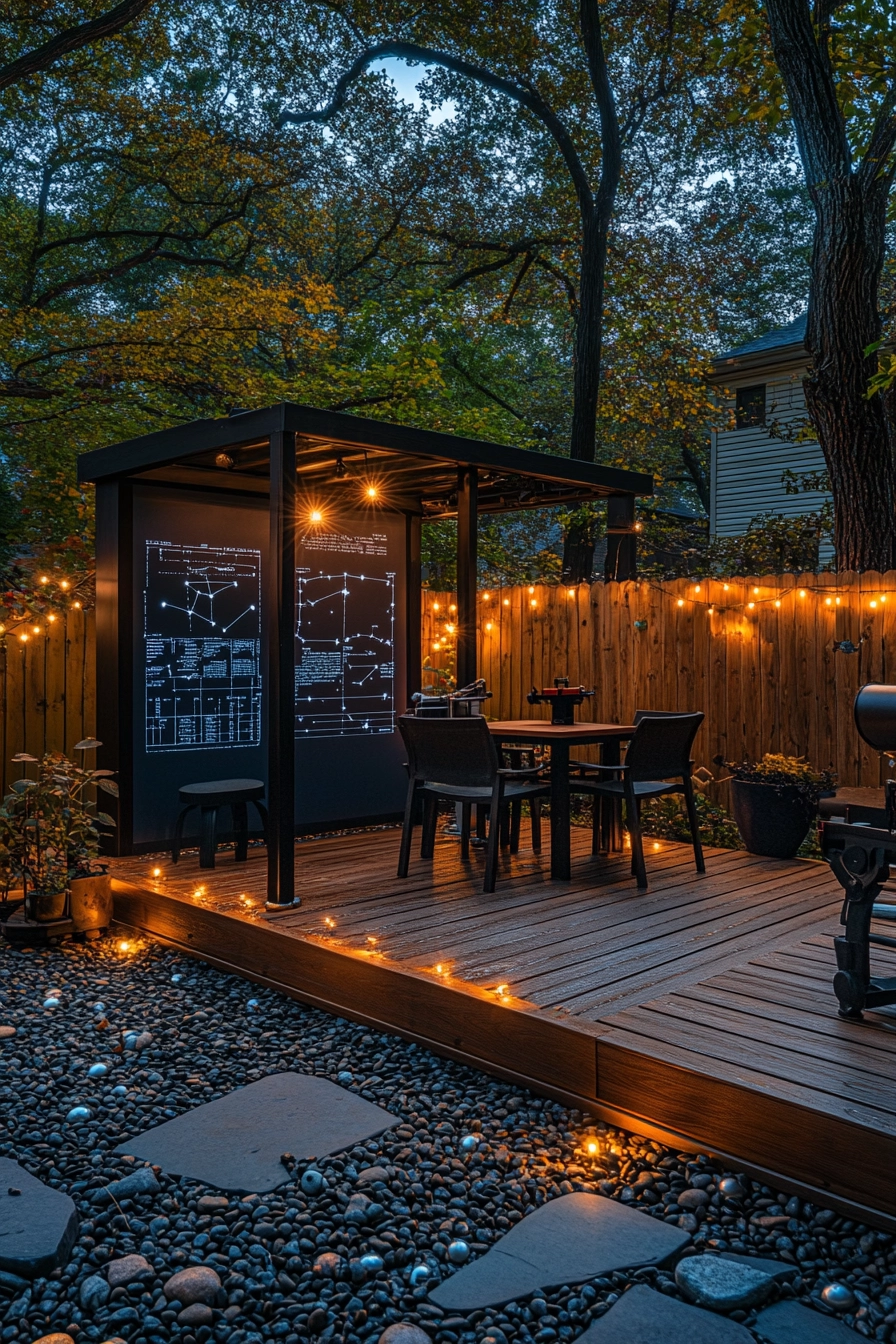
20. Compact Cultural Exploration Zone

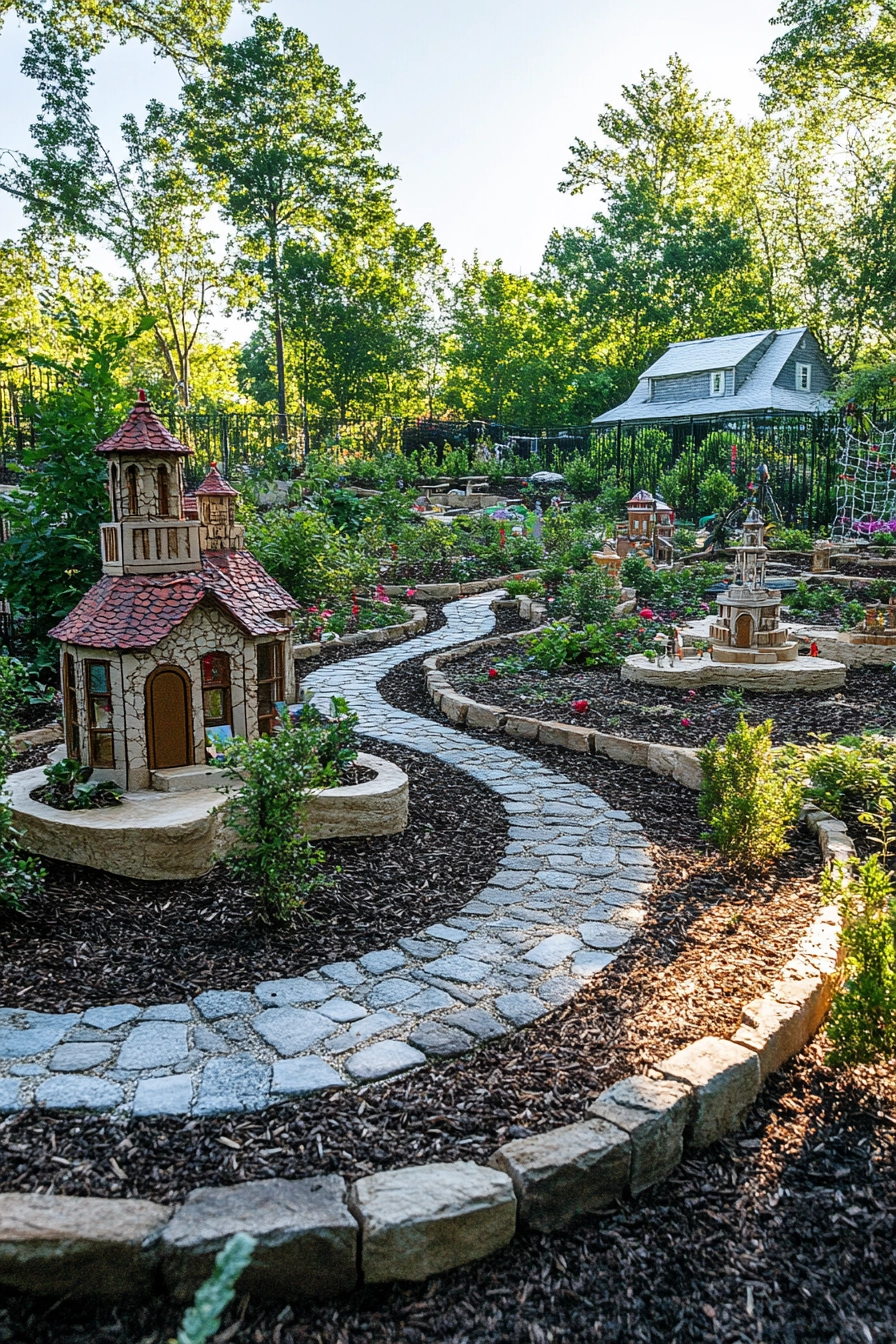
This final backyard idea features a compact cultural exploration zone designed to introduce children to diverse cultures and traditions. Miniature landmark representations and interactive cultural learning stations create an engaging environment where kids can learn about the world around them.
The diverse design elements celebrate inclusivity and promote understanding among children from different backgrounds.
This space fosters curiosity and appreciation for different cultures while providing a fun and educational experience. The professional landscape photography perspective captures the vibrancy and excitement of cultural exploration, ensuring that this zone becomes a cherished part of the backyard.
- Incorporate interactive elements that engage children in learning.
- Design spaces that encourage group activities and shared experiences.
- Use diverse materials that reflect various cultures.
- Plan for cultural events to promote community engagement.
- Encourage kids to share their own cultural backgrounds and stories.
Pro Design Tip: Host cultural exchange days to celebrate diversity and promote understanding.
Budget Consideration: Utilize local resources to create educational materials and installations that reflect diverse cultures.

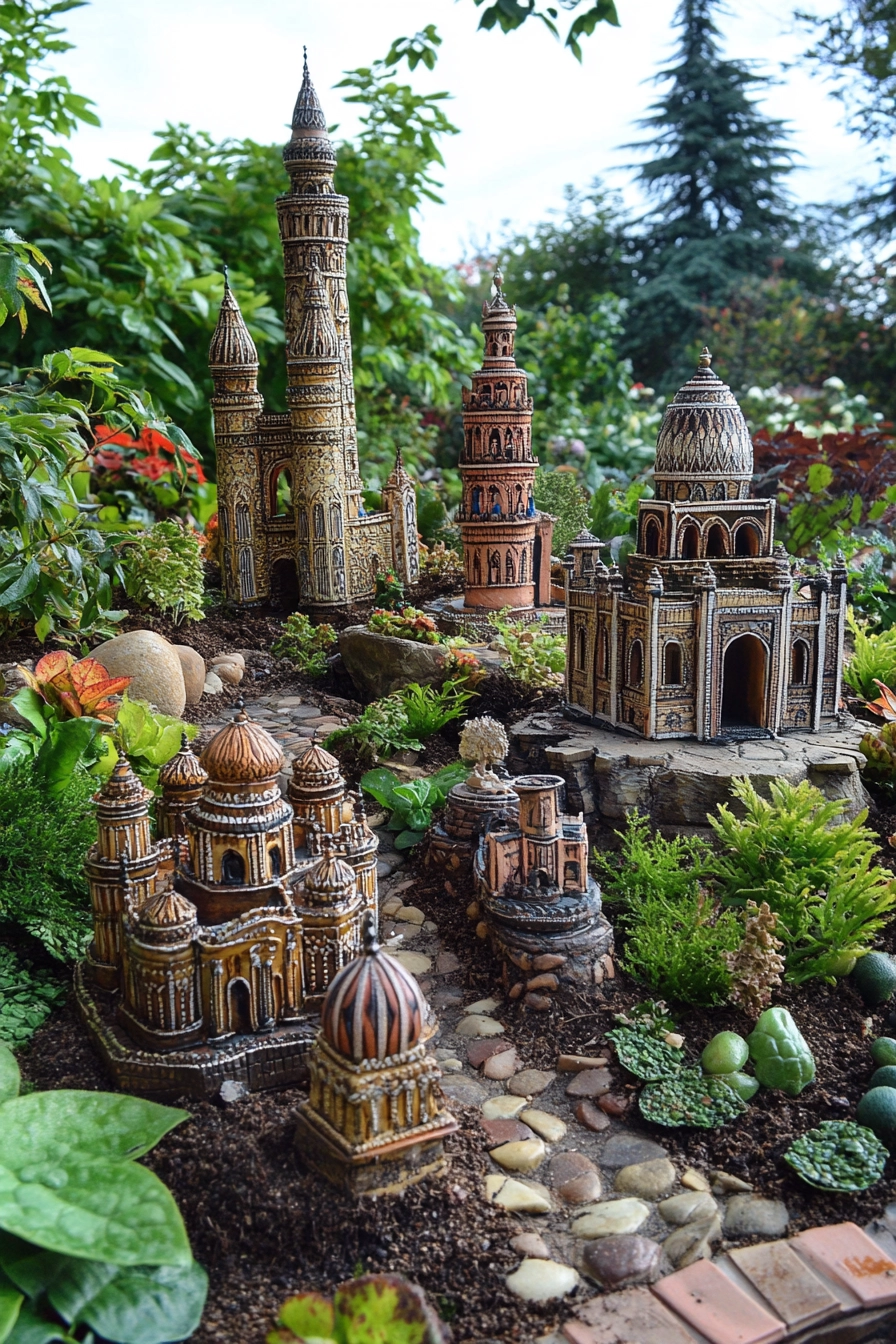
In conclusion, transforming a small backyard into a kid-friendly haven requires thoughtful design and creativity. Each of the ideas presented in this article emphasizes the importance of play, education, and nature, ensuring that children have a safe and engaging environment to thrive.
As you explore these concepts, remember to consider your family’s unique needs and preferences, allowing for a customized approach that reflects your style and fosters joyful memories for your children.



